Navigation
- Change Log
- VDA Virtual Machine Hardware
- Windows Configuration
- Install – Virtual Delivery Agent 7.15.9000 LTSR
- Install – Profile Management 7.15.7000 Hotfix 1 – security fix
- Install – VDA 7.15.6000 Security Updates
- Microsoft FSLogix – Outlook OST, OneDrive, etc.
- Browser Content Redirection add-on
- Citrix Desktop Service
- Customer Experience Improvement Program (CEIP)
- Connection Quality Indicator
- Adaptive Transport
- Slow Logons
- Change Controller Registration Port to something other than port 80
- Verify VDA Registration with Controller
- Workspace apps:
- Framehawk Configuration
- Remote Desktop Licensing Configuration
- Reduce C: Drive Permissions
- Configure Pagefile for Provisioning Services
- Direct Access Users Group – allow non-administrators to RDP to the VDA
- Enable Windows Profiles v3/v4 – Windows 2012 R2 only
- Registry Settings – black screen, published Explorer, Screen Saver, Smart Card, HTML5 Clipboard, HTML5 Upload Folder, 4K Monitors, COM Ports
- Restore Legacy Client Drive Mapping
- Print Driver for Mac and Linux Clients
- HTML5 Workspace app – SSL for VDA
- Anonymous Accounts
- Antivirus
- Optimize Performance
- Seal and Shut Down
- Troubleshooting – Graphics
- Uninstall VDA
💡 = Recently Updated
Change Log
- 2022 July 9 – updated Install VDA and VDA Port section screenshots for 7.15.9000 (Cumulative Update 9)
- 2021 Aug 11 – updated Install VDA and VDA Port section screenshots for 7.15.8000 (Cumulative Update 8)
- 2021 July 13 – Profile Management 7.15.7000 Hotfix 1 – security fix
- 2021 Feb 9 – updated Install VDA and VDA Port section screenshots for 7.15.7000 (Cumulative Update 7)
- 2021 Jan 29 – 7.15.6000 Security Updates – updated for Hotfix 6005
- 2020 Nov 10 – 7.15.6000 Security Updates
- 2020 Jun 30 – updated Install VDA and VDA Port section screenshots for 7.15.6000 (Cumulative Update 6)
- 2019 Nov 16 – Optimize Performance – added link to Citrix Blog Post Citrix Optimizer 2.6 – What’s new.
- 2019 Nov 9 – Browser Content Redirection – ADMX GPO template updated in November 2019
- 2019 Oct 23 – updated Install VDA and VDA Port section screenshots for 7.15.5000 (Cumulative Update 5)
- 2019 Aug 30 – upgrade LTSR Receiver to version 4.9.8000
- 2019 Aug 15 – Slow Logons – added warning from Citrix Policies aren’t reapply / refreshed during Reconnect at Citrix Discussions.
- 2019 Jun 22 – upgrade LTSR Receiver to version 4.9.7000
- 2019 May 11 – Optimize Performance – added link to Microsoft Docs Optimizing Windows 10, version 1803, for a Virtual Desktop Infrastructure (VDI) role
- 2019 Apr 23 – updated Install VDA and VDA Port section screenshots for 7.15.4000 (Cumulative Update 4)
- 2019 Mar 4 – Desktop Helper – added link to Jeremy Saunders Controlling the Starting of the Citrix Desktop Service (BrokerAgent)
Hardware
Hypervisor Host Hardware
- Citrix Blog Post Citrix Scalability — The Rule of 5 and 10: Simply take the number of physical cores in a hypervisor host, multiply it by 5 or 10, and the result will be your Single Server Scalability. Use 5 if you’re looking for the number of XenDesktop VMs you can host on a box, and use 10 if you’re looking for the number of XenApp user sessions you can host on a box.
Virtual Machine Hardware
- Hypervisor Support – CTX131239 Supported Hypervisors for XenDesktop and Provisioning Services
- 7.15 LTSR Cumulative Update 3 (but not Cumulative Update 2) supports vSphere 6.7 Update 1
- VDA virtual machine sizing:
- For virtual desktops, give the virtual machine: 2+ vCPU and 2+ GB of RAM
- For Windows 2008 R2 RDSH, give the virtual machine 4 vCPU and 12-24 GB of RAM
- For Windows 2012 R2 RDSH, give the virtual machine 8 vCPU, and 24-48 GB of RAM
- See Daniel Feller Sizing Windows 2016, Windows 2012 And Windows 10 Virtual Machines
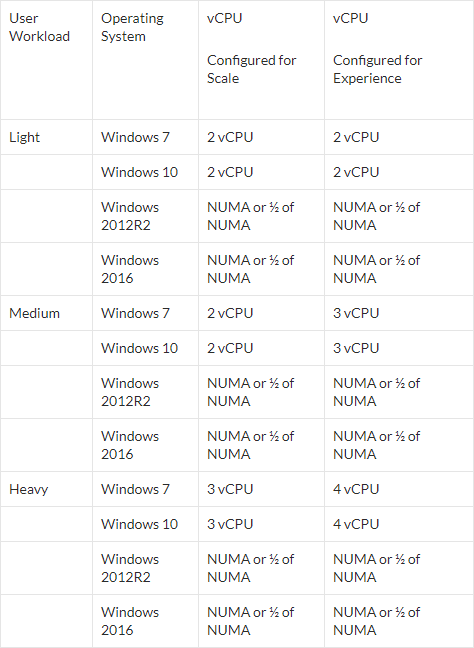
- If using RAM caching (MCSIO or PvS), add more RAM for the cache
- Remove the floppy drive
- Remove any serial or LPT ports
- If vSphere:
- To reduce disk space, reserve memory. Memory reservations reduce or eliminate the virtual machine .vswp file.
- The NIC should be VMXNET3.
- For vGPU, if vSphere 6.7 Update 1 and 7.15 LTSR CU3, set vgpu.hotmigrate.enabled Advanced vCenter Server Setting to true. (source = William Lam How to enable vGPU vMotion in vSphere 6.7 Update 1)
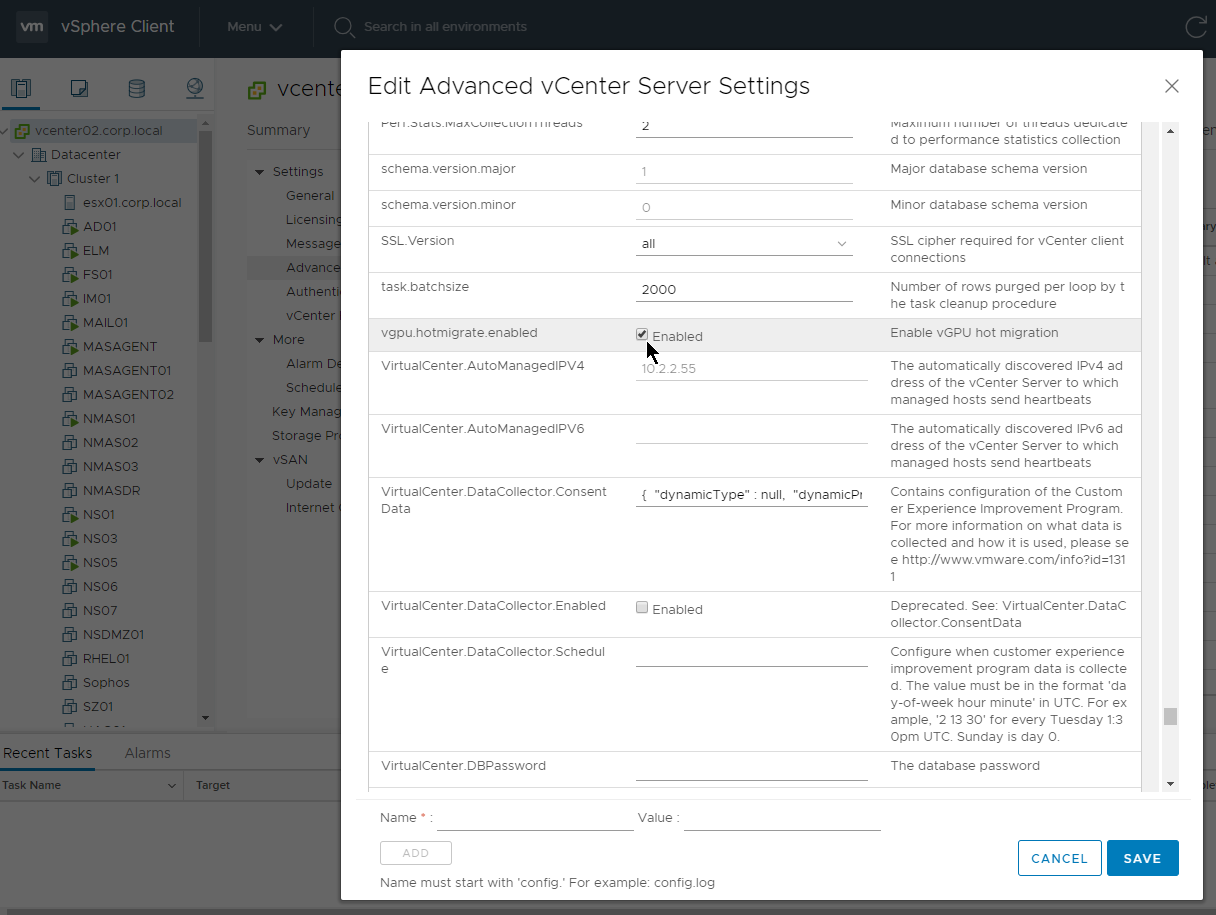
- If this VDA will boot from Provisioning Services:
- For vSphere, the NIC must be VMXNET3.
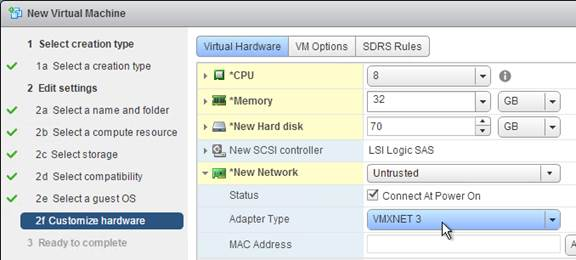
- For vSphere, configure the CD-ROM to boot from IDE instead of SATA. SATA comes with VM hardware version 10. SATA won’t work with PvS.
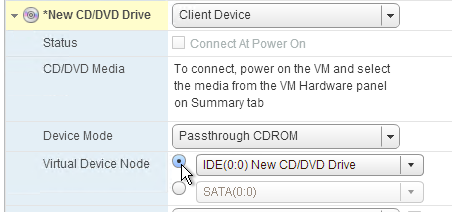
- For vSphere, the NIC must be VMXNET3.
- For Windows 10 – see CTX224843 Windows 10 compatibility with Citrix XenDesktop
- Citrix provides partial support for Semi-Annual Channel Targeted (aka Current Branch) versions of Windows 10
- Citrix provides full support for Semi-Annual Channel (Broad) (aka Current Branch for Business) versions of Windows 10, starting with the VDA version released after a Windows 10 version is designated as Broad (typically 4 monthly patches after initial release).
- Windows 10 1703 Broad is supported by VDA 7.15, since VDA 7.15 was released after Windows 10 1703 was designated as Broad (after four monthly Windows patches).
- Windows 10 1709 Targeted: Citrix Product Manager in the comments mentioned that 7.15 will support 1709. Citrix has a live article about all this: CTX229052. The Microsoft patches required for 1709 will come out in 2 dates:
- Nov 14th (Patch Tuesday KB4051314) will allow you to upgrade from 1703 and older with a VDA already installed, to 1709.
- ’11D’ patch (last week of November via Microsoft Update Catalogue) will allow you to do a fresh new VDA install on top of 1709.
- It’s possible that LTSR 7.15 Cumulative Updates will support newer versions of Windows 10.
- Install the latest version of hypervisor drivers (e.g. VMware Tools).
- If Windows 7 on vSphere, don’t install the VMware SVGA driver. For more details, see Citrix CTX201804 Intermittent Connection Failures/Black Screen Issues When Connecting from Multi-Monitor Client Machines to Windows 7 VDA with VDA 7.x on vSphere/ESXi.
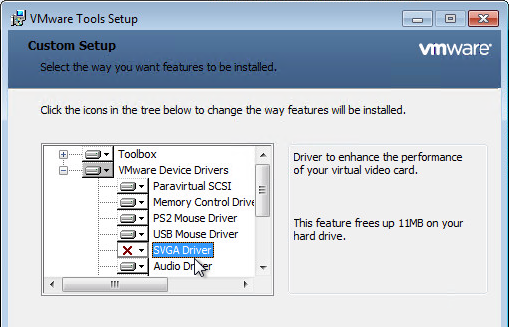
- If Windows 7 on vSphere, don’t install the VMware SVGA driver. For more details, see Citrix CTX201804 Intermittent Connection Failures/Black Screen Issues When Connecting from Multi-Monitor Client Machines to Windows 7 VDA with VDA 7.x on vSphere/ESXi.
- The vSphere Activity Monitoring Feature with NSX Guest Introspection feature uses a TDI driver (vnetflt.sys), which might cause a “Connection Interrupted” message when users log off of Citrix. See VMware 2121307 Windows virtual machines using the vShield Endpoint TDI Manager or NSX Network Introspection Driver (vnetflt.sys) driver fails with a blue diagnostic screen and XenDesktop 7.12 logoff: Connection interrupted at Citrix Discussions.

If vSphere, disable NIC Hotplug
- Users could use the systray icon to Eject the Ethernet Controller. Obviously this is bad.
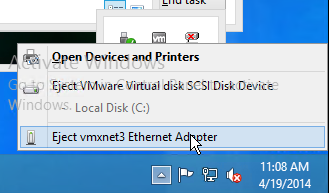
- To disable this functionality, power off the virtual machine.
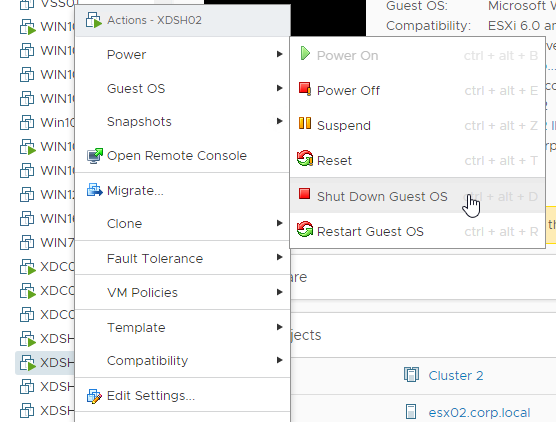
- Once powered off, right-click the virtual machine, and click Edit Settings.
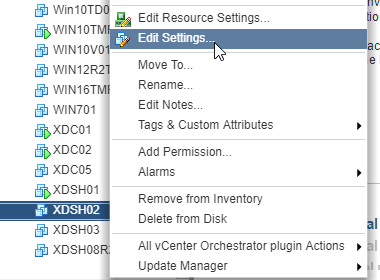
- On the VM Options tab, expand Advanced, and then click Edit Configuration.
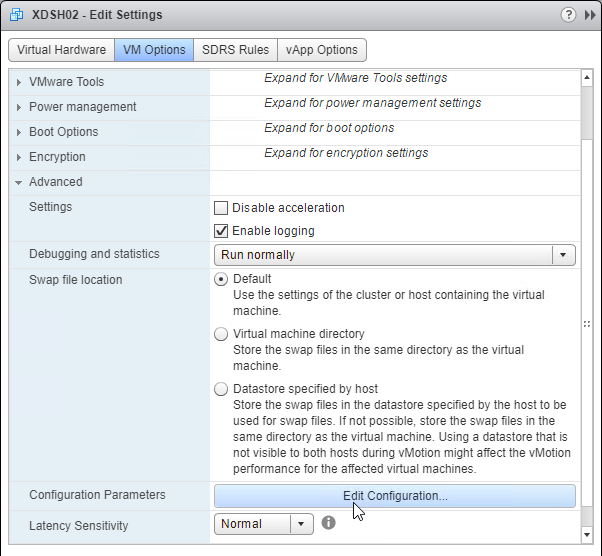
- On the bottom left, enter devices.hotplug. On the right, enter false. Then click Add.
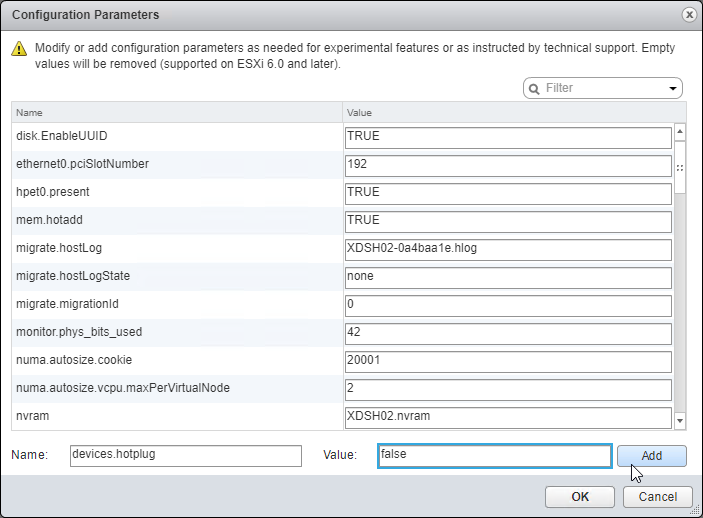
- Then click OK a couple times to close the windows.
- The VM can then be powered on.
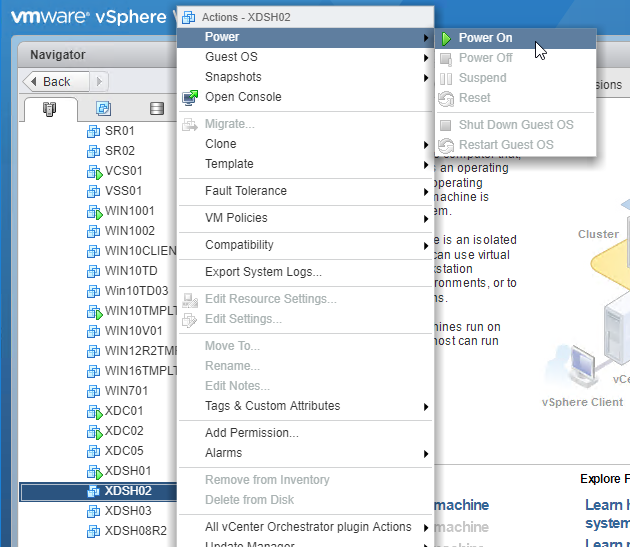
Windows Preparation
- Computer Group Policy – Make sure the Master VM is in the same OU as the Linked Clones so the Master VM will get the computer-level GPO settings in its registry. Run gpupdate on the master after moving the VM to the correct OU. When Clones are created from the Master, the computer-level GPO settings will already be applied, thus eliminating a timing issue.
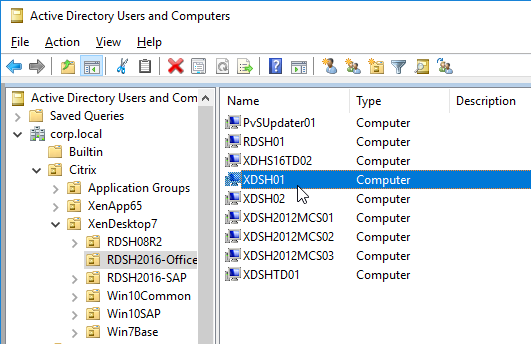
- If RDSH (Server OS), disable IE Enhanced Security Configuration in Server Manager > Local Server.
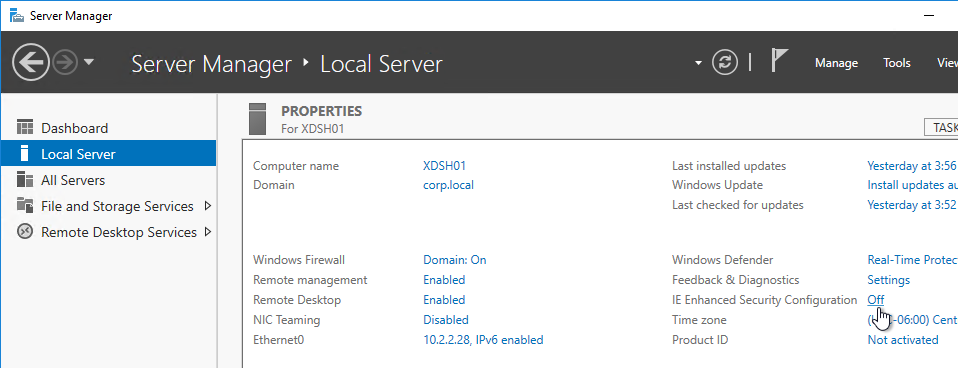
- Optionally, go to Action Center (Windows 8.1 or 2012 R2) or Control Panel > Security and Maintenance (Windows 10/2016) to disable User Account Control, and enable SmartScreen.
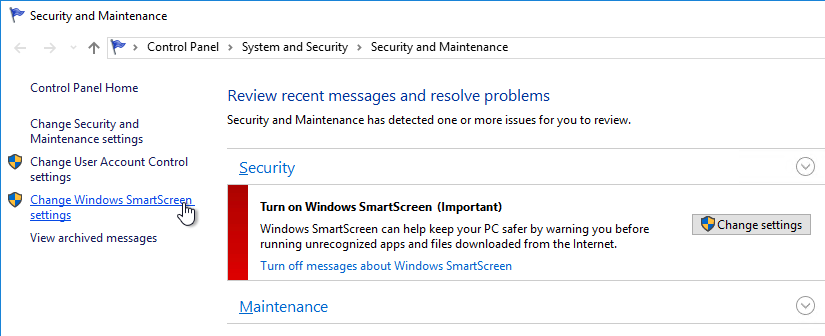
- In Windows 10 1703 and newer, search the Settings app for Change User Account Control settings.
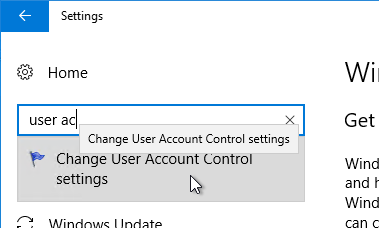
- SmartScreen is configured in Windows Defender Security Center > App & browser control.
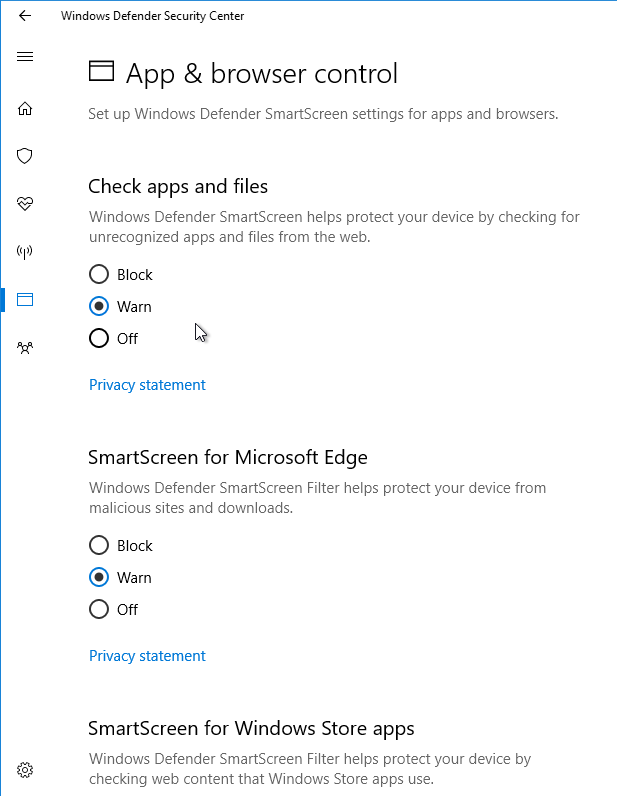
- In Windows 10 1703 and newer, search the Settings app for Change User Account Control settings.
- Run Windows Update.
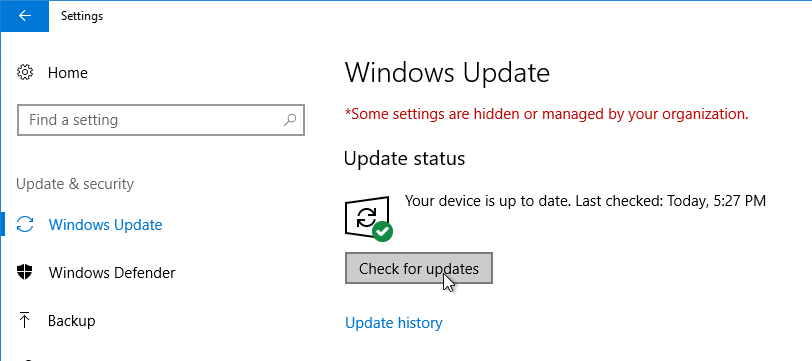
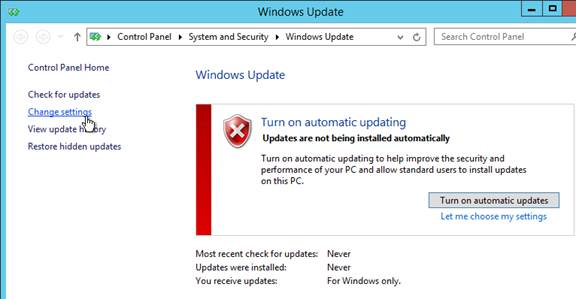
- Add your Citrix Administrators group to the local Administrators group on the VDA. Computer Management.
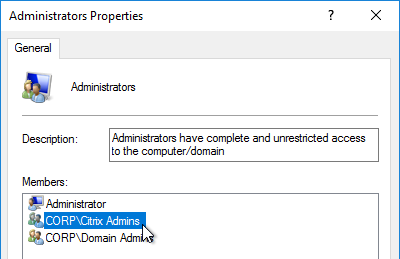
- The Remote Desktop Services “Prompt for Password” policy prevents Single Sign-on to the Virtual Delivery Agent. Check registry key
HKEY_LOCAL_MACHINE\SOFTWARE\Policies\Microsoft\Windows NT\Terminal Services. If fPromptForPassword = 1 then you need to fix group policy. The following GPO setting will prevent Single Sign-on from working.Computer Configuration | Policies | Administrative Templates | Windows Components | Remote Desktop Services | Remote Desktop Session Host | Security | Always prompt for password upon connectionOr set the registry valueHKEY_LOCAL_MACHINE\SOFTWARE\Citrix\Portica\AutoLogon (DWORD) = 0x1. This registry value only applies to Desktop OS, not Server OS. (source = comments) - For Windows 7/2008 R2 VDAs that will use Personal vDisk, or AppDisk, or any other layering technology, install Microsoft hotfix 2614892 A computer stops responding because of a deadlock situation in the Mountmgr.sys driver. This hotfix solved a Personal vDisk Image update issue detailed at Citrix Discussions.
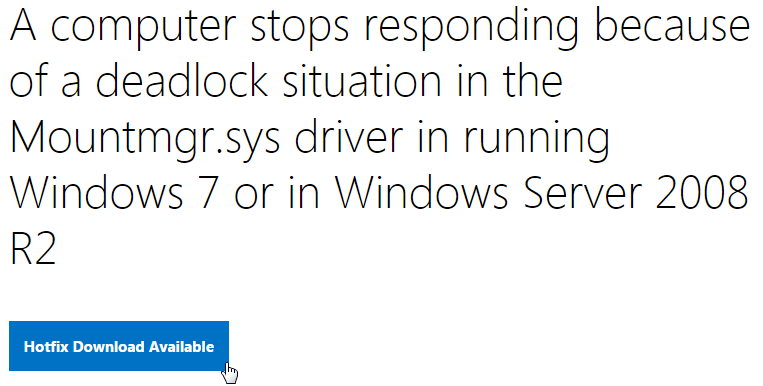
- If this VDA is Windows Server 2008 R2, see https://www.carlstalhood.com/windows-server-2008-r2-post-sp1-hotfixes/.

- To remove the built-in apps in Windows 10, see Robin Hobo How to remove built-in apps in Windows 10 Enterprise.
- For Remote Assistance in Citrix Director, configure the GPO setting Computer Configuration | Policies | Administrative Templates | System | Remote Assistance | Offer Remote Assistance. See Jason Samuel – How to setup Citrix Director Shadowing with Remote Assistance using Group Policy for more details.
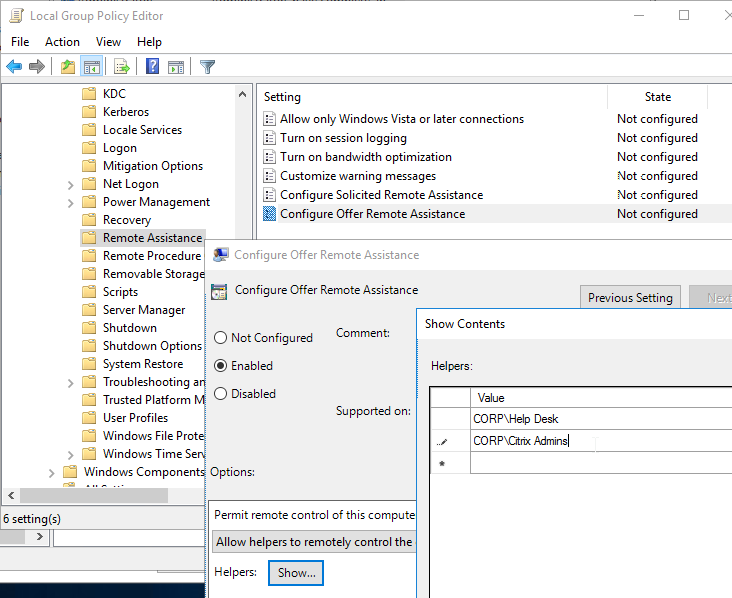
- If you intend to use Citrix’s SCOM Management Packs for XenApp/XenDesktop, make sure WinRM is enabled on the VDA by running winrm quickconfig. Or you can enable WinRM using Group Policy.
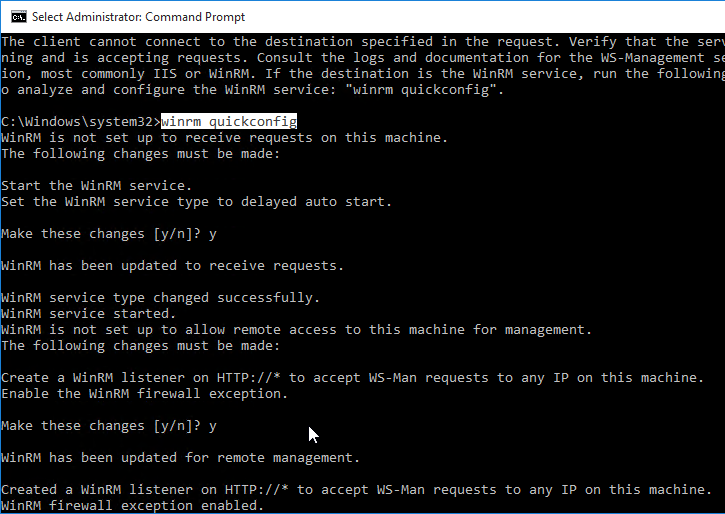
Install Virtual Delivery Agent 7.15.9000 LTSR
Citrix periodically releases Cumulative Updates for LTSR versions of VDA. The latest Cumulative Update for 7.15 is CU9 (7.15.9000). Get in the habit of periodically upgrading your LTSR VDAs to the latest Cumulative Update.
CLI Install:
Command Line Install Options are detailed at Install using the command line at Citrix Docs.
GUI Install:
- Mount the downloaded XenDesktop 7.15.9000 LTSR ISO.
- Run AutoSelect.exe from the ISO.
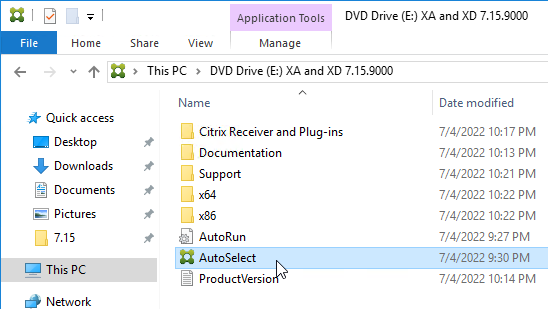
- Alternatively, you can download the standalone VDA package and run that instead. Go the main XenDesktop 7.15.9000 download page. Expand the section labelled Components that are on the product ISO but also packaged separately to download the Standalone VDA installers. Note: 7.15.9000 also has a VDA installer called Desktop OS Core Services that is designed for Remote PC deployments and is not typically used on virtual machines.
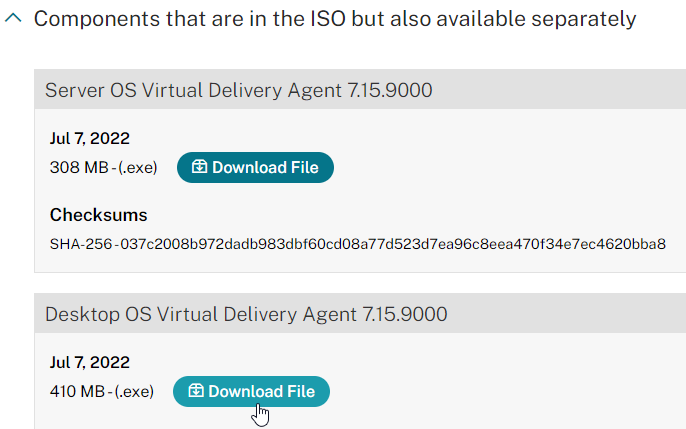
- If you want to later install Browser Content Redirection, then you’ll need to install the VDA 7.15 CU9 with HTML5 disabled. You do that by including the /FEATURE_DISABLE_HTML5 command line switch when running XenDesktopVDASetup.exe.

- Alternatively, you can download the standalone VDA package and run that instead. Go the main XenDesktop 7.15.9000 download page. Expand the section labelled Components that are on the product ISO but also packaged separately to download the Standalone VDA installers. Note: 7.15.9000 also has a VDA installer called Desktop OS Core Services that is designed for Remote PC deployments and is not typically used on virtual machines.
- Click Start next to either XenApp or XenDesktop. The only difference is the product name displayed in the installation wizard.
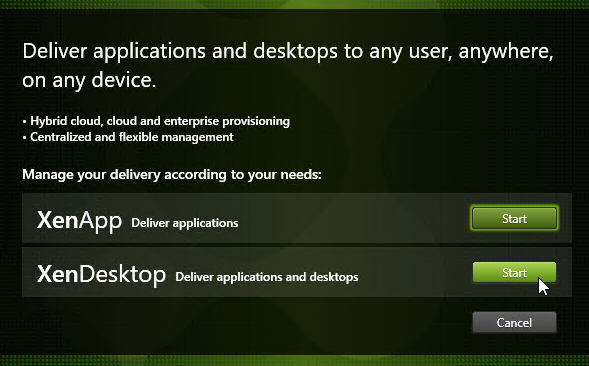
- On the top right, click Virtual Delivery Agent for Windows Desktop OS, or Windows Server OS, depending on which type of VDA you are building.
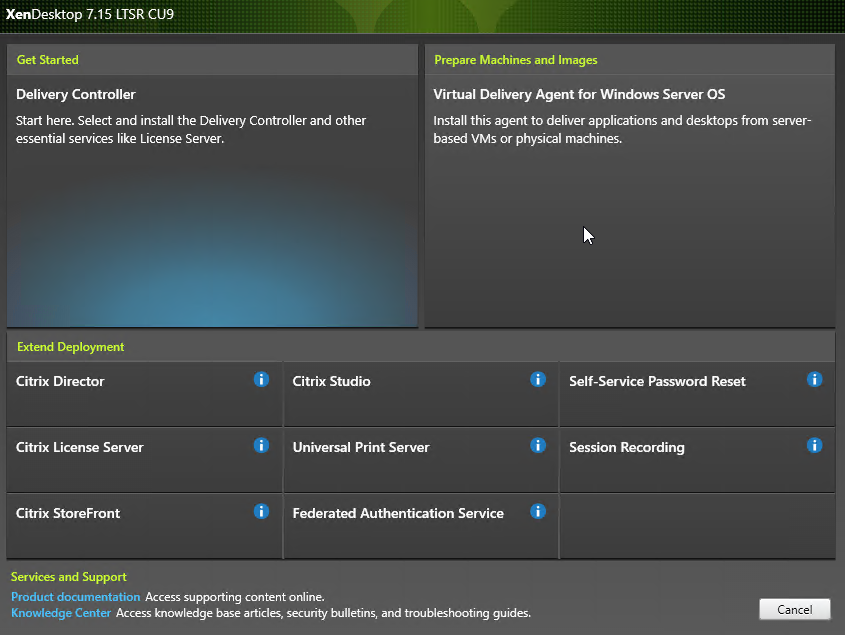
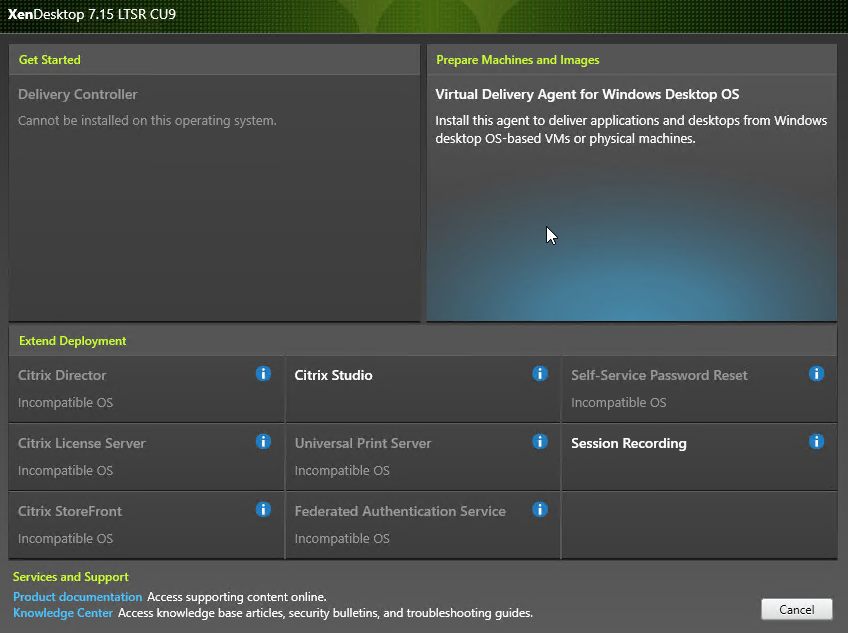
- In the Environment page, select Create a Master Image, and click Next.
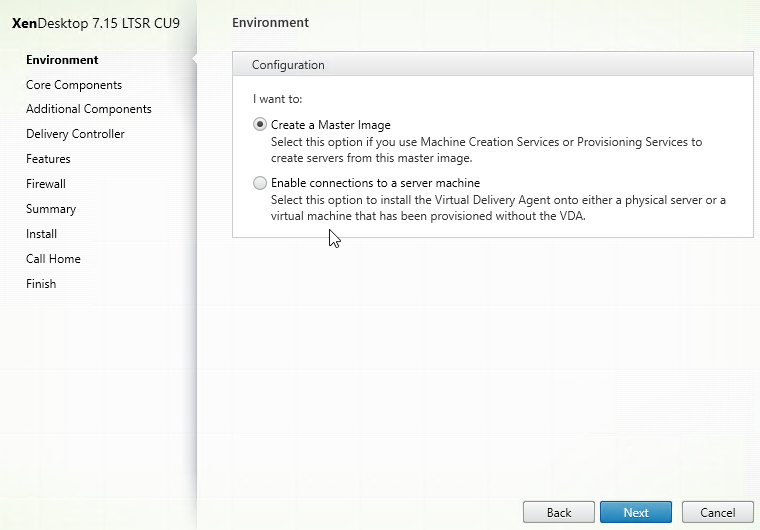
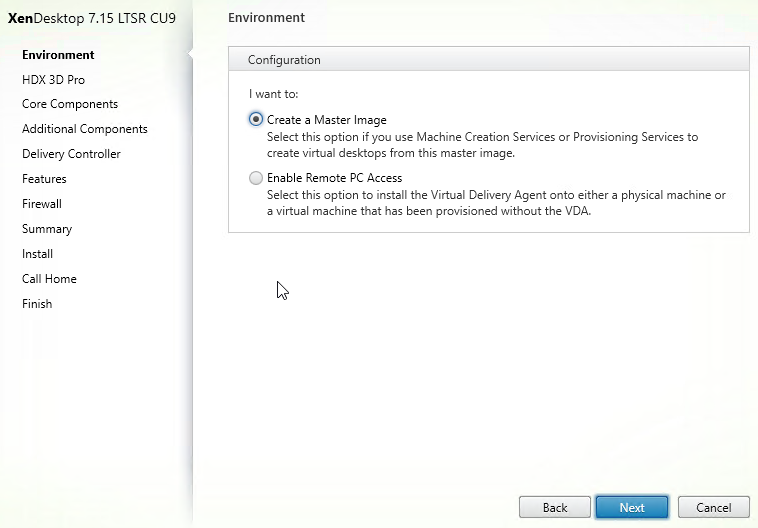
- For virtual desktops, in the HDX 3D Pro page, click Next.
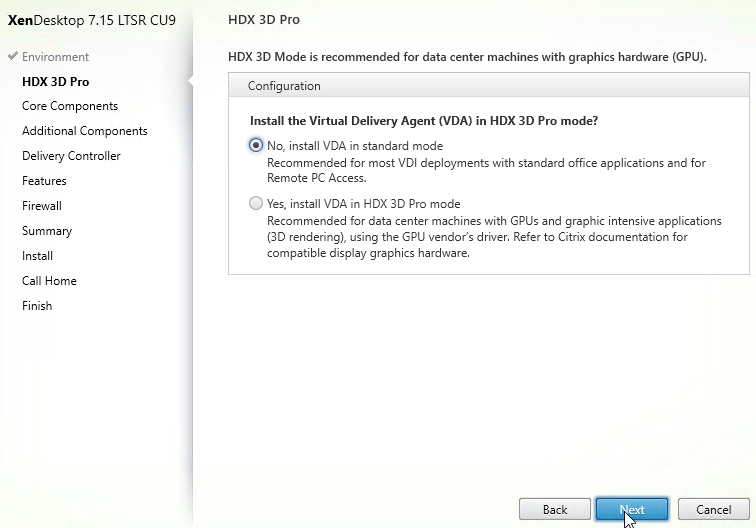
- In the Core Components page, if you don’t need Citrix Workspace app installed on your VDA, then uncheck the box. Workspace app is usually only needed for double-hop connections (connect to first VDA, and then from there, connect to second VDA). Click Next.
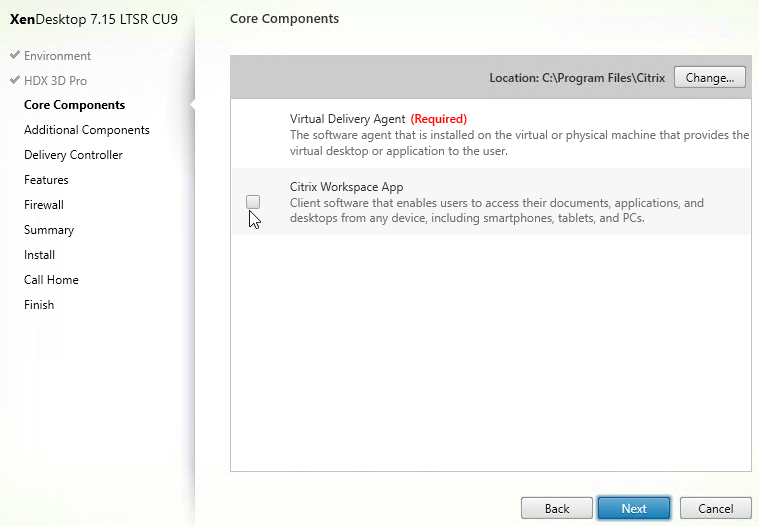
- In the Additional Components page, uncheck Citrix AppDisk/Personal vDisk. This feature has been deprecated and is being replaced by Citrix App Layering (Unidesk). If you are installing VDA on Windows 10 1709 or newer, then it is critical that you uncheck this. Click Next.
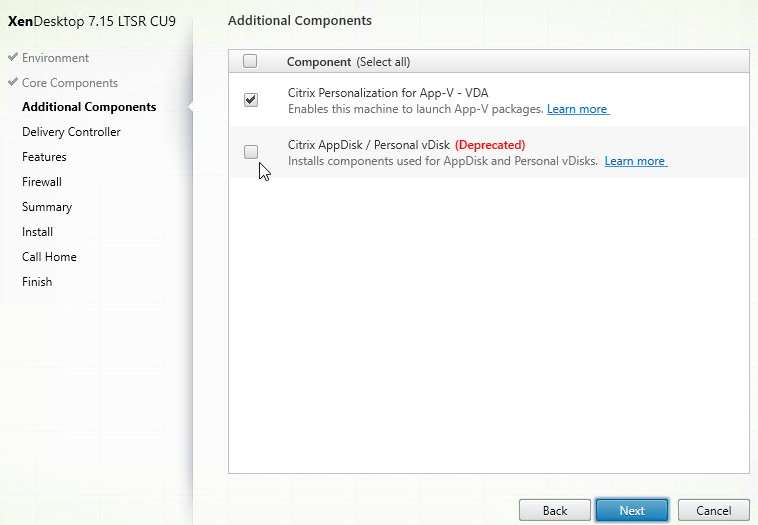
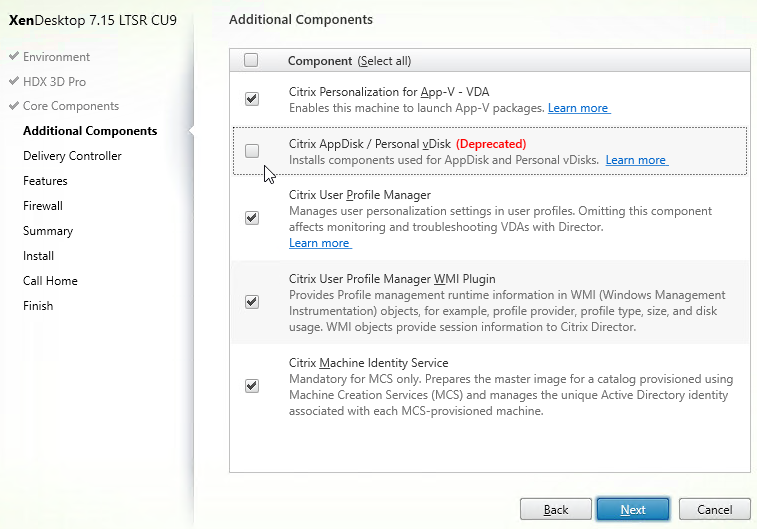
- In the Delivery Controller page, select Do it manually. Enter the FQDN of each Controller. Click Test connection. And then make sure you click Add. Click Next when done.
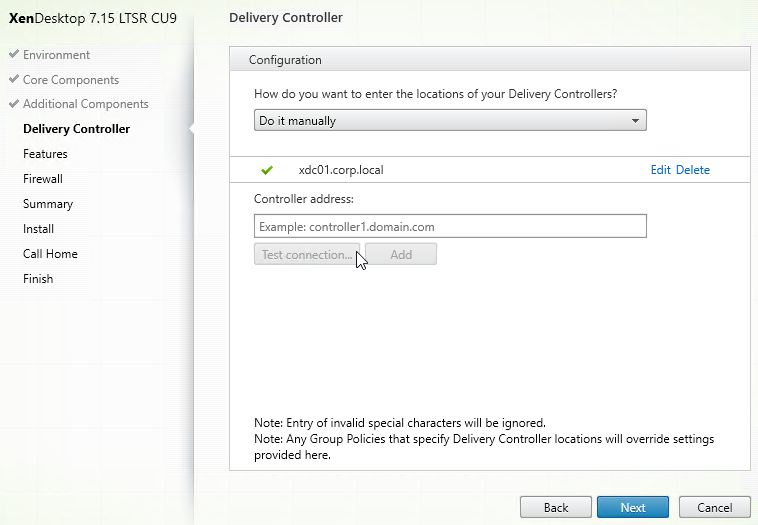
- In the Features page, check boxes. Only the top box is checked by default. If you want to use the other features, check the boxes. Then click Next.
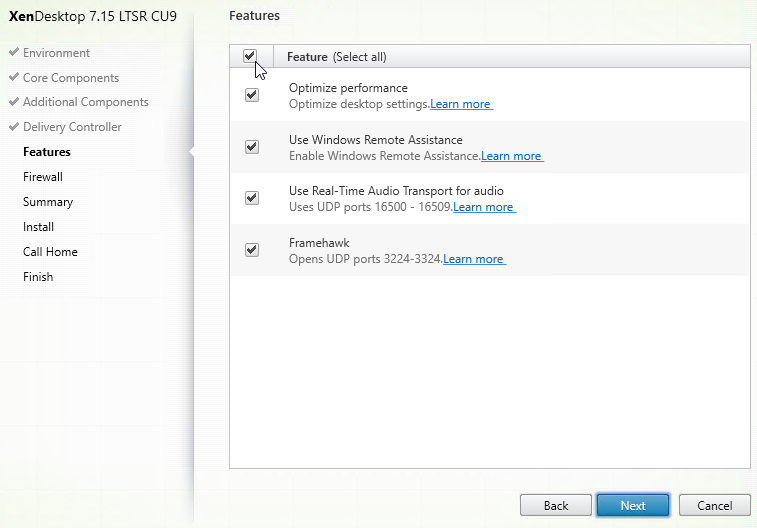
- In the Firewall page, click Next.
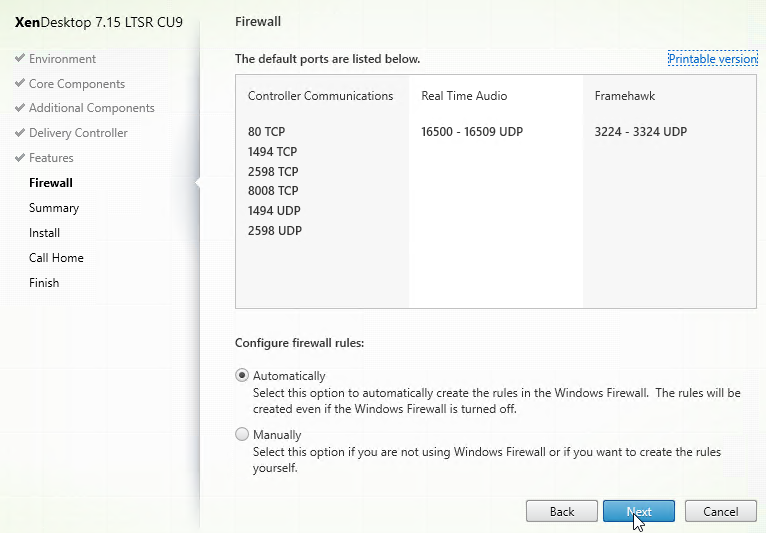
- In the Summary page, click Install.
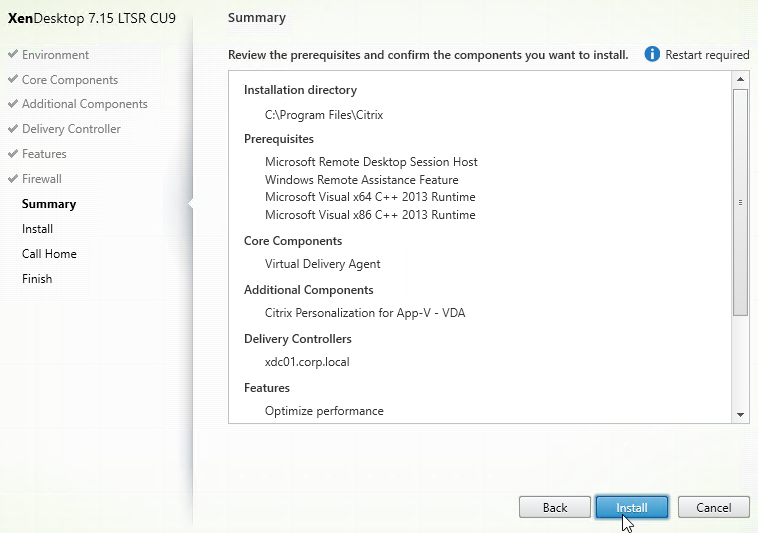
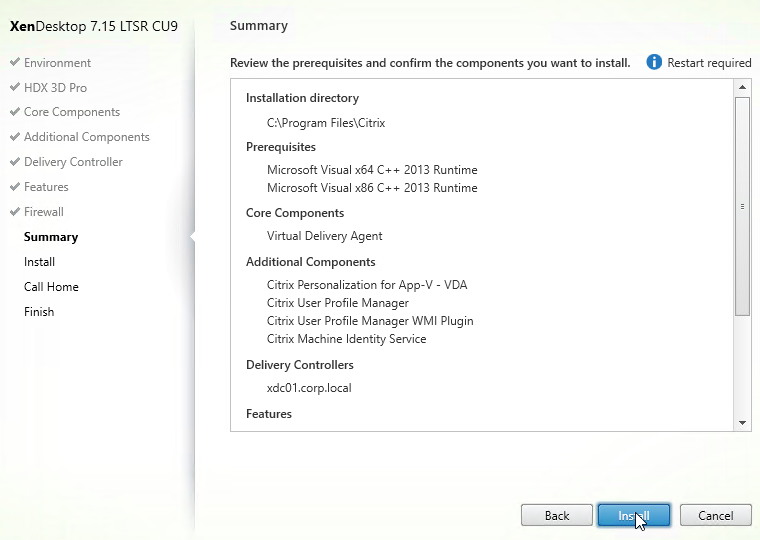
- Click Close if you are prompted to restart.

- After the reboot, login.
- If you see a Locate ‘XenDesktop LTSR CU9’ installation media window:
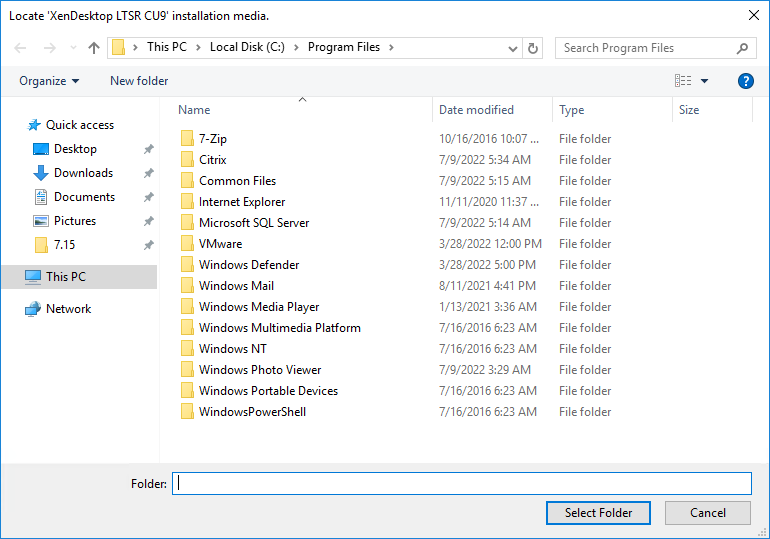
- Don’t close the Locate window.
- Mount the XenApp_and_XenDesktop_7.15.9000.iso.
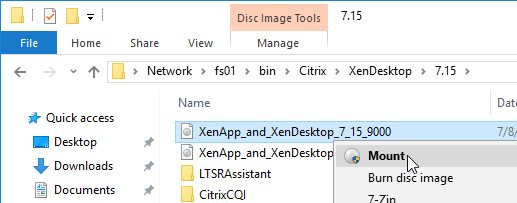
- Go back to the Locate window.
- On the bottom left, under This PC, click the mounted drive. Then click the Select Folder button.
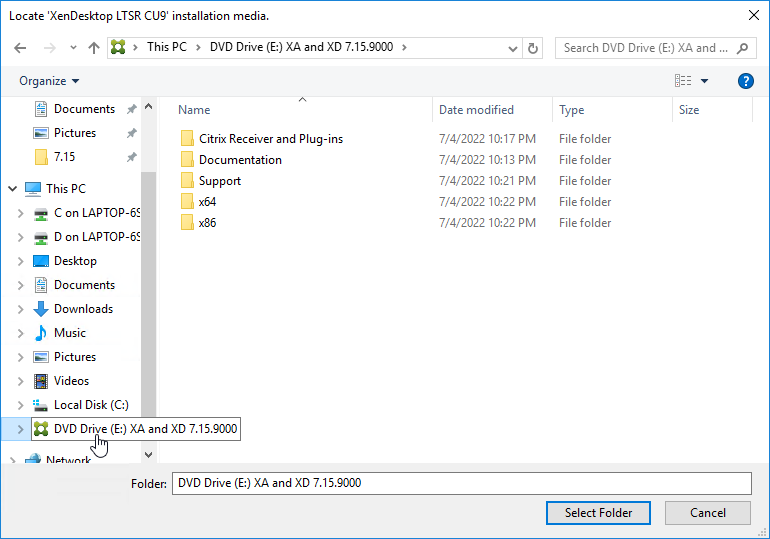
- Installation will resume.
- Note: NT SERVICE\CitrixTelemetryService needs permission to login as a service.
- In the Call Home page, make your choice, click Connect, and then click Next.
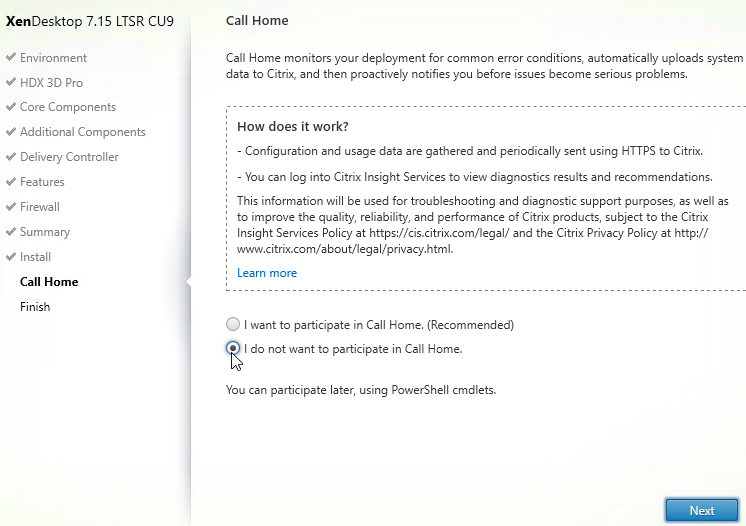
- In the Finish page, click Finish to restart the machine again.
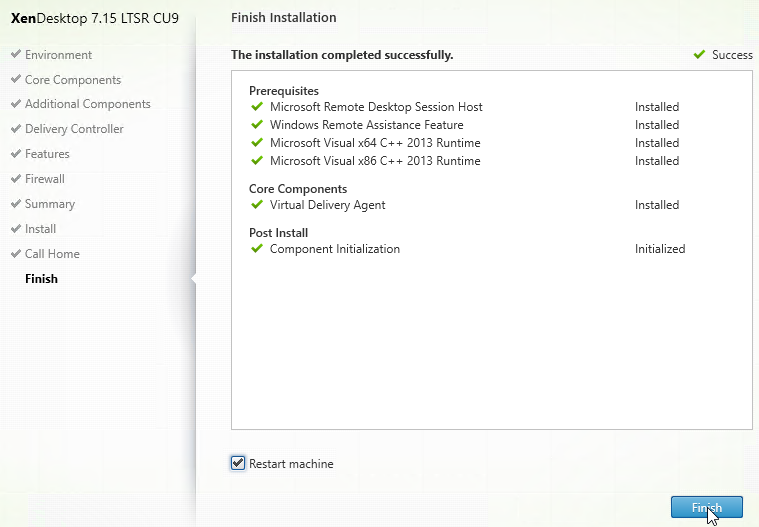
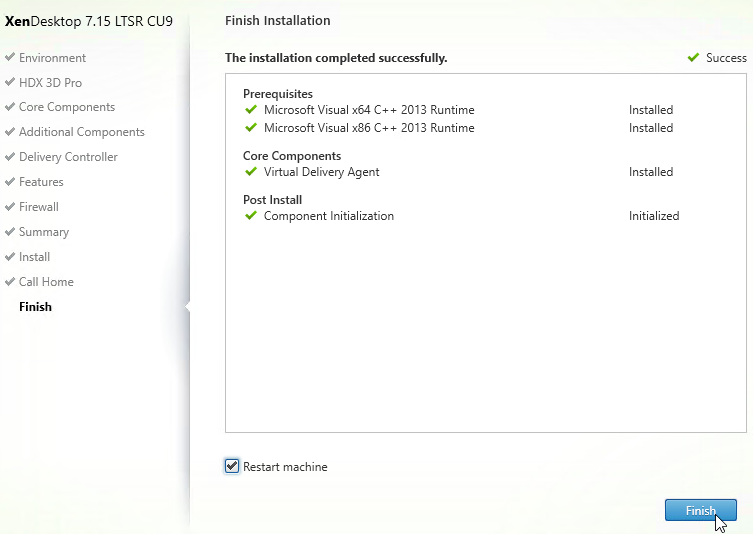
- According to CTX225819 When Launching an Application Published from Windows Server 2016, a Black Screen Appears for Several Seconds Before Application is Visible, HKLM\SOFTWARE\Citrix\Citrix Virtual Desktop Agent\DisableLogonUISuppression (DWORD) should be set to 0.
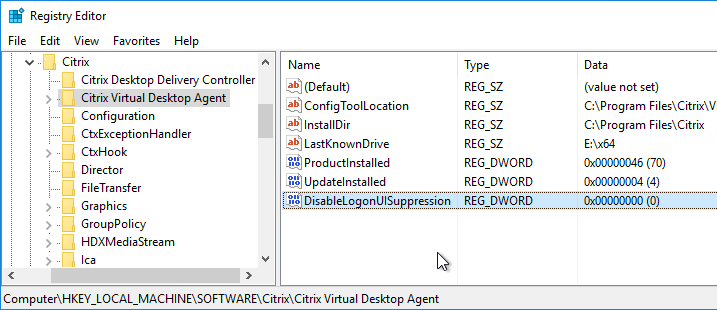
Profile Management 7.15.7000 Hotfix 1 – Security Fix
This update fixes a Local privilege escalation as detailed at CTX319750 Citrix Virtual Apps and Desktops Security Update. This hotfix is not needed if you are running VDA 7.15.9000.
- Download Hotfix ProfilemgtWX64_7_15_7001 and extract it.
- From the ProfilemgtWX64_7_15_7001 folder, run profilemgt_x64.msi.

- In the Welcome to the Citrix Profile management Setup Wizard page, click Next.
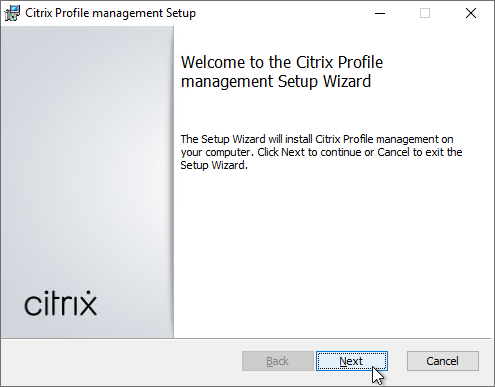
- In the End-User License Agreement page, check the box next to I accept the terms and click Next.
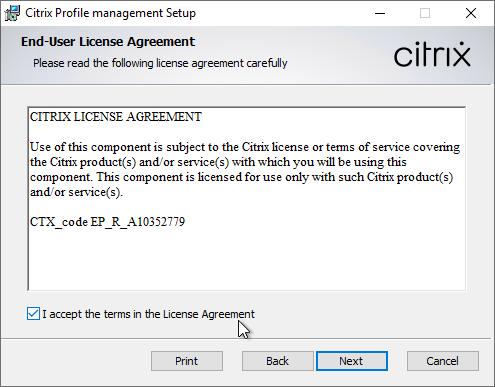
- In the Destination Folder page, click Next.
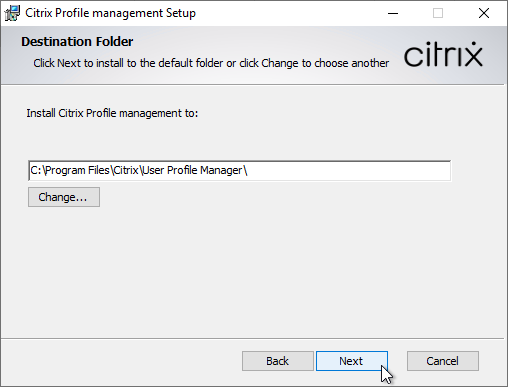
- In the Ready to install Citrix Profile management page, click Install.
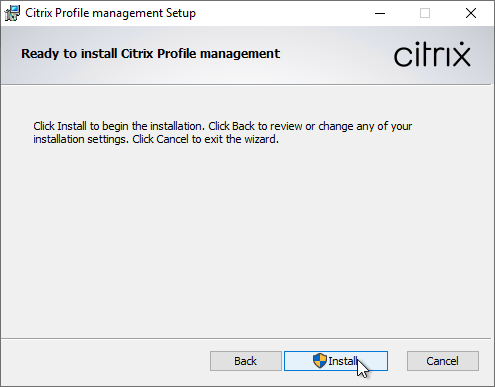
- Click OK if prompted to update existing files.
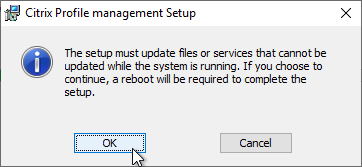
- In the Completed the Citrix Profile management Setup Wizard page, click Finish.
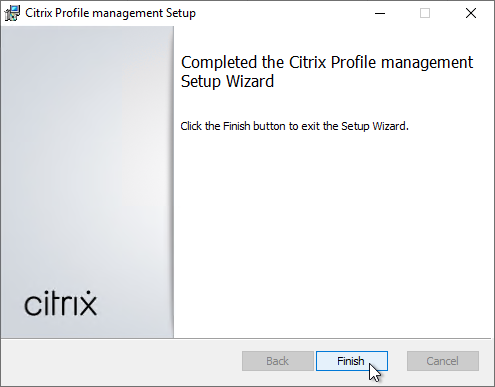
- Click Yes when asked to restart now.
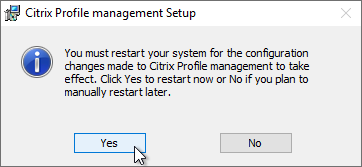
Also update the UPM VDA Plugin.
- Download Hotfix UPMVDAPluginWX64_7_15_7001 and extract it.
- From the UPMVDAPluginWX64_7_15_7001 folder, run UpmVDAPlugin_x64.msi.

- In the Welcome to the UpmVDAPlugin Setup Wizard page, click Next.
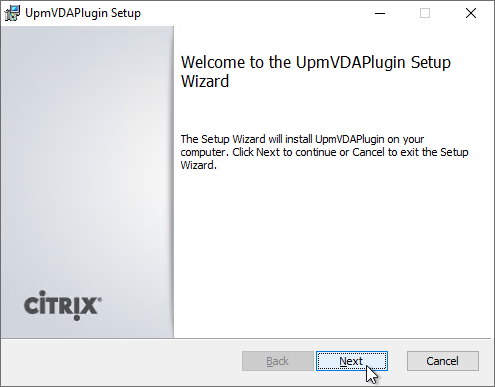
- In the End-User License Agreement page, check the box next to I accept the terms and click Next.
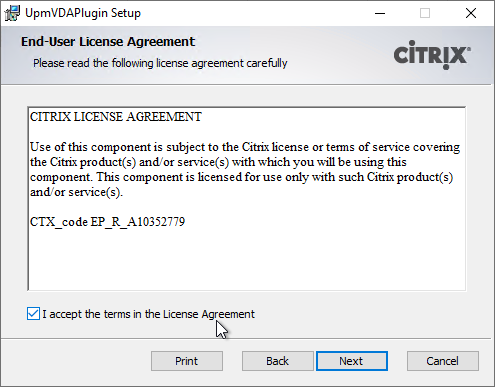
- In the Destination Folder page, click Next.
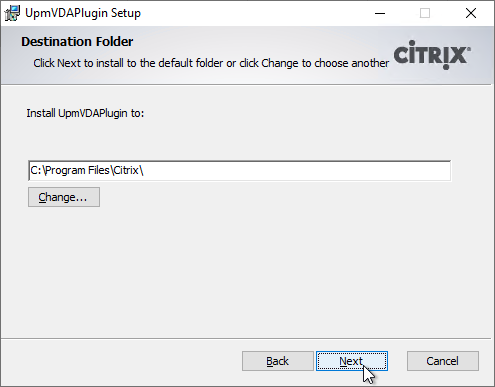
- In the Ready to install UpmVDAPlugin page, click Install.
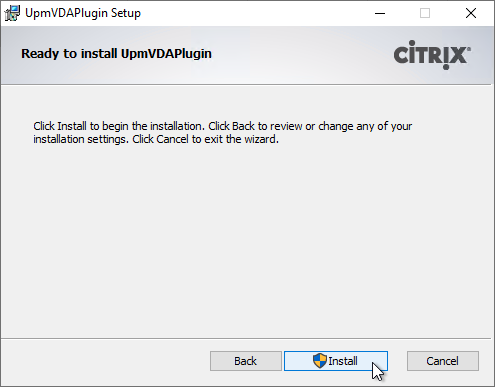
- Click OK if you see Files in Use.
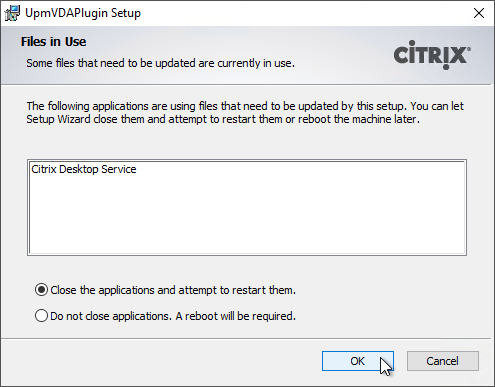
- Click OK to update existing files.
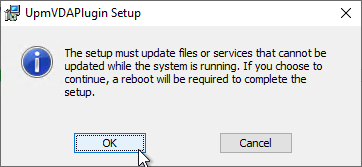
- In the Completed the UpmVDAPlugin Setup Wizard page, click Finish.
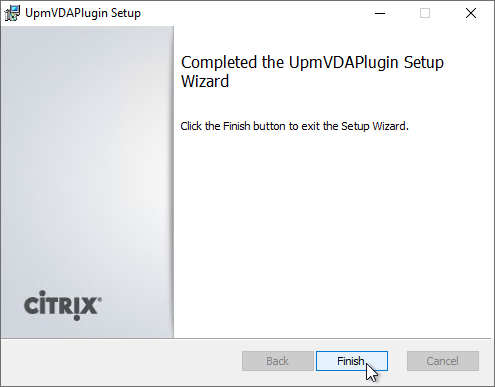
Microsoft FSLogix
If you need to roam the user’s Outlook .OST file (Outlook Cached Mode), Outlook Search Index, OneDrive cache, OneNote data, SharePoint data, Skype data, and/or Teams data, then download, install, and configure Microsoft FSLogix. FSLogix has more Office roaming features than Citrix Profile Management. A common architecture is to enable FSLogix Office Container for the Office cache files and use Citrix Profile Management for all other roaming profile files and registry keys.
Microsoft FSLogix is free for all Microsoft RDS CALs, Microsoft Virtual Desktop Access per-user CALs, and all Microsoft Enterprise E3/E5 per-user licenses. Notice that per-device licenses are excluded.
G0-EUC tested FSLogix Profile Container (not Office Container) and found that it reduces capacity by 27%. (source = The impact of managing user profiles with FSLogix)
Do the following to install Microsoft FSLogix on the VDA machine:
- Go to https://docs.microsoft.com/en-us/fslogix/install-ht and click the download link.
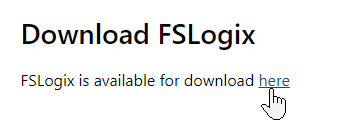
- Extract the downloaded .zip file.
- In the FSLogix \x64\Release folder, run FSLogixAppsSetup.exe.

- Check the box next to I agree to the license terms and conditions and click Install.
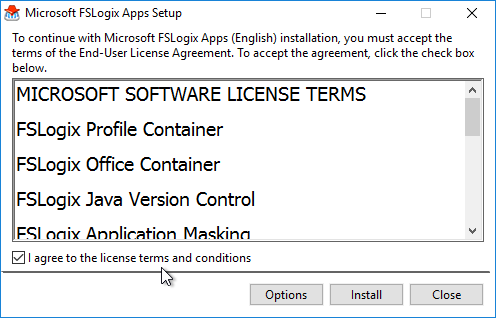
- In the Setup Successful page, click Restart.
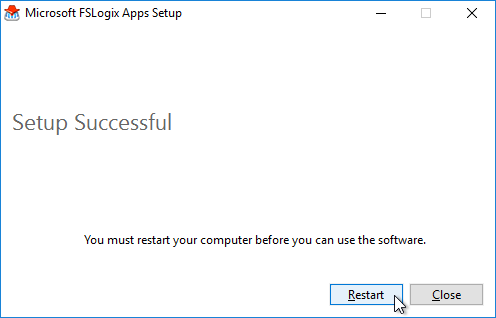
- Make sure the Windows Search service is set to Automatic and Running.
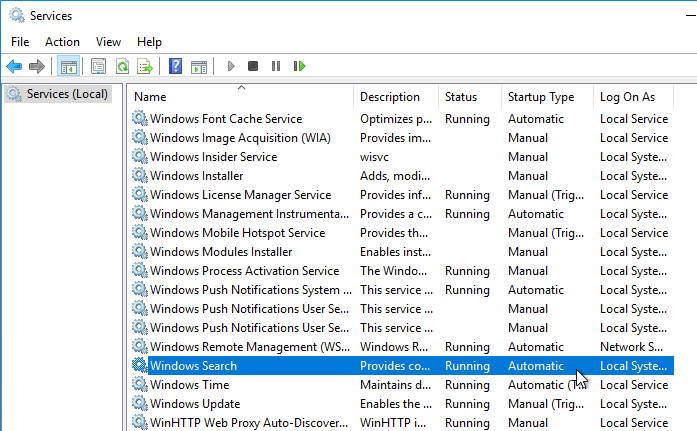
- If Office is already installed, then repair the Office installation after installing and starting the Windows Search Service.
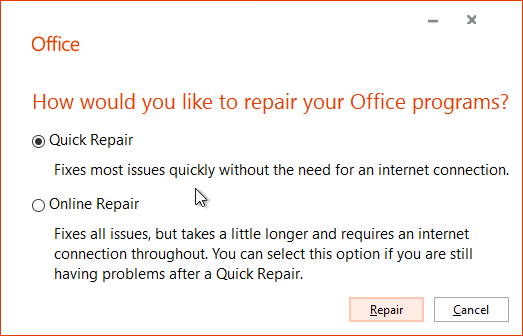
FSLogix is configured through Group Policy or by editing registry values on each FSLogix Agent machine.
Browser Content Redirection
Browser Content Redirection (BCR) can optionally be added to VDA 7.15 Cumulative Update 3 or newer. This is a back port of the same BCR feature in Citrix Virtual Apps and Desktops (CVAD) 1811.
BCR requires Workspace app and will not work with Receiver, including the LTSR version of Receiver.
To install BCR on VDA 7.15.9000:
- Download Browser Content Redirection 15.15. The BCR add-in has not been modified for 7.15.9000.
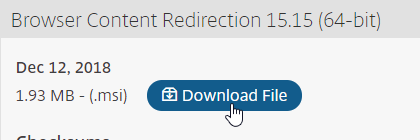
- If you installed the VDA using AutoSelect.exe, then you’ll need to uninstall the VDA and reinstall it, but this time from the command line.
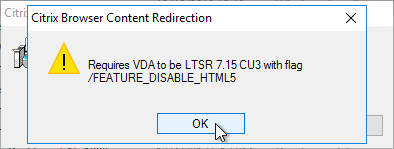
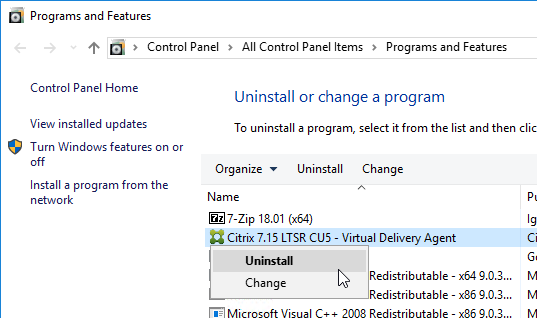
- On the 7.15.9000 ISO, go to \x64\XenDesktop Setup and copy the path to the XenDesktopVDASetup.exe file. Copy as path appears when you hold down Shift while right-clicking.
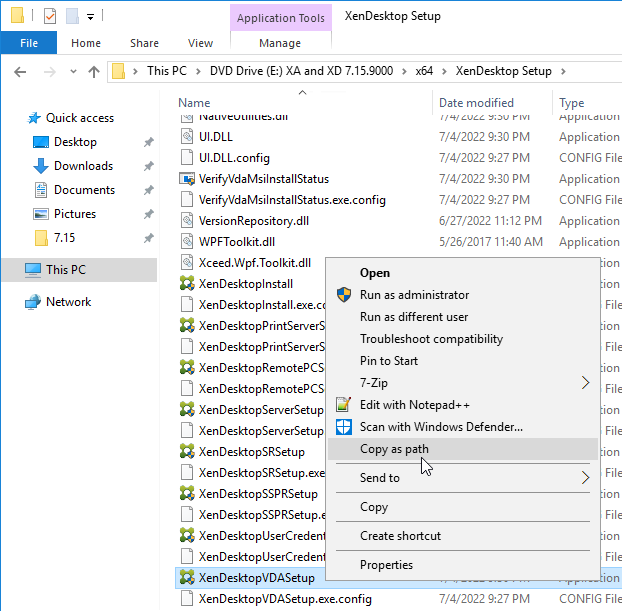
- Open a command prompt and paste the path.
- At the end of the path, enter /FEATURE_DISABLE_HTML5 and press Enter.

- Reinstall the VDA like normal.
- On the 7.15.9000 ISO, go to \x64\XenDesktop Setup and copy the path to the XenDesktopVDASetup.exe file. Copy as path appears when you hold down Shift while right-clicking.
- After VDA 7.15 CU8 is installed with the HTML5 Feature disabled, run the downloaded BCR_x64.msi. It installs silently and quickly.
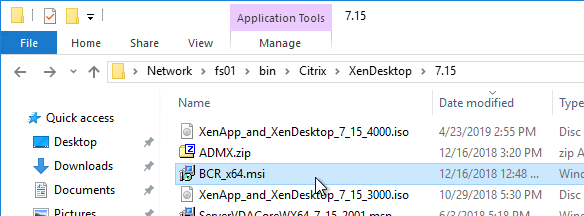
- To verify it is installed, open Programs and Features (or Apps and Features) and find Citrix Browser Content Redirection version 15.15.0.10.
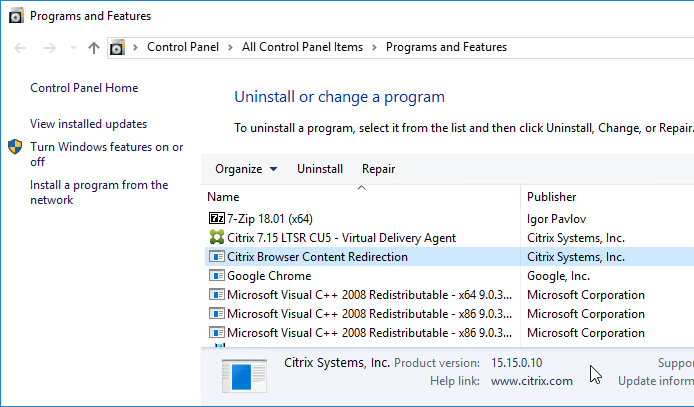
- If you open Services on the VDA, you’ll see the Citrix HDX services.
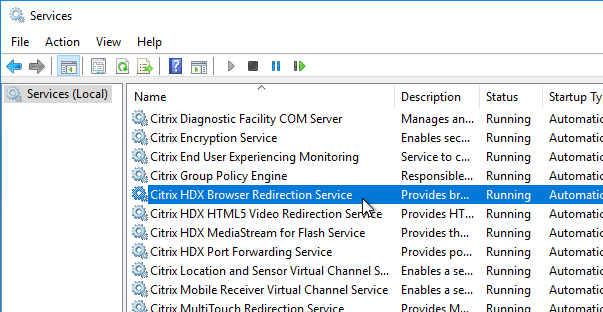
BCR GPO Admin Templates
7.15 does not have the Citrix Policy settings to control BCR so you’ll instead need to install a GPO ADMX template. This template was updated in November 2019.
- In the same download page for Browser Content Redirection 15.15, scroll down to find the ADMX Files and then download it.

- Extract the .zip file.
- Inside the extracted ADMX folder, open the 64bit folder and copy MultimediaGroupPolicy.admx to the clipboard.
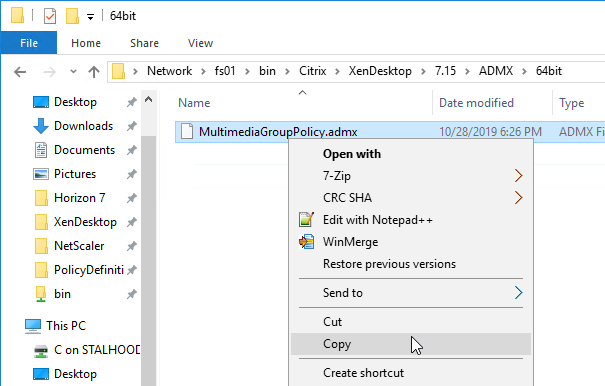
- Go to your PolicyDefinitions folder (in Sysvol, or C:\Windows) and then paste the .admx file.
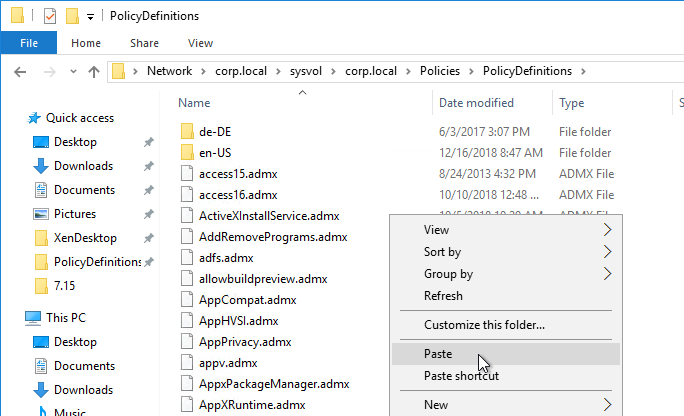
- Back in the extracted ADMX files, go up a folder to the root of the ADMX files and copy MultimediaGroupPolicy.adml to the clipboard.
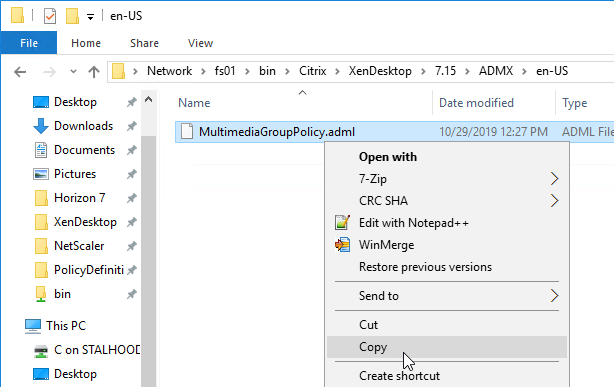
- Go to your PolicyDefinitions folder (in Sysvol, or C:\Windows), open the en-US folder, and then paste the .adml file.
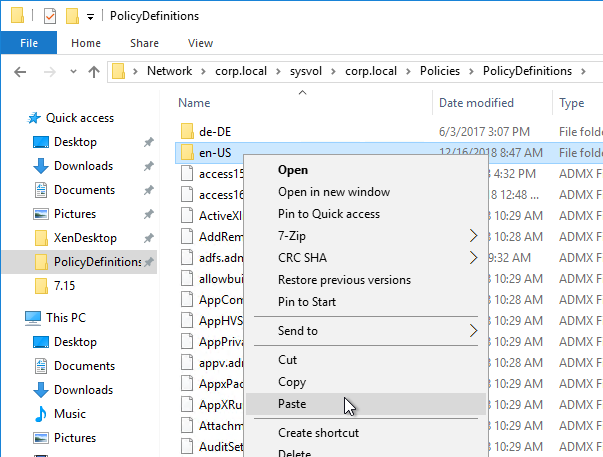
- When you open a Group Policy that applies to the VDA Computers, in the Computer half of the GPO, under Administrative Templates, you’ll see a new node named HDX Browser Content Redirection. The settings in this folder are the same ones configured in Citrix Policy in newer versions of Citrix Virtual Apps and Desktops (CVAD). See https://www.carlstalhood.com/published-applications/#browsercontentredirection for configuration details.
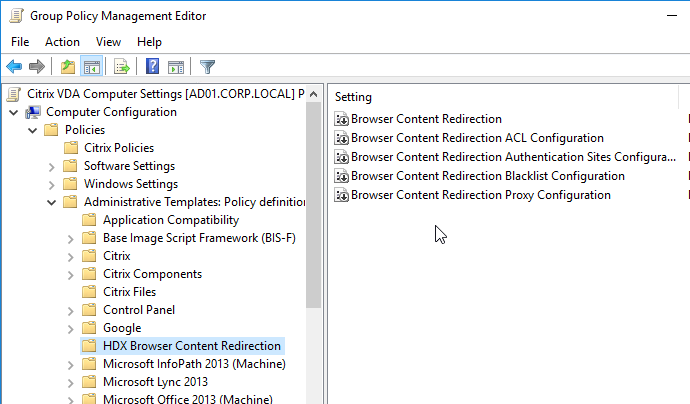
BCR requires Workspace app and will not work with Receiver, including the LTSR version of Receiver.
Citrix Desktop Service
To prevent Citrix Desktop Service (BrokerAgent) starting and registering with the Delivery Controllers before the boot process is complete, see Jeremy Saunders Controlling the Starting of the Citrix Desktop Service (BrokerAgent).
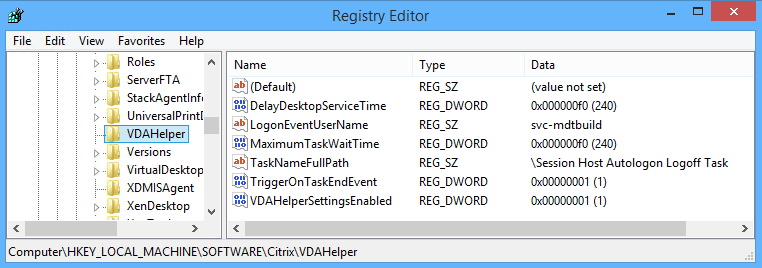
Customer Experience Improvement Program (CEIP)
Customer Experience Improvement Program (CEIP) is enabled by default. To disable it, create the registry value HKEY_LOCAL_MACHINE\SOFTWARE\Citrix\Telemetry\CEIP\Enabled (DWORD), and set it to 0 (zero). Also see CEIP at Citrix Insight Services at Citrix Docs.
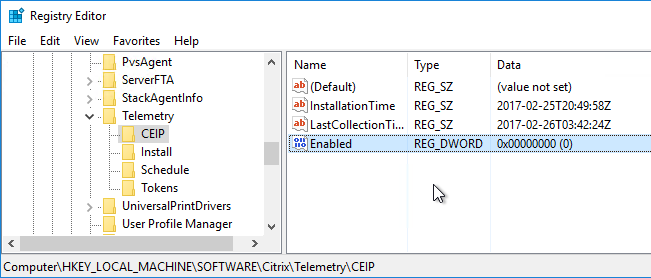
See https://www.carlstalhood.com/delivery-controller-7-15-ltsr-and-licensing/#ceip for additional places where CEIP is enabled.
Connection Quality Indicator
The Connection Quality Indicator tells the user the quality of the connection. Position of the indicator is configurable by the user. Thresholds are configurable through group policy.
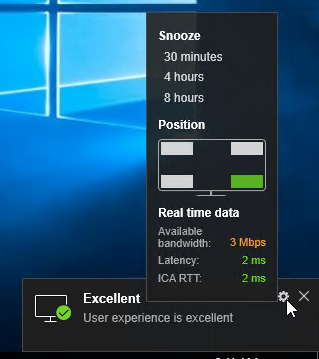
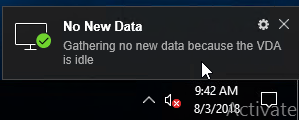
Download it from CTX220774 Connection Quality Indicator and install it. The article is very detailed.
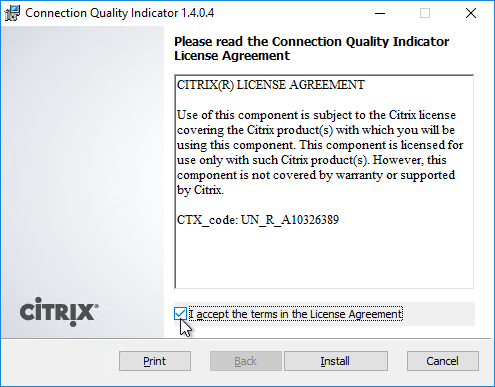
Group Policy templates are located at C:\Program Files (x86)\Citrix\Connection Quality Indicator\Configuration. Copy the files and folder to <Sysvol>\Policies\PolicyDefinitions, or C:\Windows\PolicyDefinitions.
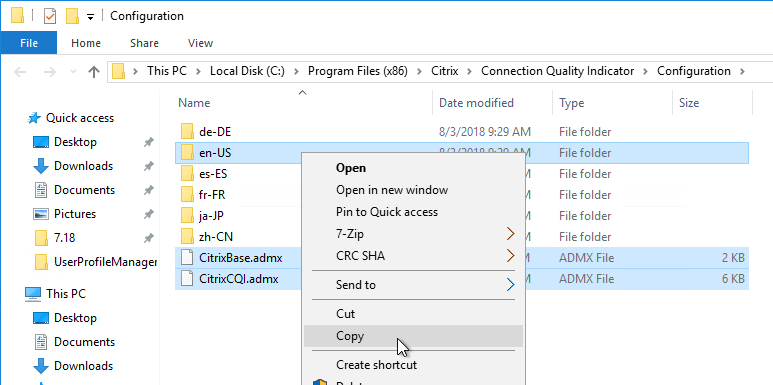
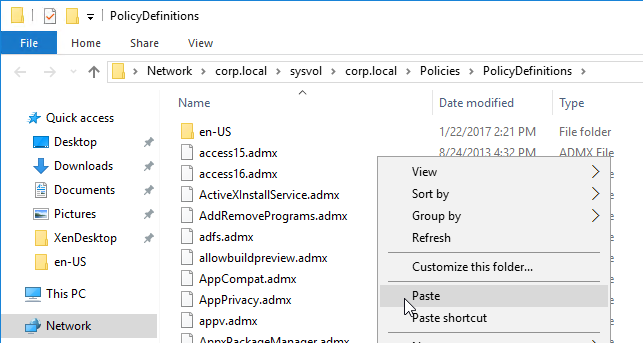
Find the settings under Computer Config | Policies | Administrative Templates | Citrix Components | Virtual Desktop Agent | CQI
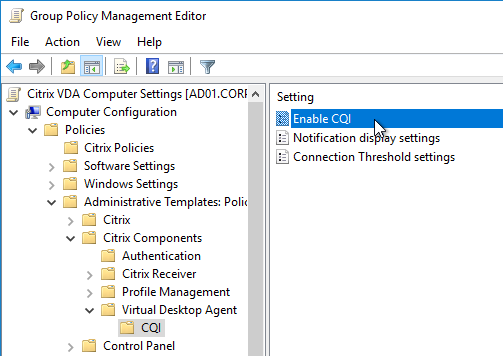
Version 1.2 adds the GPO settings to the user half of a GPO.
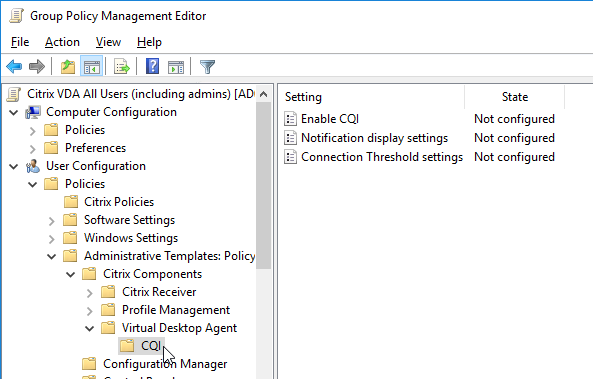
Notification display settings lets you customize the user notifications, or disable them.
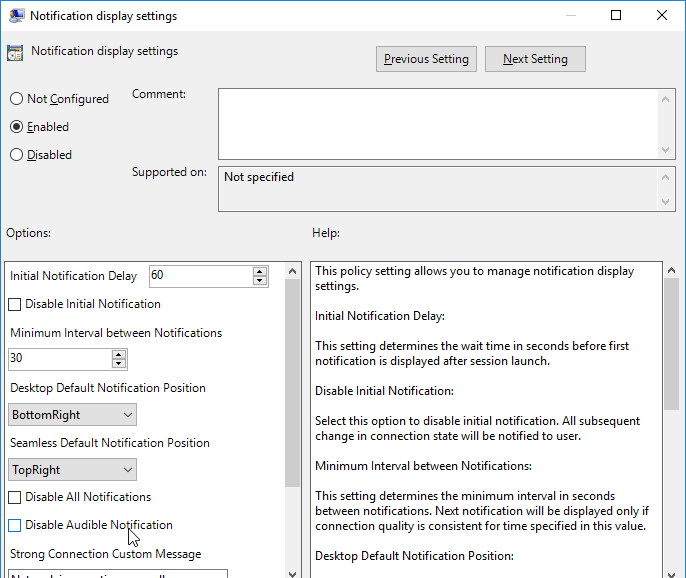
Connection Threshold Settings lets you set the notification thresholds.
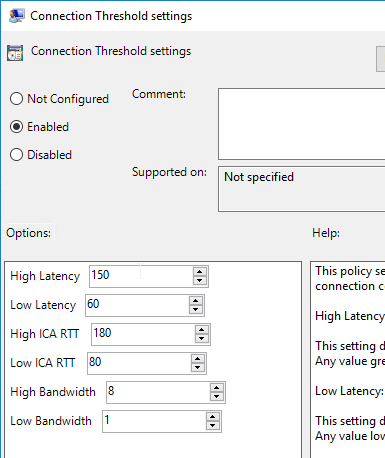
Adaptive Transport
XenApp/XenDesktop 7.15 includes Adaptive Transport, which uses EDT protocol, which uses UDP Ports 1494/2598 for HDX connections to the VDA. The UDP ports should already be open in the Windows Firewall.
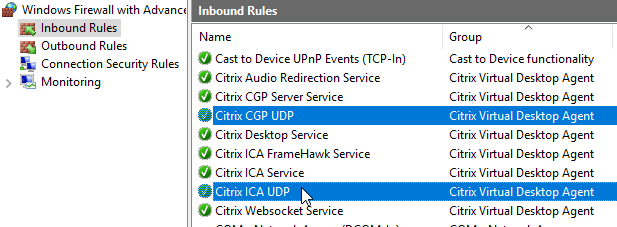
Adaptive Transport is disabled by default, but can be enabled in the Citrix Policy setting HDX Adaptive Transport.
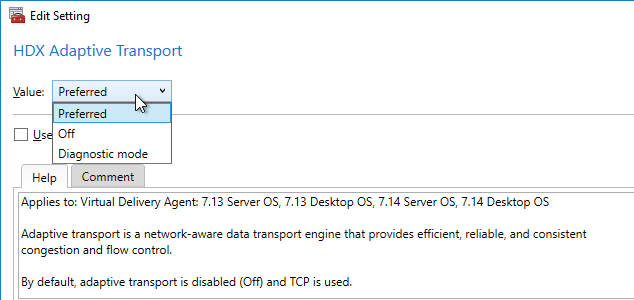
Slow Logons
Citrix Discussions Xenapp 7.9: Wait for local session manager: “I have a Xenapp 7.9 environment on Windows 2012 R2. When logging in through Citrix I got message “Wait for local session manager” for 20-30 seconds. When logging in to the server with RDS, I do not have to wait for this.”
“Add the following 2 registry keys to your 7.9 VDA server – then try connecting to it using ICA to see if the issue still occurs:
Add reg keys in “HKLM\SOFTWARE\Citrix\GroupPolicy”
Dword: “CacheGpoExpireInHours” – Value = 5-24 (# of Hours) ***start with value of 5***
Dword: “GpoCacheEnabled” – Value = 1
Restart the machine after adding these registry keys and attempt an ICA connection (at least twice) to see if that helps the Login delay.”
Mark DePalma at XenApp slow logon times, user get black screen for 20 seconds at Citrix Discussions says that pushing Tile Refresh to a background task speeds up logons.
- Regedit:
Windows Registry Editor Version 5.00 [HKEY_LOCAL_MACHINE\SOFTWARE\Microsoft\Active Setup\Installed Components\DisableUPMResetCache] @="DisableUPMResetCache" "Version"="1,1,1,1" "StubPath"="REG ADD HKCU\\Software\\Microsoft\\Windows\\CurrentVersion\\ImmersiveShell\\StateStore /v ResetCache /t REG_DWORD /d 0 /f" "Locale"="*"
- UPM Exclusions:
Directory - '!ctx_localappdata!\Microsoft\Windows\Caches' Registry - 'SOFTWARE\Microsoft\Active Setup\Installed Components\DisableUPMResetCache'
Marvin Neys at XenApp slow logon times, user get black screen for 20 seconds at Citrix Discussions says that deleting HKCU\Software\Microsoft\Windows\CurrentVersion\UFH\SHC at logoff reduces logon times from 40 seconds to 6 seconds.
Remove-Item HKCU:\Software\Microsoft\Windows\CurrentVersion\UFH\SHC
For additional logon delay troubleshooting, see Alexander Ollischer XenApp/XenDesktop – “Please Wait For Local Session Manager” message when logging into RDS. He found some Windows Updates that caused a logon delay.

XenApp recalculates WMI filters on every reconnect. CTX212610 Session Reconnect 30 sec Delay – DisableGPCalculation – WMI Filters indicates that recalculation can be disabled by setting HKEY_LOCAL_MACHINE\SOFTWARE\Citrix\Reconnect\DisableGPCalculation (DWORD) to 1. Note: this registry value might stop Citrix Policies from being re-evaluated when users reconnect (source = Citrix Discussions).
If your VDA is 2008 R2, then CTX207038 Application not launching and the session is stuck at the PreLogon state: The ‘IgnoreRegUserConfigErrors’ registry setting on the Terminal Server will cause Winlogon to ignore the fact that it cannot contact a DC in the domain of the authenticating user to get the information it is looking for.
- Key = HKEY_LOCAL_MACHINE\SYSTEM\CurrentControlSet\Control\Terminal Server
- Value (DWORD) = IgnoreRegUserConfigErrors = 1
CTX212439 Desktop Session Stuck in Pre-Logon State with Message “Please wait for the Local Session Manager”:
- HKEY_LOCAL_MACHINE\SYSTEM\CurrentControlSet\Control\Lsa\Kerberos\Parameters\MaxTokenSize (DWORD) = 48000
- Delete HKEY_LOCAL_MACHINE\SYSTEM\CurrentControlSet\Control\Terminal Server\RCM\GracePeriod\L$RTMTIMEBOMB
Controller Registration Port
Some environments will not accept the default port 80 for Virtual Delivery Agent registration, even though registration is authenticated and encrypted on port 80. To change the port, do the following on the Virtual Delivery Agent:
- Open Programs and Features. If Windows 10 1703 or newer, open Apps and Features.
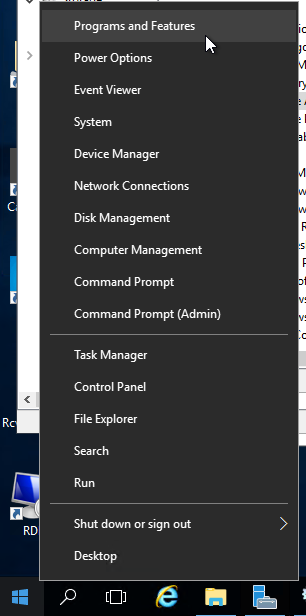
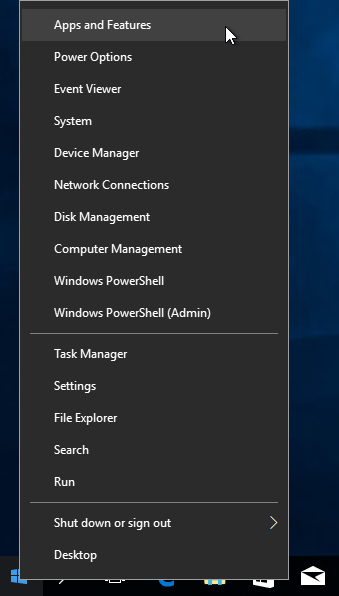
- Find Citrix 7.15 LTSR CU8 – Virtual Delivery Agent, and click Change or Modify (Windows 10 1703 and newer).
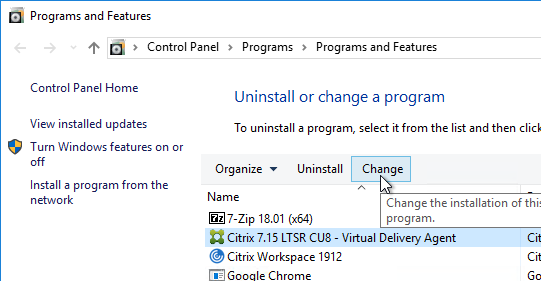
- Click Customize Virtual Delivery Agent Settings.
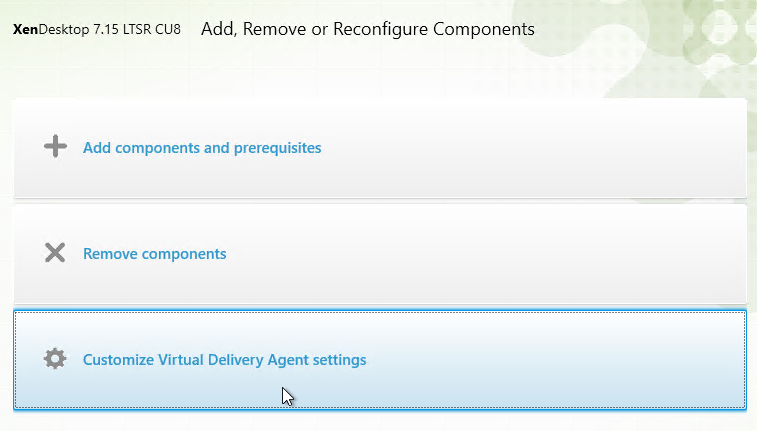
- Edit the Delivery Controllers, and click Next.
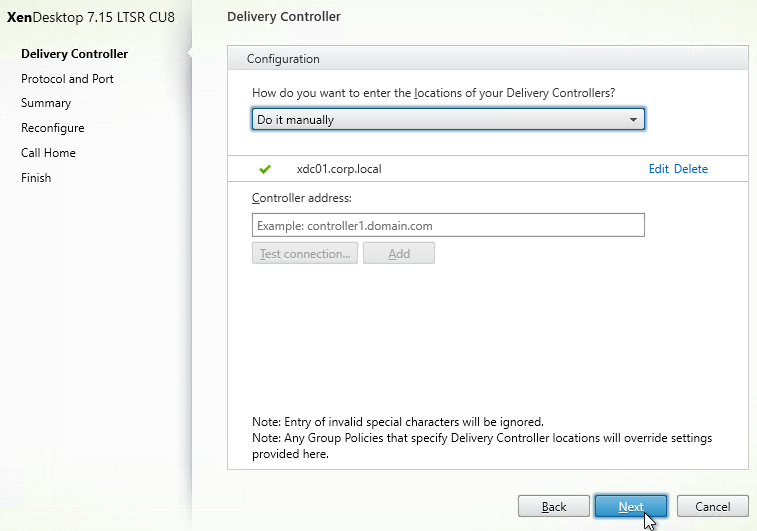
- On the Protocol and Port page, change the port number, and click Next.
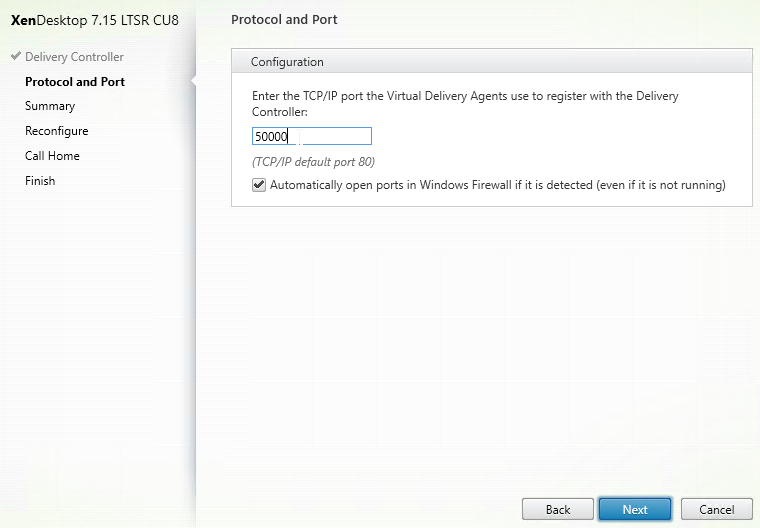
- In the Summary page, click Reconfigure.
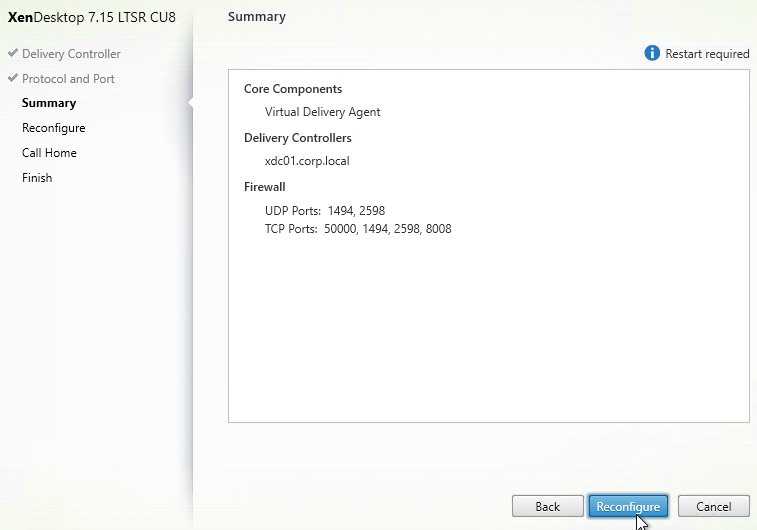
- If you see a Call Home page, click Connect, enter mycitrix.com credentials, and then click Next.
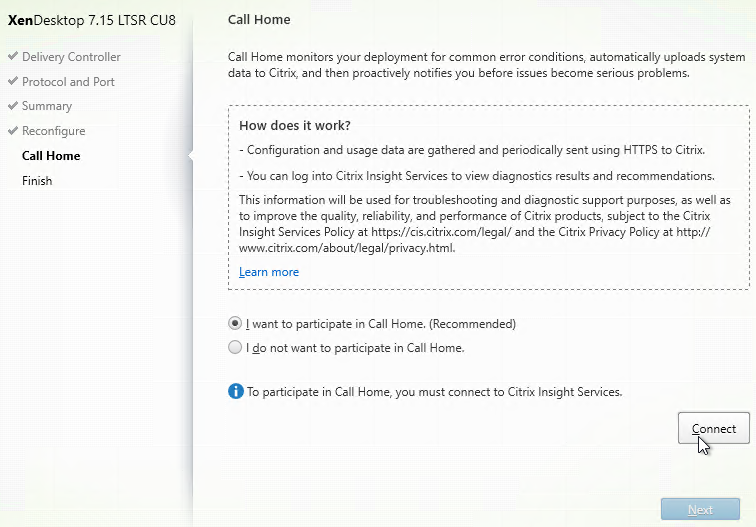
- In the Finish Reconfiguration page, click Finish to restart the machine.
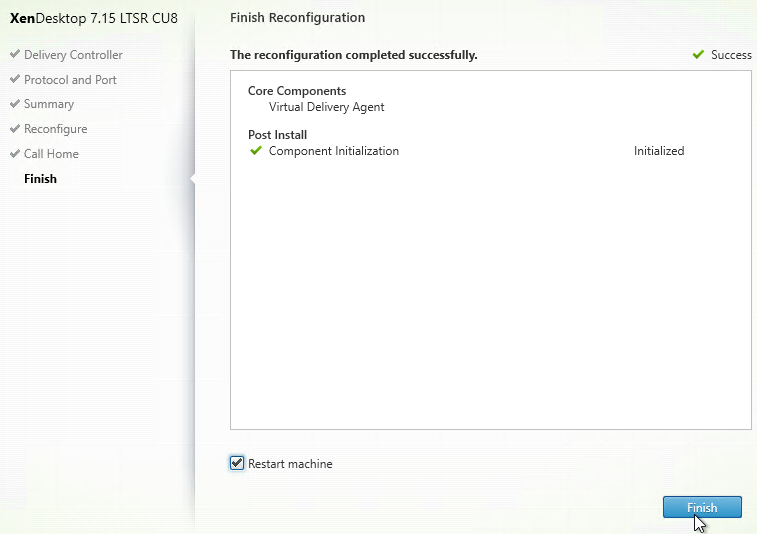
- You must also change the VDA registration port on the Delivery Controllers by running
C:\Program Files\Citrix\Broker\Service\BrokerService.exe -VDAPort
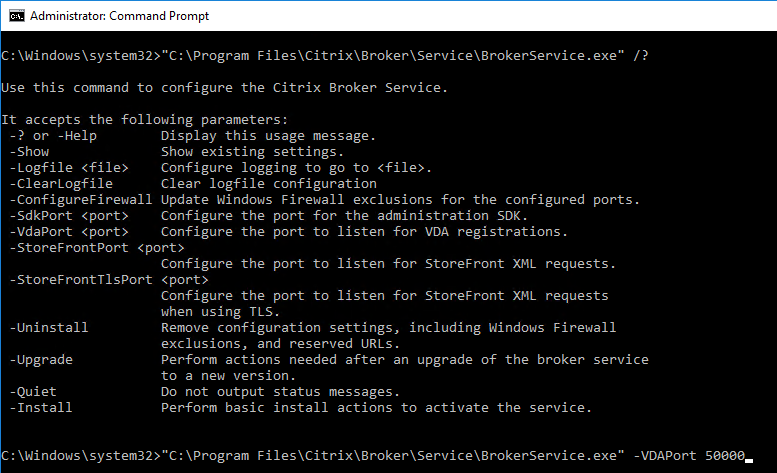
- For Local Host Cache, on the Delivery Controller, run
C:\Program Files\Citrix\Broker\Service\HighAvailabilityService.exe –VdaPort <CORRECT PORT #>. (Source = CTX229493 VDAs Do Not Register in LHC Mode When Registration Port is Not Set To Default)
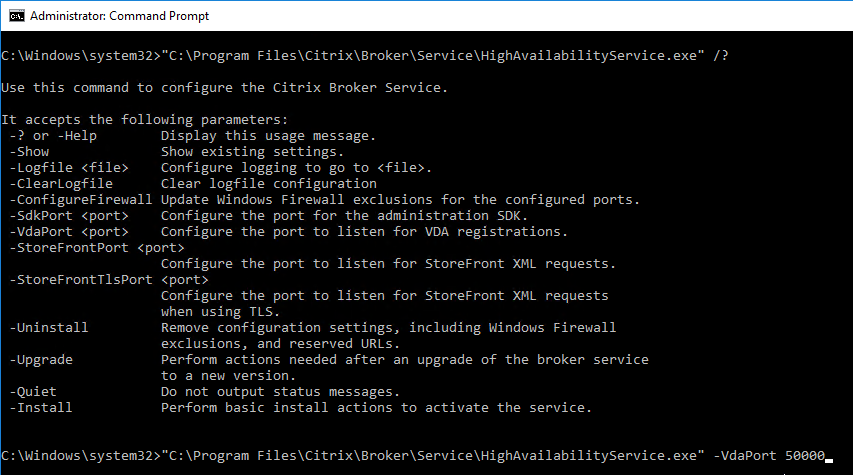
Verify that VDA registered with a Controller
- If you restart the Virtual Delivery Agent machine, or restart the Citrix Desktop Service…

- In Windows Logs > Application log, you should see an event 1012 from Citrix Desktop Service saying that it successfully registered with a controller.

- If you don’t see successful registration, then you’ll need to fix the ListOfDDCs registry key.
- See VDA registration with Controllers at Citrix Docs.
- See The Most Common VDA Registration Issues & Troubleshooting Steps at Citrix Blogs.
- You can also run Citrix’s Health Assistant on the VDA.


- See CTX220772 Technical Primer: VDA Registration for a very detailed explanation of the VDA Registration process.
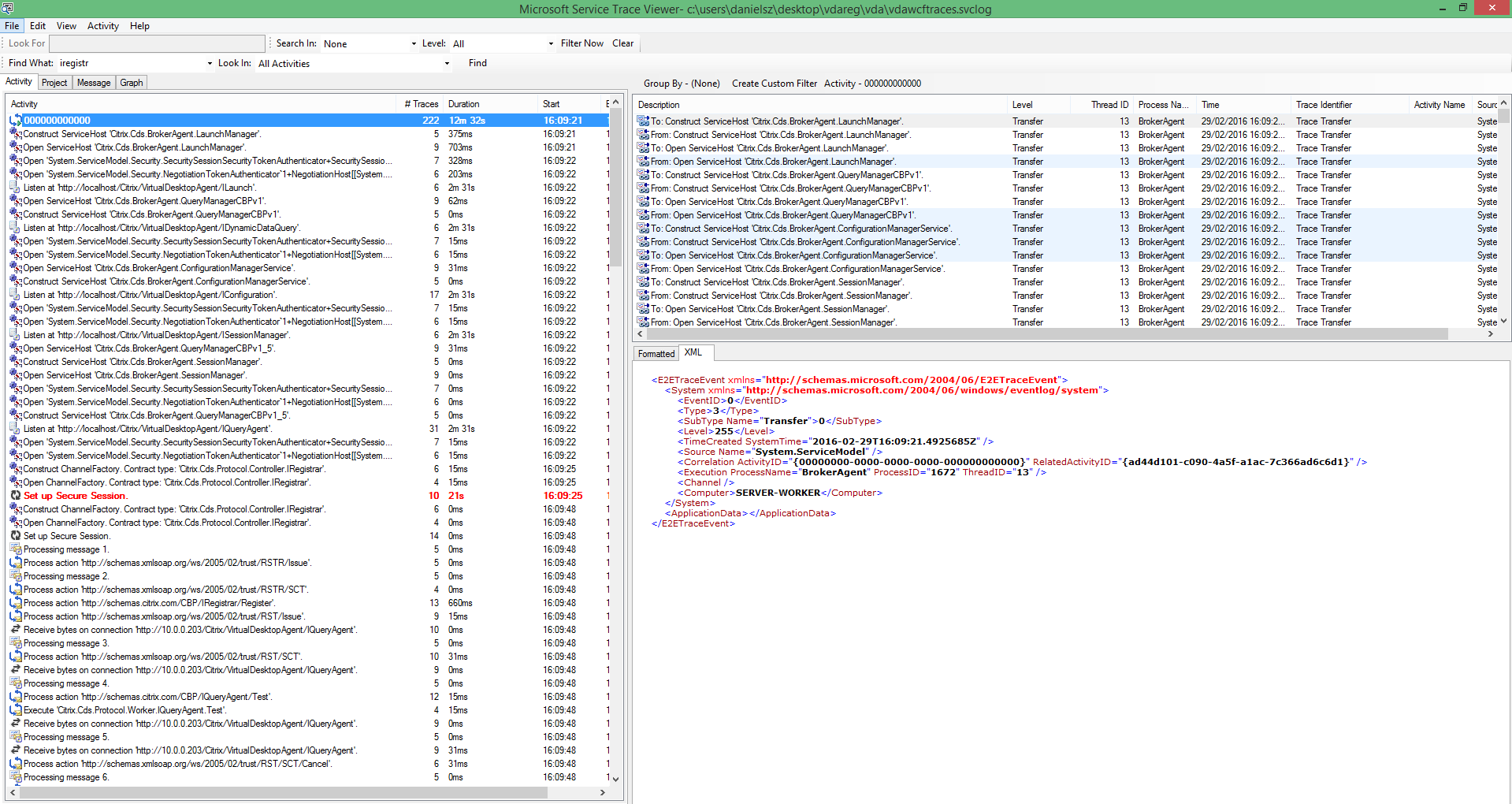
Citrix Workspace app LTSR
If you want to run Workspace app on the VDA machine, then upgrade it to Workspace app 1912 LTSR (19.12.7000).
VDA 7.15.9000 comes with Workspace app 1912.7000 LTSR.
- Download Citrix Workspace app 1912.7000.
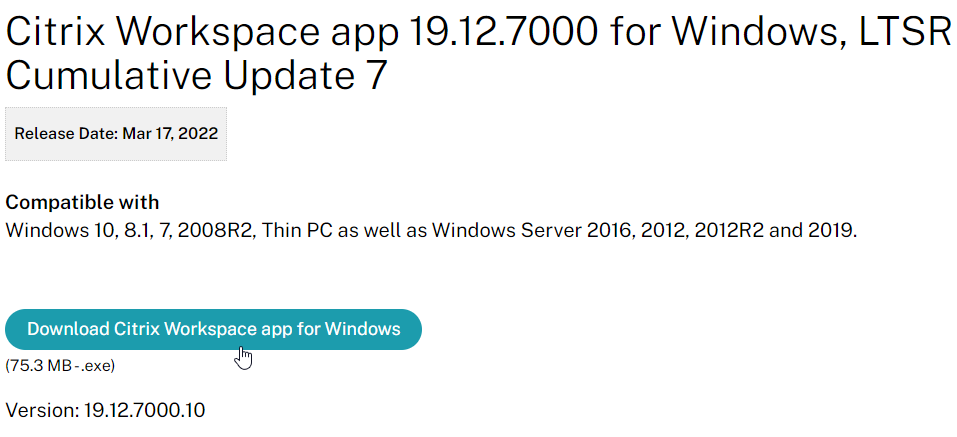
- On the VDA, as administrator, run the downloaded CitrixWorkspaceApp.exe.
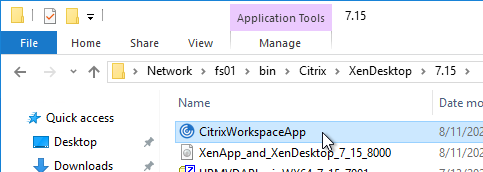
- In the Welcome to Citrix Workspace page, click Start.
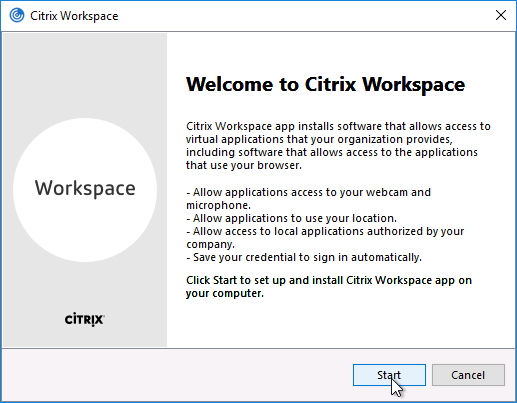
- In the License Agreement page, check the box next to I accept the license agreement, and click Next.
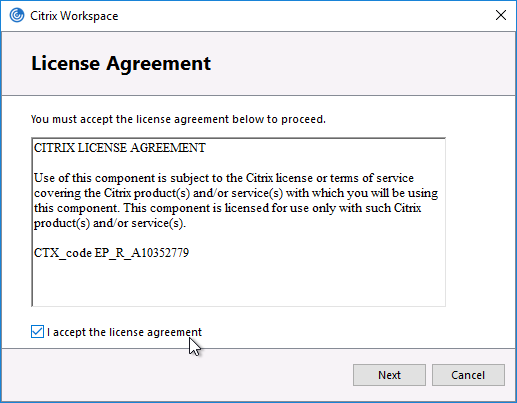
- In the Enable Single Sign-on page, check the box next to Enable single sign-on, and click Install.
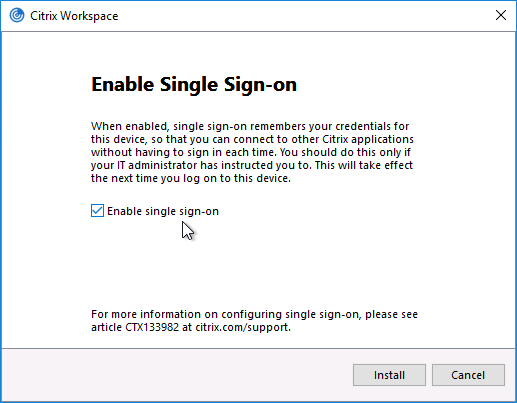
- In the Installation successful page, click Finish.
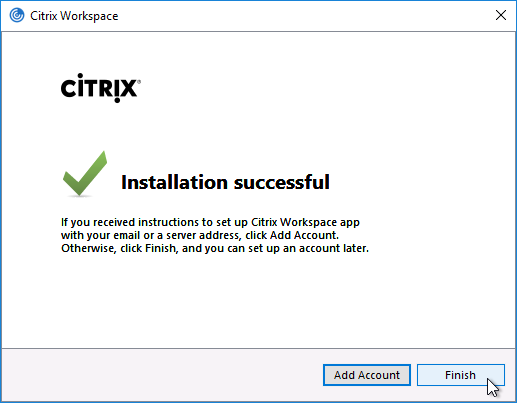
- Click Yes when asked to restart now.
- For configuration instructions, see the Workspace app article.
Citrix PDF Printer 7.11.0 for Workspace app for HTML5/Chrome
- To allow printing from Workspace app for HTML5/Chrome, install Citrix PDF Printer. Get it from the Citrix Workspace app for HTML5 download page in the Additional Components section. Note: this PDF Printer is only used by Workspace app for HTML5 and Workspace app for Chrome.
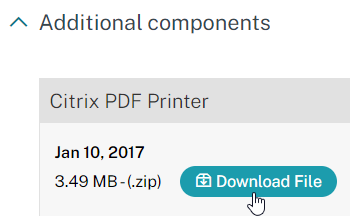
- Go to the extracted CitrixPDFPrinter_7.11.0 and run CitrixPDFPrinter64.msi.

- In the Please read the Citrix PDF printer License Agreement page, check the box next to I accept the terms, and click Install.
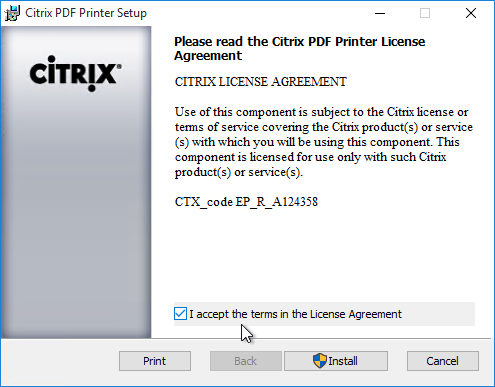
- In the Completed the Citrix PDF Universal Driver Setup Wizard page, click Finish.

- In Programs and Features (or Apps & Features), it is shown as version 7.11.0.11.
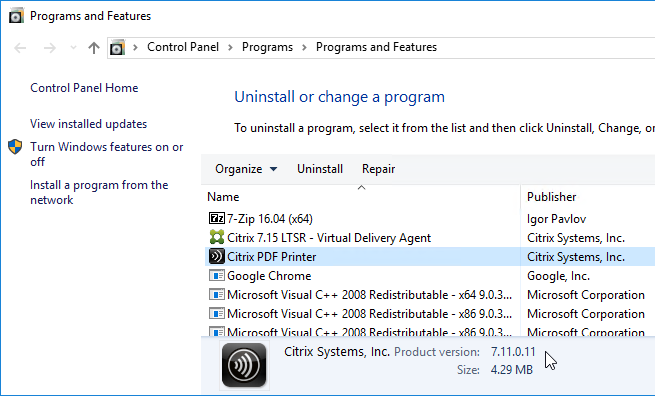
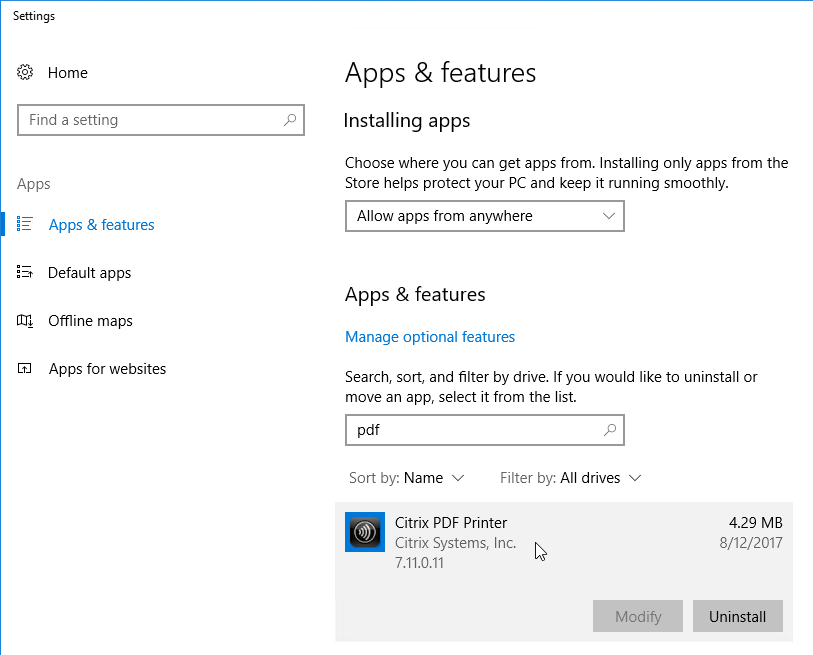
- Configure a Citrix Policy to enable the PDF printer. The setting is called Auto-create PDF Universal Printer in the user half of a Citrix Policy GPO.
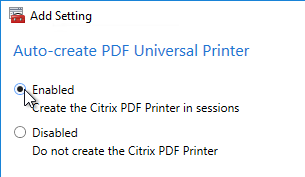
Citrix File Access 2.0.3 for Workspace app for Chrome OS
- If you support Workspace app for Chrome OS (Chromebook) and want published applications to open files on Google Drive, install Citrix File Access on the VDAs. Get it from the Citrix File Access for Chrome.
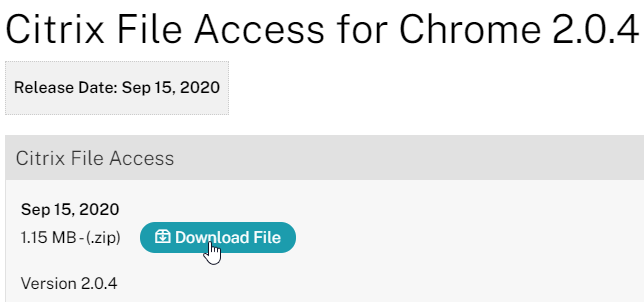
- Go to the extracted Citrix_File_Access_2.0.4 and run FileAccess.msi.

- In the Please read the File Access License Agreement page, check the box next to I accept the terms, and click Install.
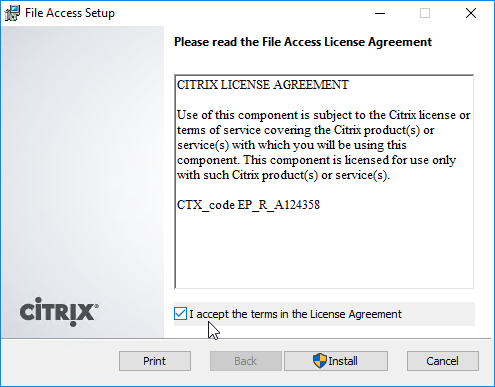
- In the Completed the File Access Setup Wizard page, click Finish.
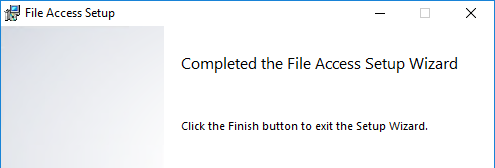
- File Access is listed in Apps & Features or Programs and Features as version 2.0.4.34.
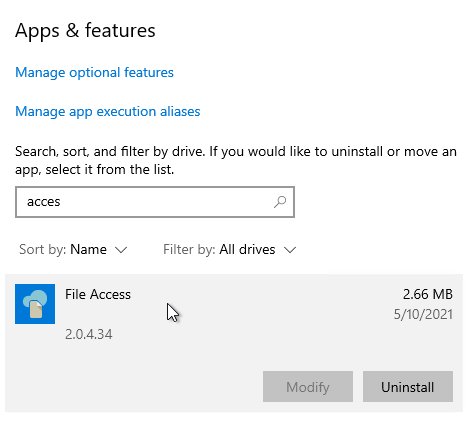
- File Access has a default list of supported file extensions. The list can be expanded by editing the registry on the VDA. See CTX219983 Receiver for Chrome Error: Invalid command line arguments: Unable to open the file as it has an unsupported extension.
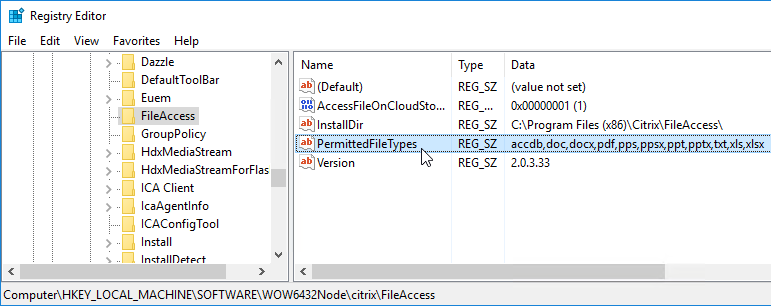
- To open a file from Google Drive, right-click the file and open the file using Citrix Workspace app.
Framehawk Configuration
To enable Framehawk, see https://www.carlstalhood.com/citrix-policy-settings/#framehawkconfig
Remote Desktop Licensing Configuration
On 2012 R2 and newer RDSH, the only way to configure Remote Desktop Licensing is using group policy (local or domain). This procedure also works for 2008 R2 RDSH. This procedure is not needed on virtual desktops.
- For local group policy, run gpedit.msc. Alternatively, you can configure this in a domain GPO.

- Go to Computer Configuration > Administrative Templates > Windows Components > Remote Desktop Services > Remote Desktop Session Host > Licensing.
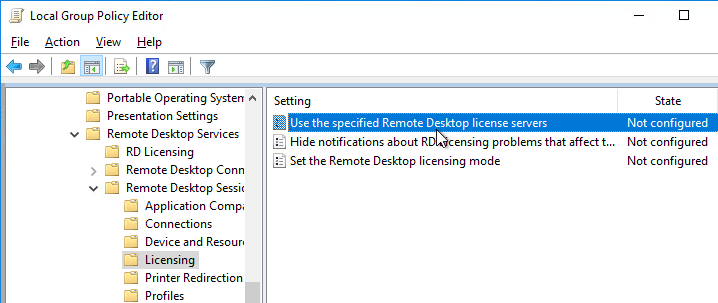
- Double-click Use the specified Remote Desktop license servers. Change it to Enabled, and enter the names of the RDS Licensing Servers (typically installed on XenDesktop Controllers). Click OK.
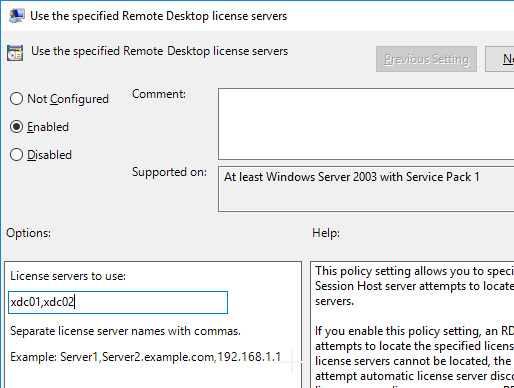
- Double-click Set the Remote Desktop licensing mode. Change it to Enabled and select Per User. Click OK.
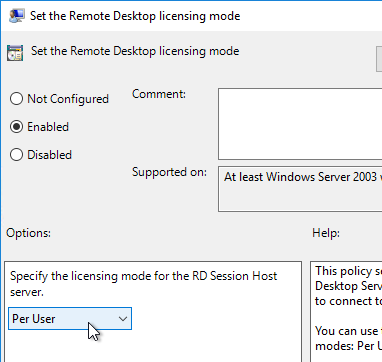
- Optionally, you can install the Remote Desktop Licensing Diagnoser Tool. In the Server Manager > Add Roles and Features Wizard, on the Features page, expand Remote Server Administration Tools, expand Role Administration Tools, expand Remote Desktop Services Tools, and select Remote Desktop Licensing Diagnoser Tool. Then Finish the wizard.
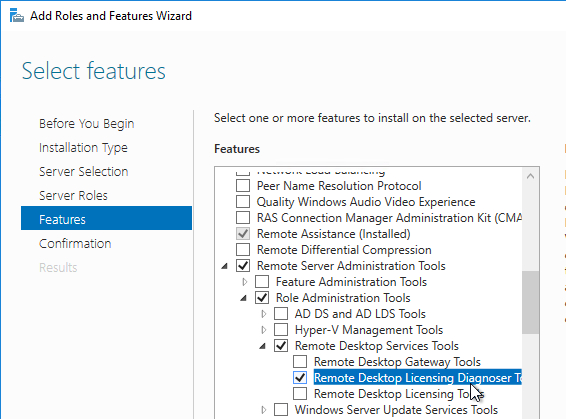
- If it won’t install from Server Manager, you can install it from PowerShell by running
Install-WindowsFeature rsat-rds-licensing-diagnosis-ui.

- In Server Manager, open the Tools menu, expand Remote Desktop Services (or Terminal Services), and click Remote Desktop Licensing Diagnoser.
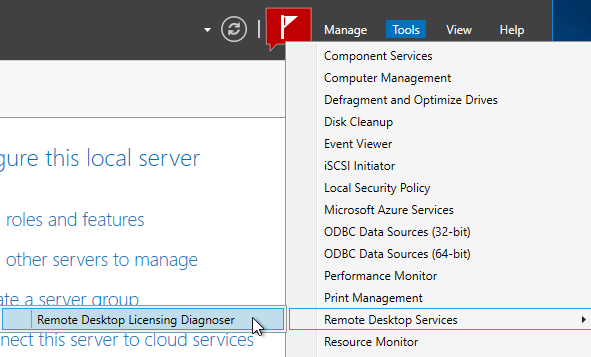
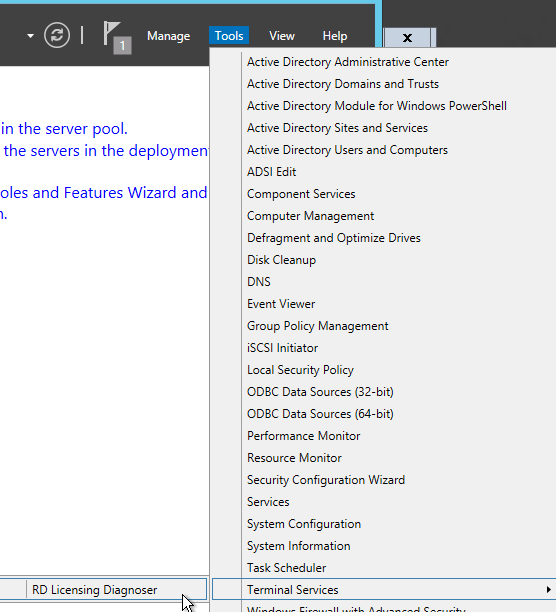
- The Diagnoser should find the license server, and indicate the licensing mode. If you’re configured for Per User licenses, then it’s OK if there are no licenses installed on the Remote Desktop License Server.
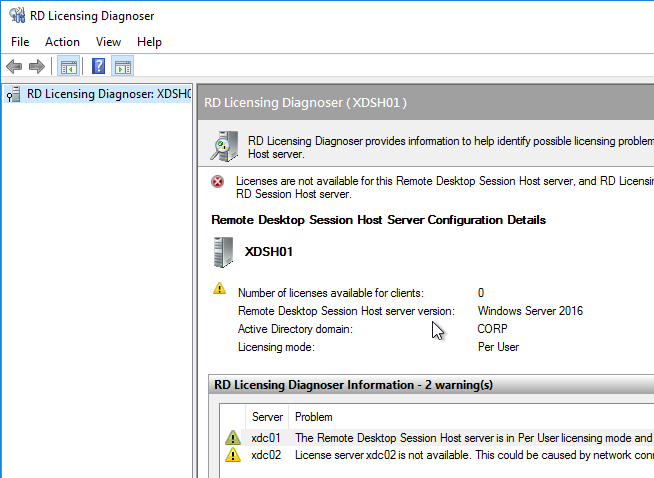
Several people in Citrix Discussions reported the following issue: If you see a message about RD Licensing Grace Period has expired even though RD Licensing is properly configured, see Eric Verdumen No remote Desktop Licence Server availible on RD Session Host server 2012. The solution was to delete the REG_BINARY in HKEY_LOCAL_MACHINE\SYSTEM\CurrentControlSet\Control\Terminal Server\RCM\GracePeriod only leaving the default. You must take ownership and give admin users full control to be able to delete this value.
C: Drive Permissions
This section is more important for shared VDAs like RDSH (Windows Server 2008 R2, Windows Server 2012 R2, and Windows Server 2016).
The default permissions allow users to store files on the C: drive in places other than their profile.
- Open the Properties dialog box for C:.
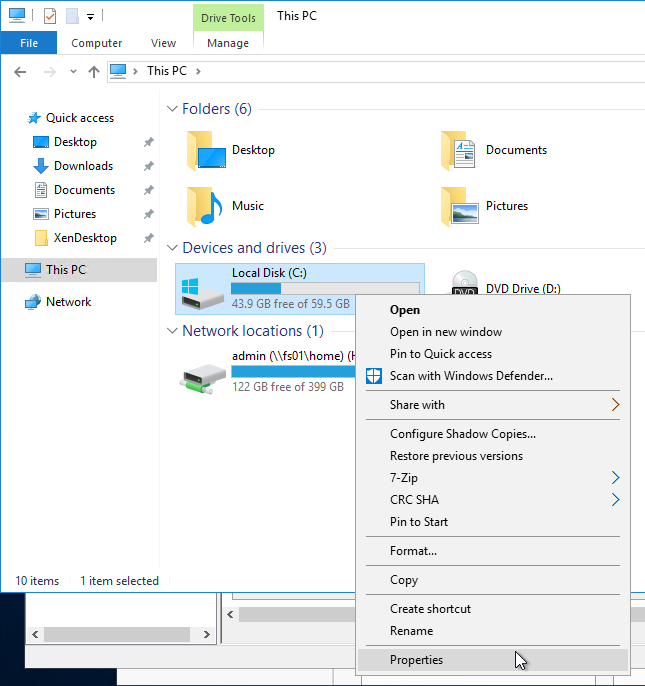
- On the Security tab, click Advanced.
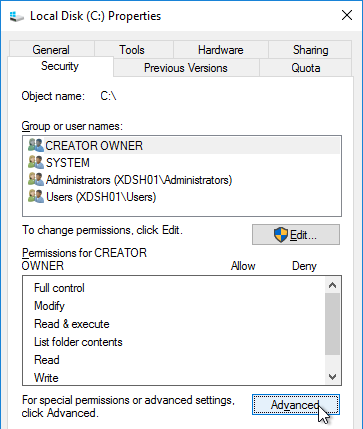
- If UAC is enabled, click Change permissions.
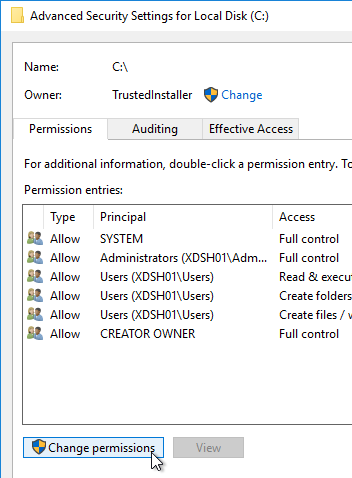
- Highlight the line containing Users and Create Folders, and click Remove.
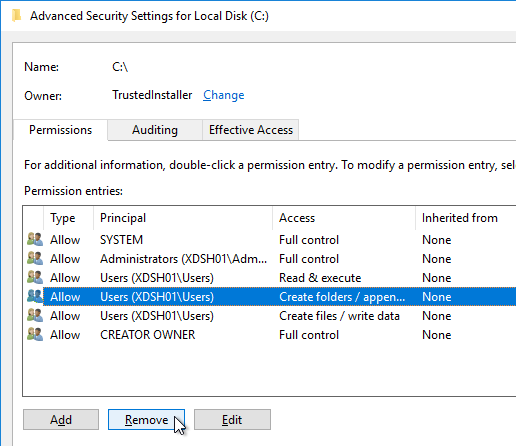
- Highlight the line containing Users and Create files (or Special), and click Remove. Click OK.
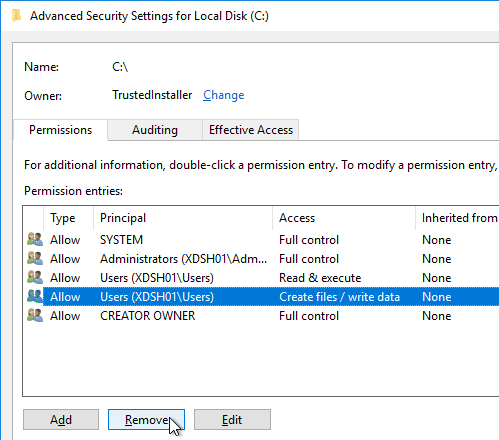
- Click Yes to confirm the permissions change.
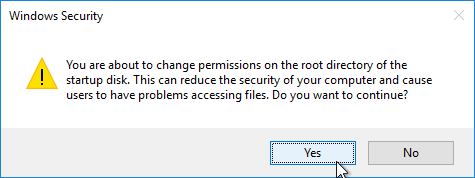
- If you see any of these Error Applying Security windows, click Continue. This window should appear multiple times.
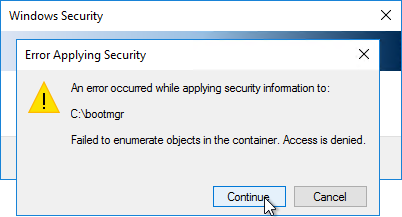
- Click OK to close the C: drive properties.
Pagefile
If this image will be converted to a Provisioning Services vDisk, then you must ensure the pagefile is smaller than the cache disk. For example, if you allocate 20 GB of RAM to your Remote Desktop Session Host, and if the cache disk is only 15 GB, then Windows will have a default pagefile size of 20 GB, and Provisioning Services will be unable to move it to the cache disk. This causes Provisioning Services to cache to server instead of caching to your local cache disk (or RAM).
- Open System. In 2012 R2 and newer, you can right-click the Start button, and click System. Note: in Windows 10 1703 and newer, this method no longer opens the correct tool.
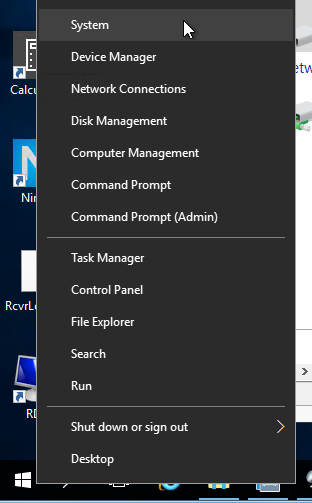
- Another option is to open File Explorer, right-click This PC, and click Properties. This works in Windows 10 1703.
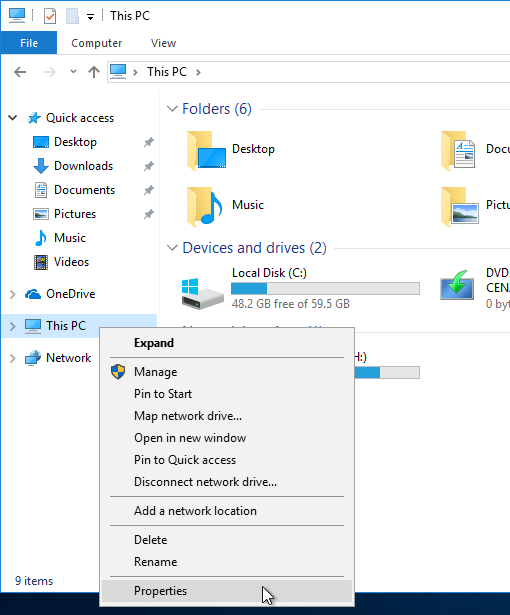
- Click Advanced system settings.
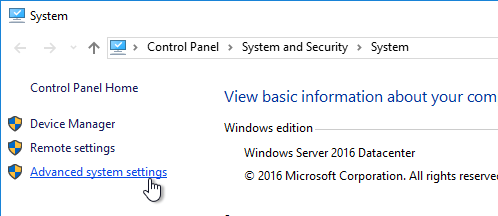
- On the Advanced tab, click the top Settings button.
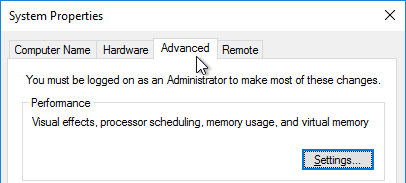
- On the Advanced tab, click Change.
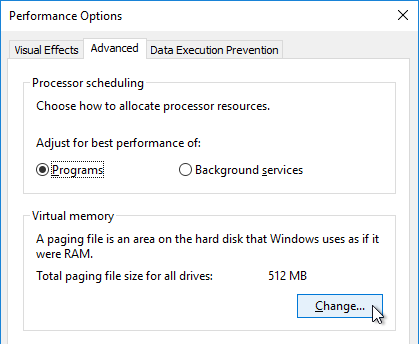
- Uncheck the box next to Automatically manage paging file size for all drives. Then either turn off the pagefile, or set the pagefile to be smaller than the cache disk. Don’t leave it set to System managed size. Click OK several times.
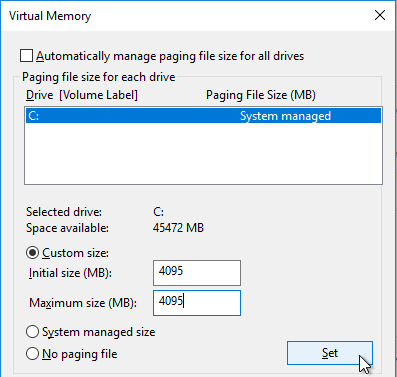
Direct Access Users
When Citrix Virtual Delivery Agent is installed on a machine, non-administrators can no longer RDP to the machine. A new local group called Direct Access Users is created on each Virtual Delivery Agent. Add your non-administrator RDP users to this local group so they can RDP directly to the machine.
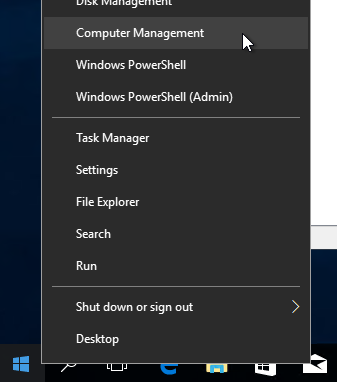
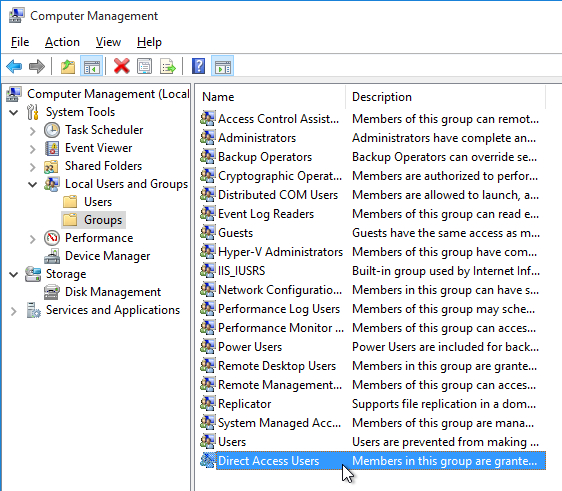
From CTX228128 What is the HKLM\Software\Citrix\PortICA\DirectAccessUsers registry function: The HKLM\Software\Citrix\PortICA\DirectAccessUsers registry key determines which Local group the VDA references to determine if a user should be allowed Unbrokered RDP access. Members of the Local Administrators group will always be granted access. If the Registry Key does not exist, or gets deleted, VDA will always allow the Unbrokered RDP Connection. The Registry key and local group are created as part of the VDA installation process.
Windows Profiles v3/v4/v5/v6
Roaming Profiles are compatible only between the following client and server operating system pairs. The profile version is also listed.
- v6 = Windows 10 (1607 and 1703) and Windows Server 2016
- v5 = Windows 10 (1511 and older)
- v4 = Windows 8.1 and Windows Server 2012 R2
- v3 = Windows 8 and Windows Server 2012
- v2 = Windows 7 and Windows Server 2008 R2
- v2 = Windows Vista and Windows Server 2008
For Windows 2012 R2, install Microsoft hotfix 2890783, and set the UseProfilePathExtensionVersion registry value to 1.
CTX230343 Reset Profile Options Is Greyed Out In Citrix Director states that the UseProfilePathExtensionVersion registry value is required on Windows 2012 R2 to enable Director users to reset profiles.
Registry
Black Screen when launch Published Apps on Windows Server 2016
From CTX225819 When Launching an Application Published from Windows Server 2016, a Black Screen Appears for Several Seconds Before Application is Visible: Citrix and Microsoft have worked together together to deliver code fixes for both Windows Server 2016 and XenApp. Microsoft is targeting their KB4034661 patch for the third week of August 2017. This fix requires a registry edit to enable.
- Key =
HKLM\SOFTWARE\Citrix\Citrix Virtual Desktop Agent- Value (DWORD) =
DisableLogonUISuppression= 0
- Value (DWORD) =
Published Explorer
From Citrix CTX128009 Explorer.exe Fails to Launch: When publishing the seamless explorer.exe application, the session initially begins to connect as expected. After the loading, the dialog box disappears, and the Explorer application fails to appear. On the VDA, use the following registry change to set the length of time a client session waits before disconnecting the session:
- Key =
HKLM\SYSTEM\CurrentControlSet\Control\Citrix\wfshell\TWI- Value (DWORD) =
LogoffCheckerStartupDelayInSeconds= 10 (Hexadecimal)
- Value (DWORD) =
Blank Start Menu Icons
With VDA 7.15 Update 1, the icons on the Start Menu of Windows 2012 R2 and Windows 2016 are sometimes blank.
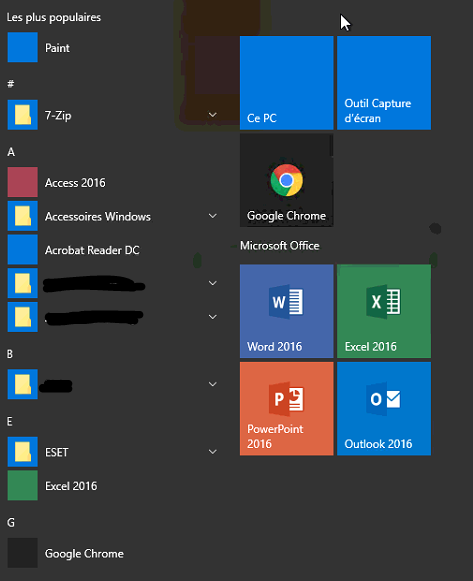
To workaround this issue, use Group Policy Preferences to set the following registry value at every logon:
- Key =
HKCU\Software\Microsoft\Windows\CurrentVersion\ImmersiveShell\StateStore- Value (DWORD) =
ResetCache= 1
- Value (DWORD) =
Screen Saver
From Citrix CTX205214 Screensaver Not Working in XenDesktop: By default, Screen Saver doesn’t work on Desktop OS. To enable it, on the VDA, configure the following registry value:
- Key =
HKEY_LOCAL_MACHINE\SOFTWARE\Citrix\Graphics- Value (DWORD) =
SetDisplayRequiredMode= 0
- Value (DWORD) =
Smart Card
From CTX231942 Windows 10 April 2018 Update (v1803) – Citrix Known Issues – Smart Card Service (SCardSvr) will run only if a Smart Card reader is connected. As ICA sessions redirect the Smart Card, it finds the service not to be running and fails. 💡
- Key =
HKEY_LOCAL_MACHINE\Software\WOW6432Node\Microsoft\Cryptography\Calais- Value (DWORD) =
AllowServiceAccessWithNoReaders= 1
- Value (DWORD) =
Logon Disclaimer Window Size
From XenApp 7.8 – Session Launch Security/Warning Login Banner at Citrix Discussions: If your logon disclaimer window has scroll bars, set the following registry values:
- Key =
HKEY_LOCAL_MACHINE\Software\Wow6432node\Citrix\CtxHook\AppInit_DLLS\Multiple Monitor Hook- Value (DWORD) =
LogonUIWidth= 300 - Value (DWORD) =
LogonUIHeight= 200
- Value (DWORD) =
Login Timeout
From Citrix CTX203760 VDI Session Launches Then Disappears: XenDesktop, by default, only allows 180 seconds to complete a logon operation. The timeout can be increased by setting the following:
- Key =
HKLM\SOFTWARE\Citrix\PortICA- Value (DWORD) =
AutoLogonTimeout= decimal 240 or higher (up to 3599).
- Value (DWORD) =
Also see Citrix Discussions Machines in “Registered” State, but VM closes after “Welcome” screen.
From Citrix CTX138404 Application Connection Starts but Disappears after Timeout: after loading the application, the dialog box disappears and the application fails to appear.
- Key =
HKEY_LOCAL_MACHINE\SYSTEM\CurrentControlSet\Control\Citrix\wfshell\TWI- Value (DWORD) =
ApplicationLaunchWaitTimeoutMS= decimal 60000
- Value (DWORD) =
HDX Flash
From Citrix Knowledgebase article CTX139939 – Microsoft Internet Explorer 11 – Citrix Known Issues: The registry key value IEBrowserMaximumMajorVersion is queried by the HDX Flash service to check for maximum Internet Explorer version that HDX Flash supports. For Flash Redirection to work with Internet Explorer 11 set the registry key value IEBrowserMaximumMajorVersion to 11 on the machine where HDX flash service is running. In case of XenDesktop it would be the machine where VDA is installed.
- Key =
HKLM\SOFTWARE\Wow6432Node\Citrix\HdxMediaStreamForFlash\Server\PseudoServer- Value (DWORD) =
IEBrowserMaximumMajorVersion= 11 (Decimal)
- Value (DWORD) =
From Citrix Discussions: Add the DWORD FlashPlayerVersionComparisonMask=0 on the VDA under HKLM\Software\Wow6432Node\Citrix\HdxMediaStreamForFlash\Server\PseudoServer. This disables the Flash major version checking between the VDA and Client Device.
Workspace app for HTML5/Chrome OS Enhanced Clipboard
From About Citrix Receiver for Chrome 1.9 at Citrix Docs: To enable enhanced clipboard support, create a REG_SZ registry value HKEY_LOCAL_MACHINE\SYSTEM\CurrentControlSet\Control\Citrix\wfshell\Virtual Clipboard\Additional Formats\HTML Format\Name=”HTML Format”. Create any missing registry keys. This applies to both virtual desktops and Remote Desktop Session Hosts.
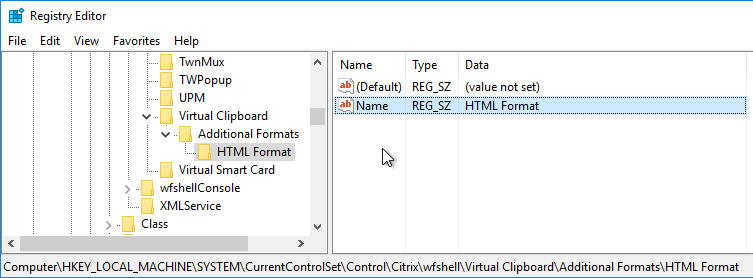
Workspace app for HTML5/Chrome OS Upload Folder
The Worksspace app for HTML5 (or Chrome OS) lets upload files.

By default, the user is prompted to select a upload location. If you use the Upload feature multiple times, the last selected folder is not remembered.
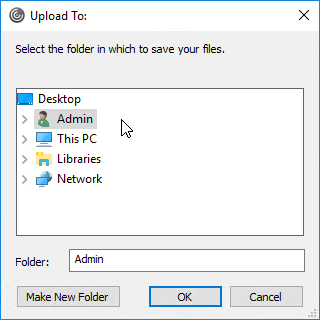
Citrix CTX217351 How to customize file upload and download using Workspace app for HTML5 and Chrome. You can specify a default uploads location by editing HKLM\Software\Citrix\FileTransfer\UploadFolderLocation on the VDA. Environment variables are supported. When this value is configured, users are no longer prompted to select an upload location. The change takes effect at next logon.
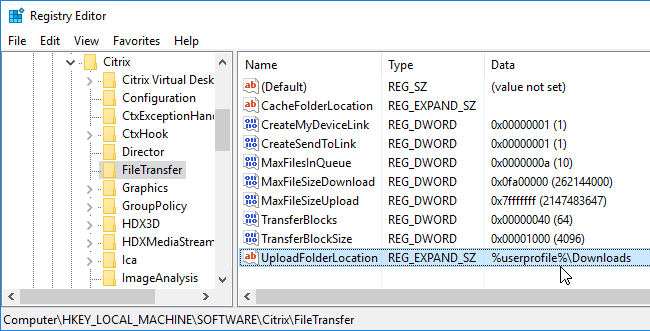
Note: HTML5/Chrome Workspace app also adds a Save to My Device location to facilitate downloads.
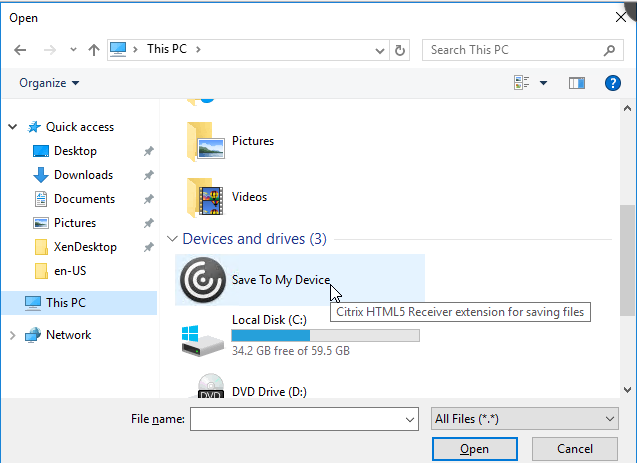
4K Monitors
From Citrix Knowledgebase article CTX218217 Unable to span across multiple monitors after upgrade to 7.11 VDA, Black/Blank screen appears on the monitors while connecting to ICA session: .
- For VDA 7.11 and newer, calculate the video memory that is required for monitors using the following formula:
SumOfAllMons (Width * Height) * 4 / 0.3, where width and height are resolution of the monitor. Note: There is no hard and fast rule that will work for all cases.Example: Consider the resolution of monitor 1 is 1920*1200 and monitor 2 is 1366*768. Then SumOfAllMons will be (1920*1200 + 1366*768)
- CTX115637 Citrix Session Graphics Memory Reference describes how multi-monitor resolution is determined.
- Open the registry (regedit) and navigate to: HKEY_LOCAL_MACHINE\SYSTEM\CurrentControlSet\services\vbdenum
- Increase the value of “MaxVideoMemoryBytes” REG_DWORD value to the above calculated memory.
- Reboot the VDA.
Citrix Policies also control graphics performance.
COM Port Threads
CTX212090 COM Port Intermittently Inaccessible During ICA Sessions: increase the default value of “MaxThreads” under the registry key HKEY_LOCAL_MACHINE\SYSTEM\CurrentControlSet\services\picaser\Parameters from 20 to a value greater than the number of COM port connections you want to support. For example, if a XenApp server supports 100 sessions and each session opens two COM ports, the value of “MaxThreads” should be greater than 200.
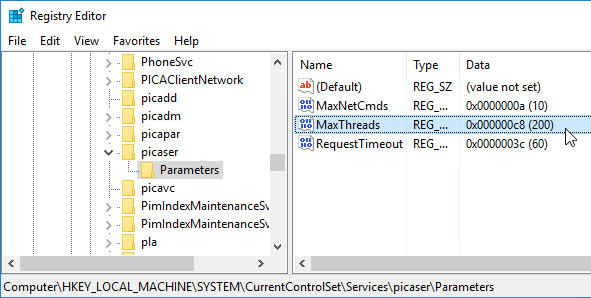
NVIDIA GRID License
Allow NVIDIA GRID License to apply after the session is started. (Source = Jan Hendrik Meier NVIDIA GRID license not applied before the user connects – License Restriction will not be removed until the user reconnects)
- Key =
HKLM\SOFTWARE\NVIDIA Corporation\Global\GridLicensing- Value (DWORD) =
IgnoreSP= 1
- Value (DWORD) =
Legacy Client Drive Mapping
Citrix CTX127968 How to Enable Legacy Client Drive Mapping Format on XenApp: Citrix Client Drive Mapping no longer uses drive letters and instead they appear as local disks. This is similar to RDP drive mapping.
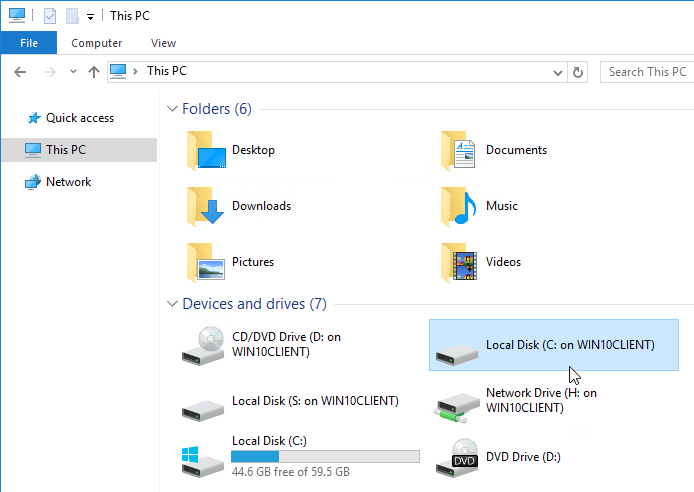
The old drive letter method can be enabled by setting the registry value:
- Key =
HKEY_LOCAL_MACHINE\SOFTWARE\Citrix\UncLinks(create the key)- Value (DWORD) =
UNCEnabled= 0
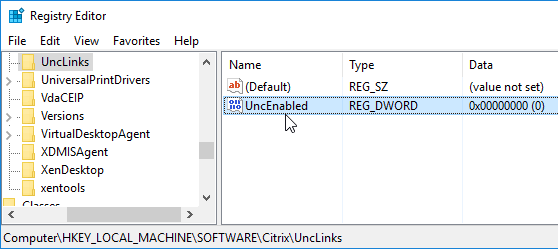
- Value (DWORD) =
When you reconnect, the client drives will be mapped as drive letters (starts with V: and goes backwards).
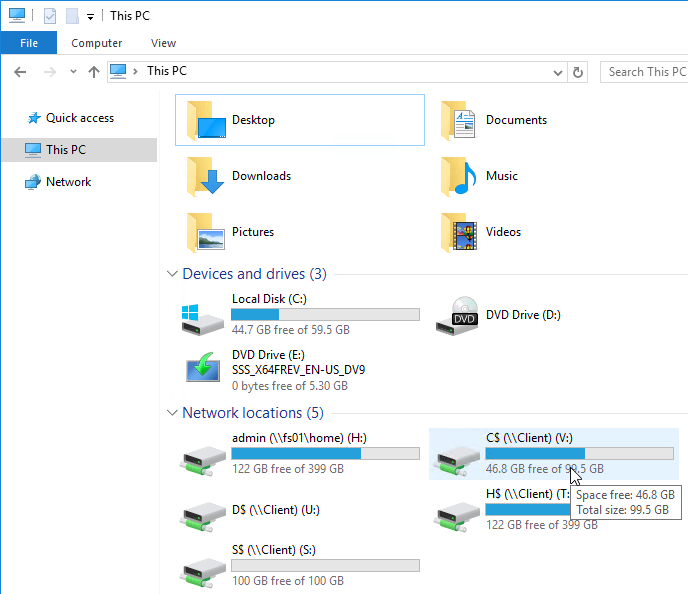
Print Driver for Non-Windows Clients
This section applies to Windows 8.1/2012 and newer VDAs.
From CTX140208 Client printing from Mac and Linux clients on Windows 10, Server 2012 R2, and Server 2016. By default, Non-Windows clients cannot map printers due to a missing print driver on the VDA machine.
- Requirements:
- Internet Access
- Windows Update service enabled
- In Windows 10 1803+, open Printers & scanners. On the right (or scroll down) is a link to Print Server Properties.
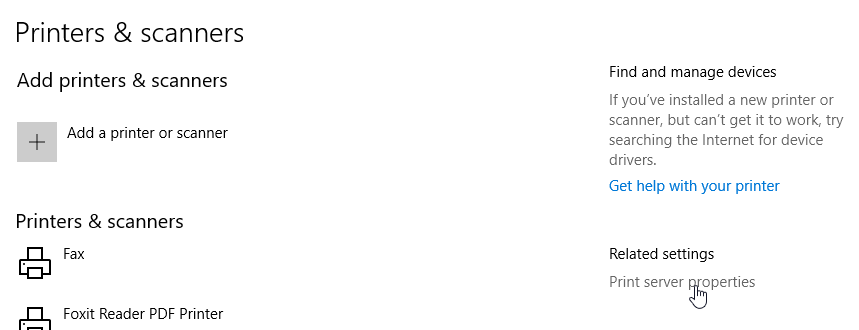
- In older versions of Windows, you can get to Print server properties from Devices and Printers.
- In Windows prior to Windows 10 1703, click Start, and run Devices and Printers.
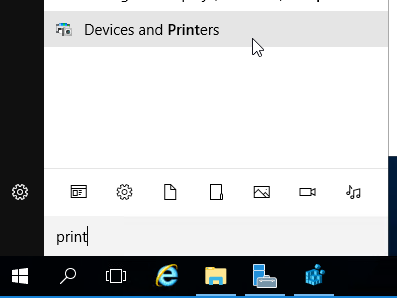
- In Windows 10 1703, open Printers & scanners, then scroll down, and click Devices and printers.
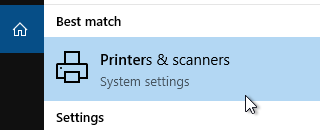
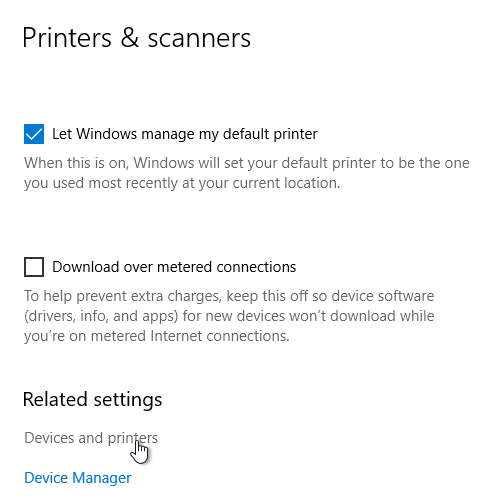
- In the Printers section, highlight a local printer (e.g. Microsoft XPS Document Writer). Then in the toolbar, click Print server properties.
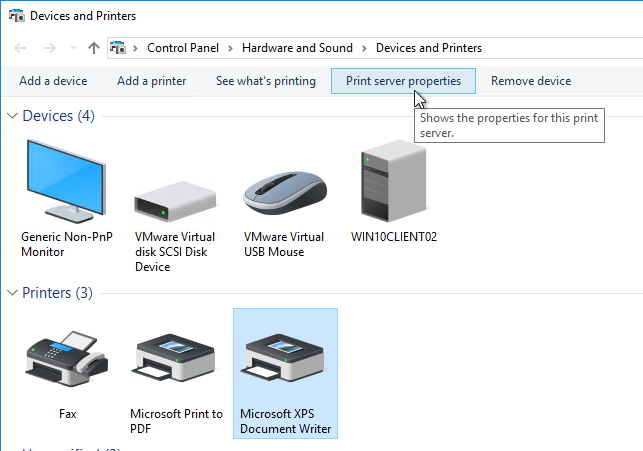
- In Windows prior to Windows 10 1703, click Start, and run Devices and Printers.
- In the Print Server Properties window, switch to the Drivers tab. Click Change Driver Settings.
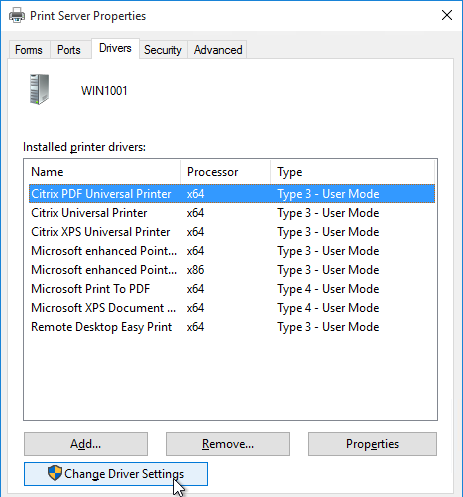
- Then click Add.
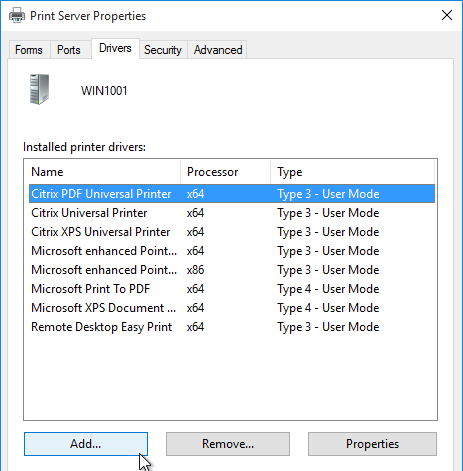
- In the Welcome to the Add Printer Driver Wizard page, click Next.
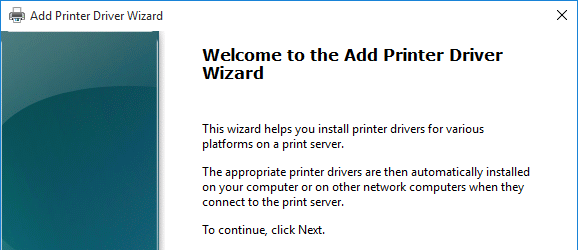
- In the Processor Selection page, click Next.
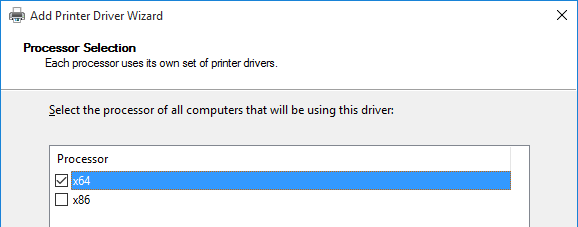
- In the Printer Driver Selection page, click Windows Update. The driver we need won’t be in the list until you click this button. Internet access is required.
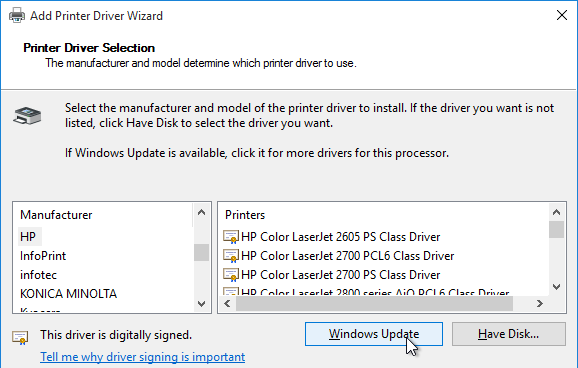
- Once Windows Update is complete, highlight HP on the left, and then select HP Color LaserJet 2800 Series PS (Microsoft) on the right. Click Next.
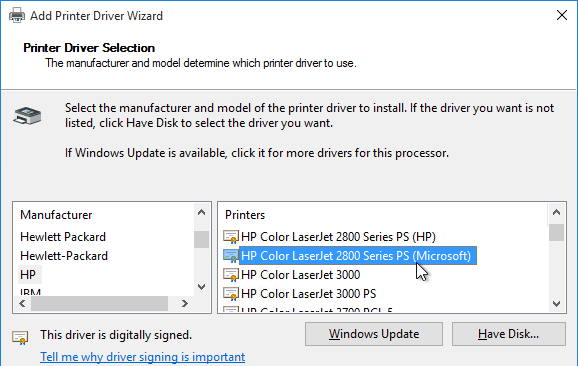
- In the Completing the Add Printer Driver Wizard page, click Finish.
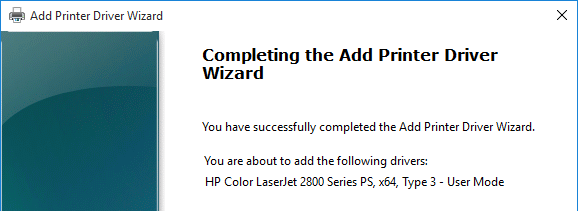
SSL for VDA
If you intend to use HTML5 Workspace app internally, install certificates on the VDAs so the WebSockets (and ICA) connection will be encrypted. Internal Workspace apps will not accept clear text WebSockets. External users don’t have this problem since they are SSL-proxied through Citrix Gateway. Notes:
- Each Virtual Delivery Agent needs a machine certificate that matches the machine name. This is feasible for a small number of persistent VDAs. For non-persistent VDAs, you’ll need some automatic means for creating machine certificates every time they reboot.
- As detailed in the following procedure, use PowerShell on the Controller to enable SSL for the Delivery Group. This forces SSL for every VDA in the Delivery Group, which means every VDA in the Delivery Group must have SSL certificates installed.
The following instructions for manually enabling SSL on VDA can be found at Configure TLS on a VDA using the PowerShell script at Citrix Docs.
- On the VDA machine, run mmc.exe.
- Add the Certificates snap-in.
- Point it to Local Computer.
- Request a certificate from your internal Certificate Authority. You can use either the Computer template or the Web Server template.
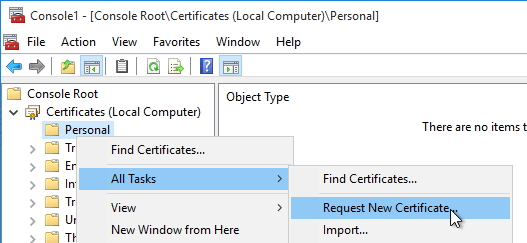
- You can also use group policy to enable Certificate Auto-Enrollment for the VDA computers.
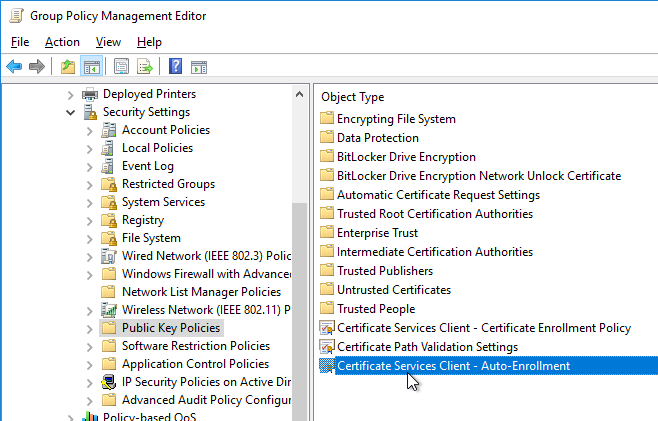
- You can also use group policy to enable Certificate Auto-Enrollment for the VDA computers.
- Browse to the XenApp/XenDesktop 7.15.9000 LTSR ISO. In the Support\Tools\SslSupport folder, shift+right-click the Enable-VdaSSL.ps1 script, and click Copy as path.
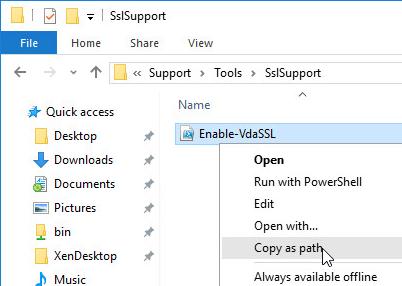
- Run PowerShell as administrator (elevated).
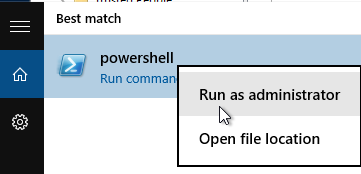
- Run the command Set-ExecutionPolicy unrestricted. Enter Y to approve.

- In the PowerShell prompt, type in an ampersand (&), and a space.
- Right-click the PowerShell prompt to paste in the path copied earlier.
- At the end of the path, type in
-Enable - If there’s only one certificate on this machine, press Enter.

- If there are multiple certificates, you’ll need to specify the thumbprint of the certificate you want to use. Open the Certificates snap-in, open the properties of the machine certificate you want to use, and copy the Thumbprint from the Details tab.
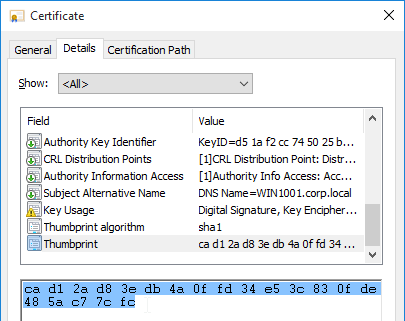 In the PowerShell prompt, at the end of the command, enter
In the PowerShell prompt, at the end of the command, enter‑CertificateThumbPrint, add a space, and type quotes (").Right-click the PowerShell prompt to paste the thumbprint.Type quotes (") at the end of the thumbprint. Then remove all spaces from the thumbprint. The thumbprint needs to be wrapped in quotes.

- If this VDA machine has a different service already listening on 443 (e.g. IIS), then the VDA needs to use a different port for SSL connections. At the end of the command in the PowerShell prompt, enter
-SSLPort 444or any other unused port.

- There are additional switches to specify minimum SSL Version and Cipher Suites. Also see Citrix CTX226049 Disabling Triple DES on the VDA breaks the VDA SSL connection.
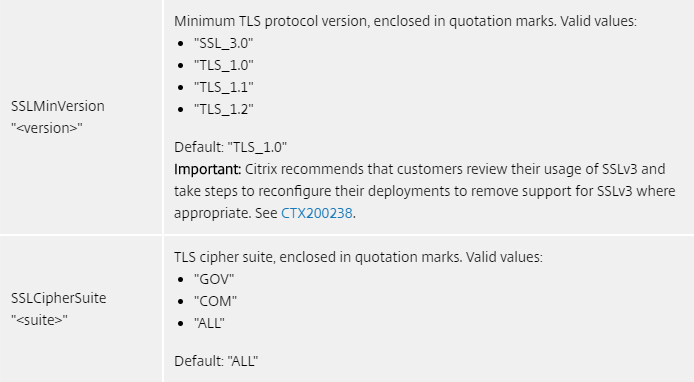
- Press <Enter> to run the Enable-VdaSSL.ps1 script.
- Press <Y> twice to configure the ACLs and Firewall.
- You might have to reboot before the settings take effect.
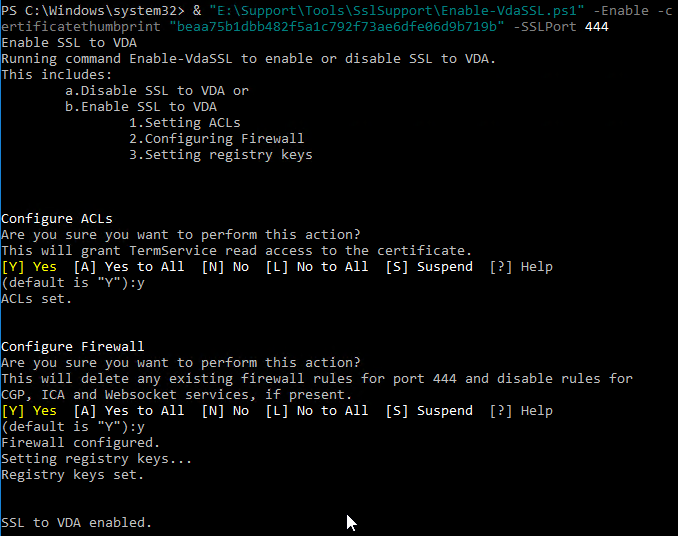
- Login to a Controller, and run PowerShell as Administrator (elevated).
- Run the command
asnp Citrix.*

- Enter the command:
Get-BrokerAccessPolicyRule -DesktopGroupName '<delivery-group-name>' | Set-BrokerAccessPolicyRule ‑HdxSslEnabled $true
where <delivery-group-name> is the name of the Delivery Group containing the VDAs.

- You can run
Get-BrokerAccessPolicyRule -DesktopGroupName '<delivery-group-name>'to verify that HDX SSL is enabled.
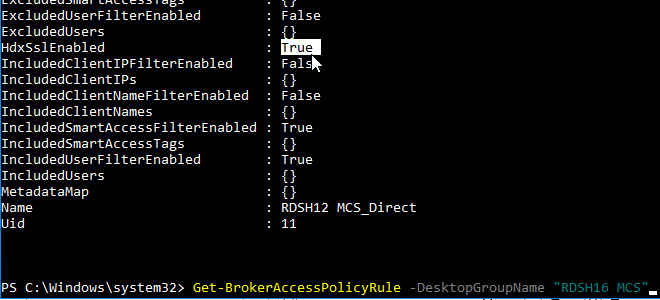
- Also run the following command:
Set-BrokerSite –DnsResolutionEnabled $true

You should now be able to connect to the VDA using the HTML5 Workspace app from internal machines.
The Citrix blog post How To Secure ICA Connections in XenApp and XenDesktop 7.6 using SSL has a method for automatically provisioning certificates for pooled virtual desktops by enabling certificate auto-enrollment and setting up a task that runs after the certificate has been enrolled.
- From Russ Hargrove at A note on VDA certificates in 7.14 at Citrix Discussions: Citrix installs a new “Citrix XenApp/XenDesktop HDX Service” certificate in the Personal store which breaks the automation of the Enable-VdaSSL.ps1 script. To fix the problem, modify the task scheduler powershell script to:
Enable-VdaSSL.ps1 -Enable -CertificateThumbPrint (Get-ChildItem -path cert:\LocalMachine\My | Where-Object -FilterScript {$_.Subject -eq ""} | Select-Object -ExpandProperty Thumbprint) -Confirm:$False - For certificate auto-enrollment on non-persistent Remote Desktop Session Hosts (aka Server OS VDAs), see Non-Persistent Server SSL to VDA by Alfredo Magallon Arbizu at CUGC.
Anonymous Accounts
If you intend to publish apps anonymously then follow this section.
- Anonymous accounts are created locally on the VDAs. When XenDesktop creates Anon accounts it gives them an idle time as specified at HKEY_LOCAL_MACHINE\SYSTEM\CurrentControlSet\Control\Citrix\AnonymousUserIdleTime. The default is 10 minutes. Adjust as desired.
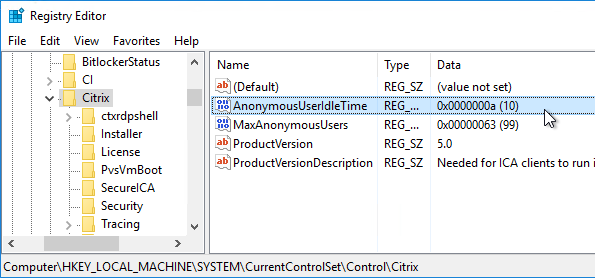
- Pre-create the Anon accounts on the VDA by running
"C:\Program Files\Citrix\ICAConfigTool\CreateAnonymousUsersApp.exe". If you don’t run this tool, then anonymous users can’t login.

- You can see the local Anon accounts by opening Computer Management, expanding System Tools, expanding Local Users and Groups and clicking Users.
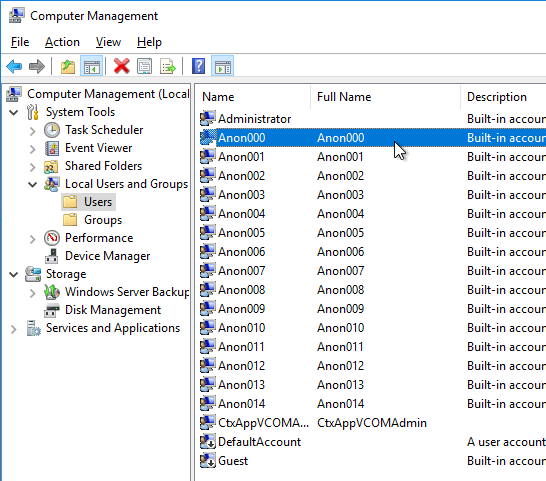
- If you want profiles for anonymous users to delete at logoff, then you’ll need to add the local Anon users to the local Guests group.
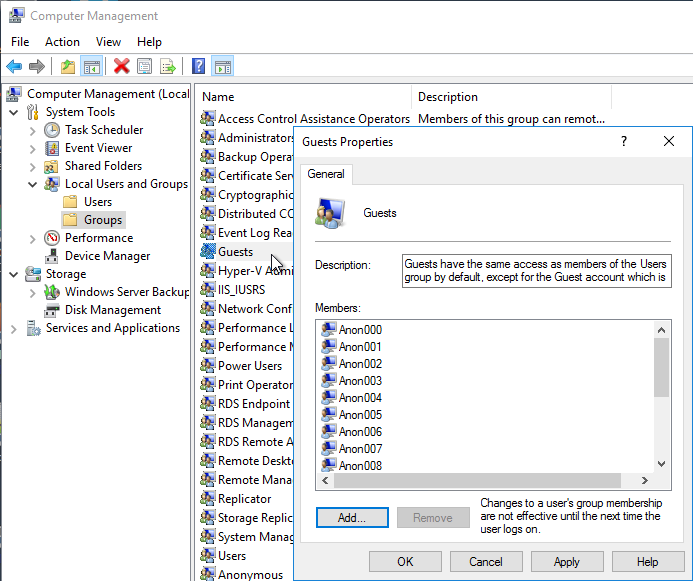
- If you open one of the accounts, on the Sessions tab, notice that idle timeout defaults to 10 minutes. Feel free to change it.
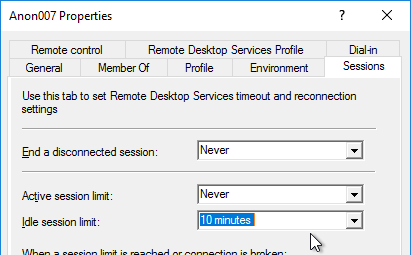
Group Policy for Anonymous Users
Since Anonymous users are local accounts on each Virtual Delivery Agent, domain-based GPOs will not apply. To work around this limitation, you’ll need to edit the local group policy on each Virtual Delivery Agent.
- On the Virtual Delivery Agent, run mmc.exe.
- Open the File menu, and click Add/Remove Snap-in.
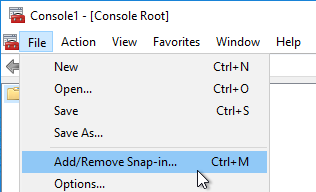
- Highlight Group Policy Object Editor, and click Add to move it to the right.
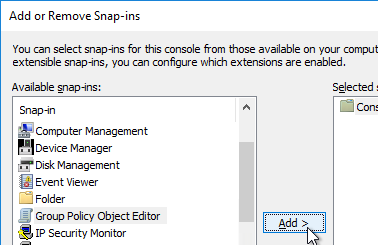
- In the Welcome to the Group Policy Wizard page, click Browse.
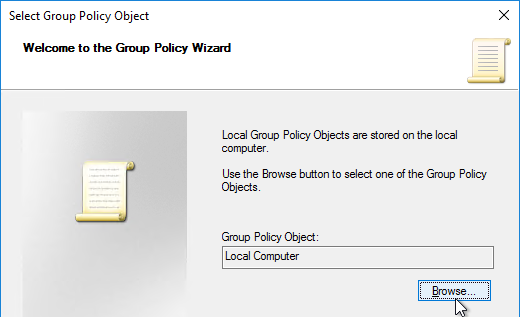
- On the Users tab, select Non-Administrators.
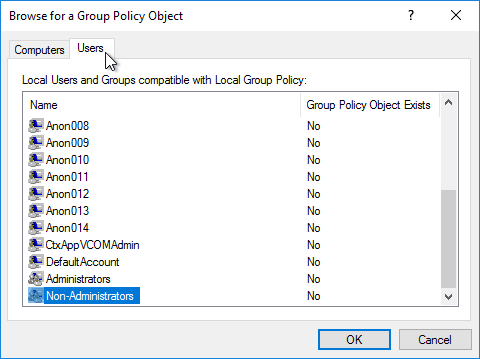
- Click Finish.
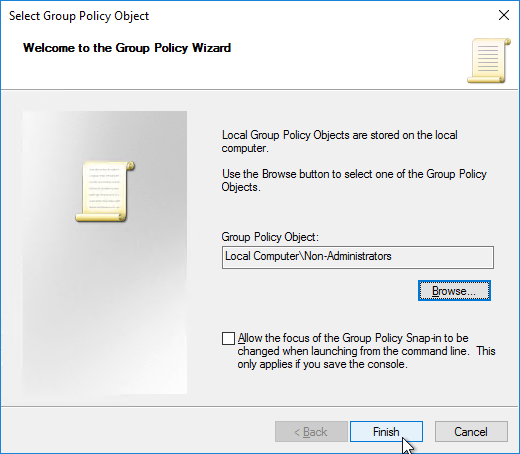
- Now you can configure group policy to lockdown sessions for anonymous users. Since this is a local group policy, you’ll need to repeat the group policy configuration on every Virtual Delivery Agent image. Also, Group Policy Preferences is not available in local group policy.
Antivirus
Install antivirus using your normal procedure. Instructions vary for each Antivirus product.
Microsoft’s virus scanning recommendations (e.g. exclude group policy files) – http://support.microsoft.com/kb/822158.
Citrix’s Recommended Antivirus Exclusions
Citrix Tech Zone Endpoint Security and Antivirus Best Practices: provides guidelines for configuring antivirus software in Citrix Virtual Apps and Desktops environments
Citrix Blog Post Citrix Recommended Antivirus Exclusions: the goal here is to provide you with a consolidated list of recommended antivirus exclusions for your Citrix virtualization environment focused on the key processes, folders, and files that we have seen cause issues in the field:
- Set real-time scanning to scan local drives only and not network drives
- Disable scan on boot
- Remove any unnecessary antivirus related entries from the Run key
- Exclude the pagefile(s) from being scanned
- Exclude Windows event logs from being scanned
- Exclude IIS log files from being scanned
See the Blog Post for exclusions for each Citrix component/product including: StoreFront, VDA, Controller, and Provisioning Services. The Blog Post also has links to additional KB articles on antivirus.
Symantec
Symantec links:
- Symantec TECH91070 Citrix and terminal server best practices for Endpoint Protection.
- Symantec TECH197344 Best practices for virtualization with Symantec Endpoint Protection 12.1.2 and later
- Symantec TECH180229 Symantec Endpoint Protection 12.1 – Non-persistent Virtualization Best Practices
- Symantec TECH123419 How to prepare Symantec Endpoint Protection clients on virtual disks for use with Citrix Provisioning Server has a script that automates changing the MAC address registered with Symantec.
- Citrix Blog Post How to prepare a Citrix Provisioning Services Target Device for Symantec Endpoint Protection
- If profiles are deleted on logoff, set Symantec registry value CloseUserLogFile to 1. Symantec TECH210170 Citrix user sessions are held open by ccSvcHst.exe during log off
Trend Micro
Trend Micro Slow login on Citrix environment after installing OfficeScan (OSCE): The following registries can be used to troubleshoot the issue. These registries will allow a delay on the startup procedure of OSCE until the system has launched successfully. This avoids deadlock situations during login.
Citrix CTX136680 – Slow Server Performance After Trend Micro Installation. Citrix session hosts experience slow response and performance more noticeable while users try to log in to the servers. At some point the performance of the servers is affected, resulting in issues with users logging on and requiring the server to be restarted. This issue is more noticeable on mid to large session host infrastructures.
Trend Micro has provided a registry fix for this type of issue. Create the following registry on all the affected servers. Add new DWORD Value as:
[HKEY_LOCAL_MACHINE\SYSTEM\CurrentControlSet\Services\TmFilterParameters] “DisableCtProcCheck”=dword:00000001
Trend Micro Links:
- Trend Micro Docs – Trend Micro Virtual Desktop Support
- Trend Micro Docs – VDI Pre-Scan Template Generation Tool
- Trend Micro 1055260 – Best practice for setting up Virtual Desktop Infrastructure (VDI) in OfficeScan
- Trend Micro 1056376 – Frequently Asked Questions (FAQs) about Virtual Desktop Infrastructure/Support In OfficeScan
Sophos
Best Practice for running Sophos on virtual systems: we’ve amassed the following practical information about how you can optimize our software to work with this technology.
Sophos Anti-Virus for Windows XP+: Installation and configuration considerations for Sophos Anti-Virus on a Remote Desktop Services server: It maybe desirable to disable the Sophos AutoUpdate shield icon
Sophos Anti-Virus for Windows 2000+: incorporating current versions in a disk image, including for use with cloned virtual machines: This procedure will make sure that the produced target/cloned computers:
- Get their distinct identity with Enterprise Console, under which they can be subsequently managed.
- Have the desired version of Sophos Anti-Virus already installed and configured on the created image.
Palo Alto Traps
- Install Traps Agent for Windows:
- Virtual desktop infrastructure (VDI) installation—Intended for non-persistent endpoints that replicate (also referred to as spawn) from a golden image which has Traps installed.
- Temporary session—Intended for either physical or virtual endpoints (such as a Remote Desktop Server) that repeatedly revert to a snapshot (or image) on which Traps is not installed.
Windows Defender Antivirus
Cylance
CTX232722 Unable to launch application with Cylance Memory Protection Enabled. Cylance must be run in compatibility mode in order to the VDA and Cylance to run on the same machine. See the article for detailed instructions.
Optimize Performance
VDA Optimizer
Installation of the VDA might have already done this but there’s no harm in doing it again. This tool is only available if you installed VDA in Master Image mode.
- On the master VDA, go to C:\Program Files\Citrix\PvsVm\TargetOSOptimizer, and run TargetOSOptimizer.exe.

- Then click OK. Notice that it disables Windows Update.
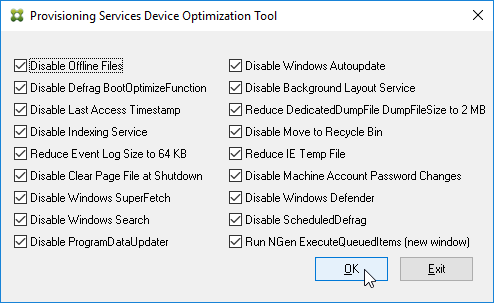
- See CTX125874 How to Optimize XenDesktop Machines for the list of registry values changed by the TargetOSOptimizer tool. You can use Group Policy Preferences to set these values.
Windows 10 / Windows 2012 R2 / Windows 2016 and newer
- Citrix Blog Post Citrix Optimizer 2.6 – What’s new.
- Citrix Optimizer Community Template Marketplace – for more templates, add the Community Template Marketplace.
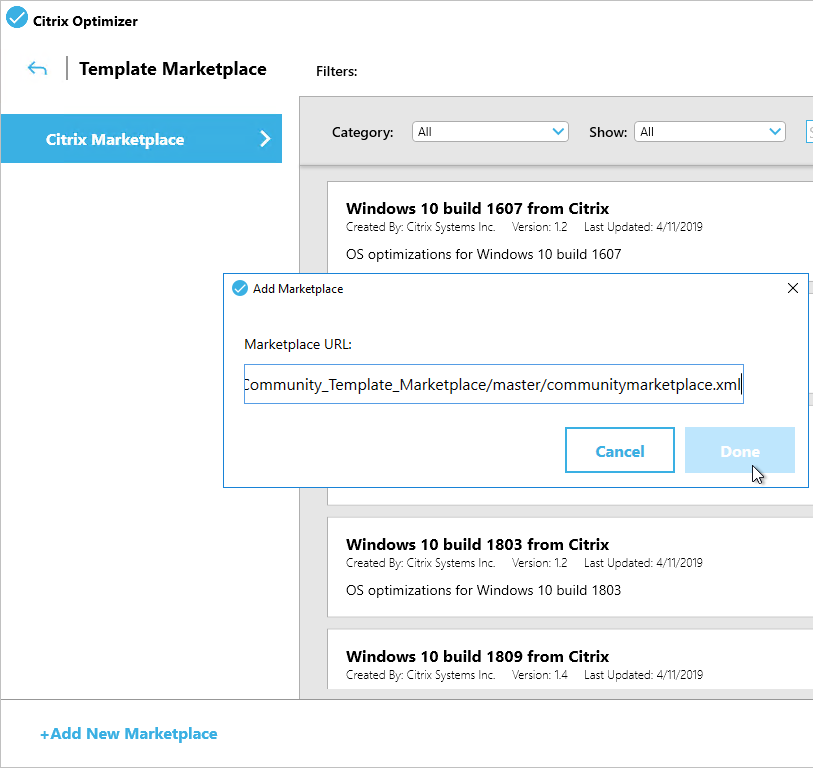
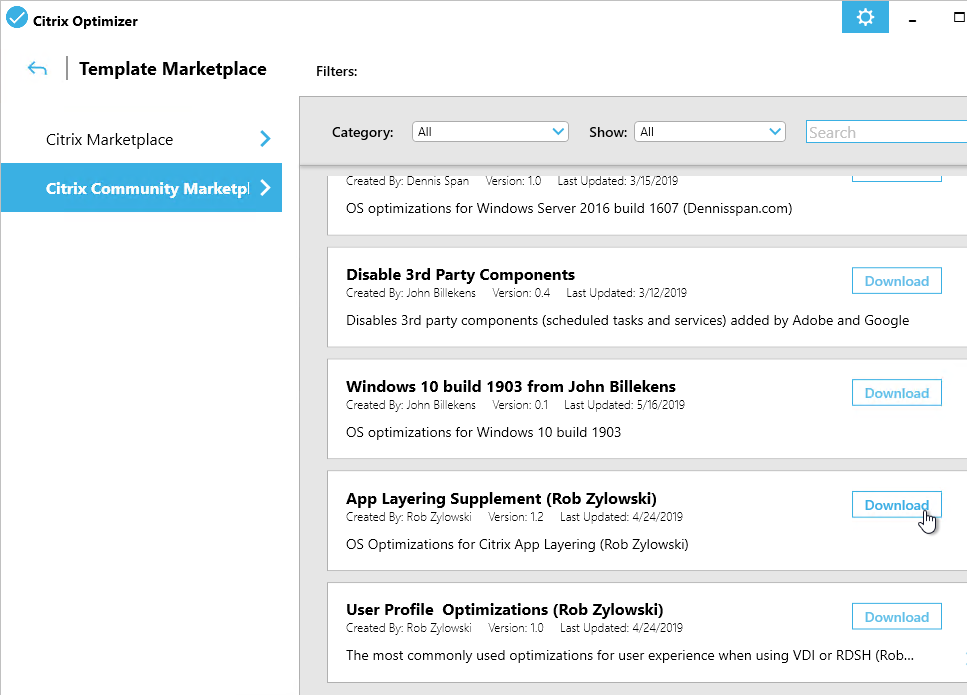
- Select a template (or download one from the Marketplace). Then click Optimize.
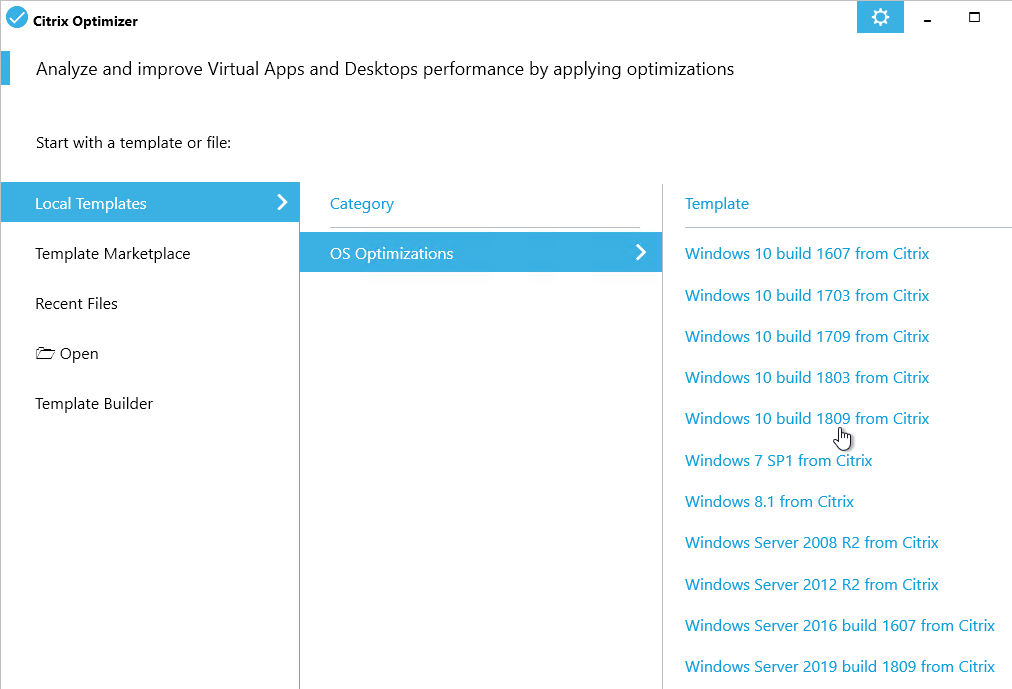
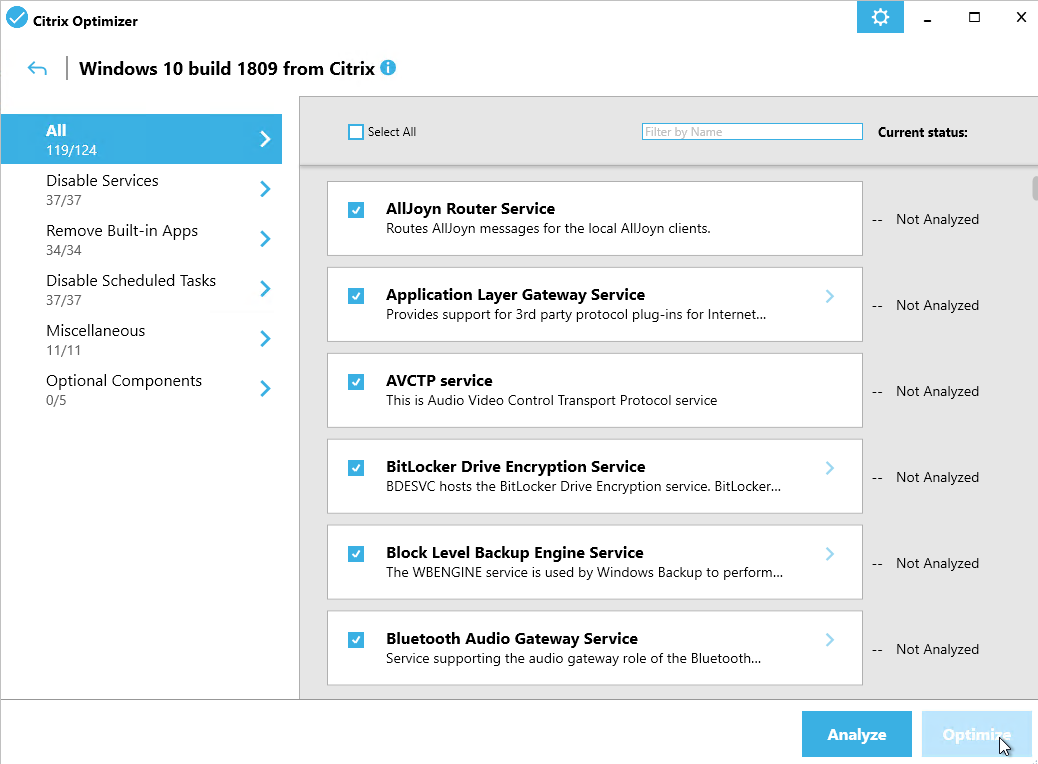
- To roll back Citrix Optimizer, see Citrix Blog Post Citrix Optimizer: How to Roll Back Changes
- VMware OS Optimization Tool. See VMware Windows Operating System Optimization Tool Guide Technical Paper for details on this tool. This tool has templates for Windows 10/2016, plus templates for older versions of Windows.
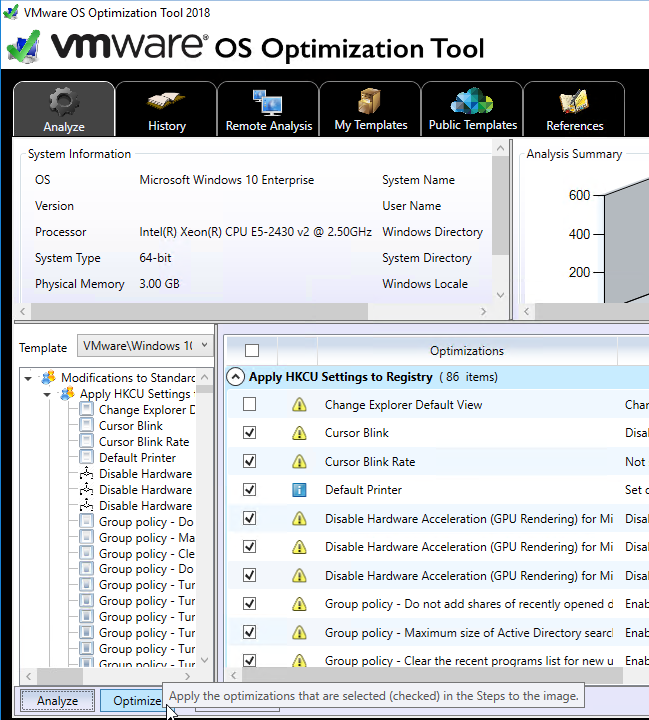
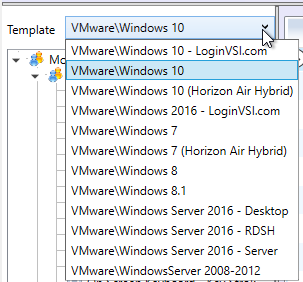
- Note: this tool might uninstall Windows Search. See CTA Saadallah Chebaros Windows 10 Search Indexing Not Working After VMware OS Optimization tool for a fix.

- Note: this tool might uninstall Windows Search. See CTA Saadallah Chebaros Windows 10 Search Indexing Not Working After VMware OS Optimization tool for a fix.
- Citrix Daniel Feller links:
- Windows Server 2016 Optimizations For Citrix XenApp
- Optimize Vdi: Windows 10 Scheduled Tasks (Original, Anniversary And Creator Updates) contains a list of Scheduled Tasks that can be disabled.

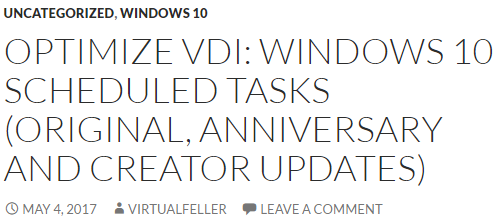
- Optimize VDI: Windows 10 Default Apps (Original, Anniversary And Creator Updates) lists the built-in UWP apps that should be removed.
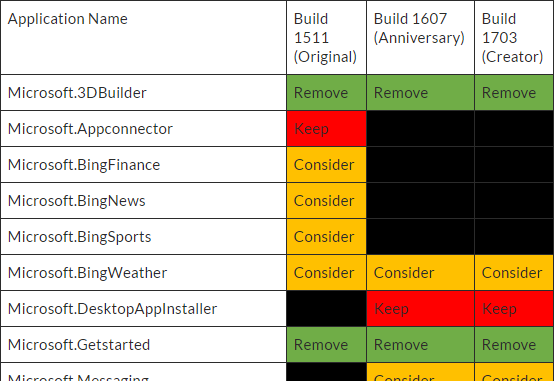
- Optimize Vdi: Windows 10 User Interface And Runtime (Original, Anniversary And Creator Updates) contains registry keys to improve Windows 10 performance.
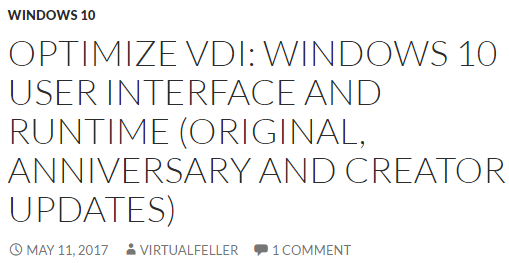
- James Rankin Improving Windows 10 logon time:
- Removing UWP apps on Windows 10 1803 – the easy way! – YouTube video
Get-AppxProvisionedPackage -online | Out-GridView -passthru | Remove-AppxProvisionedPackage -online - Use Remove-AppXProvisionedPackage to remove Modern apps. See the article for a list of apps to remove. Also see James Rankin Everything you wanted to know about virtualizing, optimizing and managing Windows 10…but were afraid to ask – part #3: MODERN APPS
- Import a Standard Start Tiles layout (Export-StartLayout)
- Create a template user profile
- Removing UWP apps on Windows 10 1803 – the easy way! – YouTube video
- David Wilkinson links:
- Citrix XenDesktop and Windows 10 Optimisation Script – “Optimise Windows 10 in XenDesktop based environment as per citrix optimisation recommendations/Various blogs and my own experience in running citrix environments.”

- Citrix XenApp and Windows Server 2016 – Optimisation Script – “Optimise Windows Server 2016 in XenApp/RDS based environment as per citrix optimisation Guide in 2008 R2/Various blogs and my own experience in running citrix environments.”

- Citrix XenDesktop and Windows 10 Optimisation Script – “Optimise Windows 10 in XenDesktop based environment as per citrix optimisation recommendations/Various blogs and my own experience in running citrix environments.”
- Citrix Links:
- Citrix’s Windows 10 Optimization Guide – remove built-in apps, delete Scheduled Tasks, disable services, etc.
- CTX232313 Citrix Provisioning Services: Slow Login Performance with Windows 10 VDA Machines says that if you removed all Store apps, then the Network Location Awareness Service can be disabled. 💡
- Or enable the local group policy setting Computer Configuration | Administrative Templates | Network | Network Isolation | Subnet definitions are authoritative.

- Or enable the local group policy setting Computer Configuration | Administrative Templates | Network | Network Isolation | Subnet definitions are authoritative.
- Citrix’s Windows 8 and 8.1 Virtual Desktop Optimization Guide contains the following:
- A list of services to disable
- A list of computer settings
- A list of scheduled tasks to disable
- A script to do all of the above
- Microsoft links:
- Microsoft Docs Optimizing Windows 10, version 1803, for a Virtual Desktop Infrastructure (VDI) role
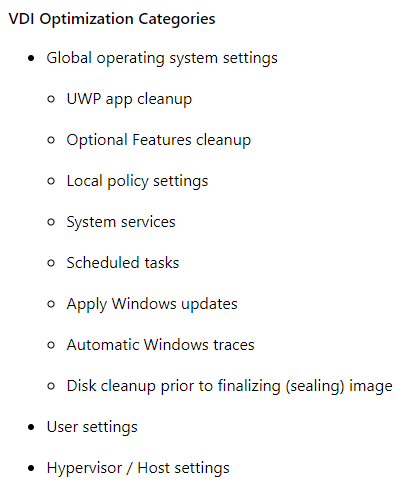
- Microsoft Docs Recommended settings for VDI desktops contains a list of settings with their Default Value and Recommended value for VDI use.
- Microsoft TechNet Blog Guidance on Disabling System Services on Windows Server 2016 with Desktop Experience contains a spreadsheet with a list of services categorized as follows:

- Carl Luberti (Microsoft) Windows 10 VDI Optimization Script
- Microsoft’s Windows 8 VDI optimization script.
- Microsoft Docs Optimizing Windows 10, version 1803, for a Virtual Desktop Infrastructure (VDI) role
Optimization Notes:
- If this machine is provisioned using Provisioning Services, do not disable the Shadow Copy services.
- Windows 8 detects VDI and automatically disables SuperFetch. No need to disable it yourself.
- Windows 8 automatically disables RSS and TaskOffload if not supported by the NIC.
- Citrix CTX213540 Unable To View Printers In Devices And Printers Win 2012 R2 – don’t disable the Device Setup Manager Service
- Citrix CTX131995 User Cannot Launch Application in Seamless Mode in a Provisioning Services Server when XenApp Optimization Best Practices are Applied. Do not enable NtfsDisable8dot3NameCreation.
RDSH 2008 R2
Citrix CTX131577 XenApp 6.x (Windows 2008 R2) – Optimization Guide is a document with several registry modifications that are supposed to improve server performance. Ignore the XenApp 6 content and instead focus on the Windows content.
Norskale has Windows 2008 R2 Remote Desktop and XenApp 6 Tuning Tips Update.
Windows 7
Microsoft has compiled a list of links to various optimization guides. It’s a common practice to optimize a Windows 7 virtual machine (VM) template (or image) specifically for VDI use. Usually such customizations include the following.
- Minimize the footprint, e.g. disable some features and services that are not required when the OS is used in “stateless” or “non-persistent” fashion. This is especially true for disk-intensive workloads since disk I/O is a common bottleneck for VDI deployment. (Especially if there are multiple VMs with the same I/O patterns that are timely aligned).
- Lock down user interface (e.g. optimize for specific task workers).
With that said the certain practices are quite debatable and vary between actual real-world deployments. Exact choices whether to disable this or that particular component depend on customer requirements and VDI usage patterns. E.g. in personalized virtual desktop scenario there’s much less things to disable since the machine is not completely “stateless”. Some customers rely heavily on particular UI functions and other can relatively easily trade them off for the sake of performance or standardization (thus enhance supportability and potentially security). This is one of the primary reasons why Microsoft doesn’t publish any “VDI Tuning” guide officially.
Though there are a number of such papers and even tools published either by the community or third parties. This Wiki page is aimed to serve as a consolidated and comprehensive list of such resources.
Daniel Ruiz XenDesktop Windows 7 Optimization and GPO’s Settings
Microsoft Whitepaper Performance Optimization Guidelines for Windows 7 Desktop Virtualization
Seal and Shut Down
If this VDA will be a master image in a Machine Creation Services or Provisioning Services catalog, after the master is fully prepared (including applications), do the following:
- Go to the properties of the C: drive, and run Disk Cleanup.
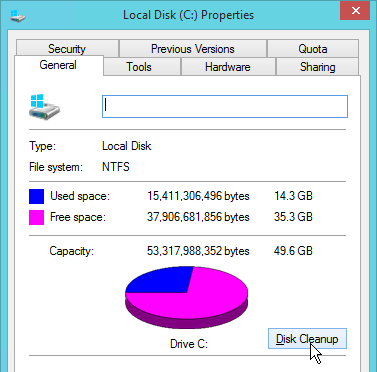
- If Disk Cleanup is missing, you can run cleanmgr.exe instead.

- Windows 10 1703 and newer has a new method for cleaning up temporary files.
- Right-click the Start button, and click System.
- Click Storage on the left, and click This PC (C:) on the right.
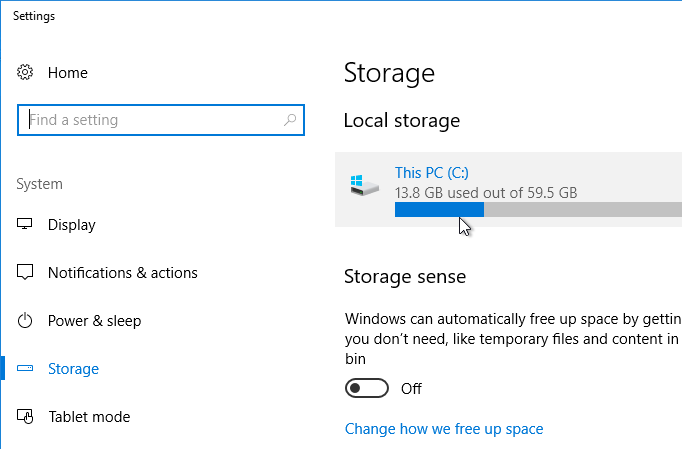
- Click Temporary Files.
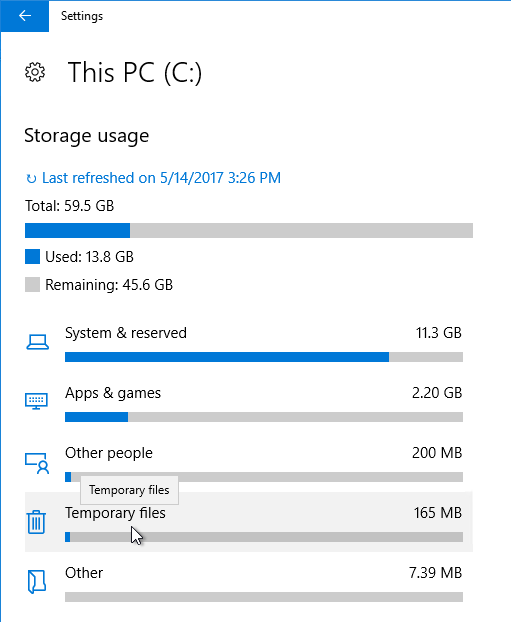
- Check boxes, and click Remove files.
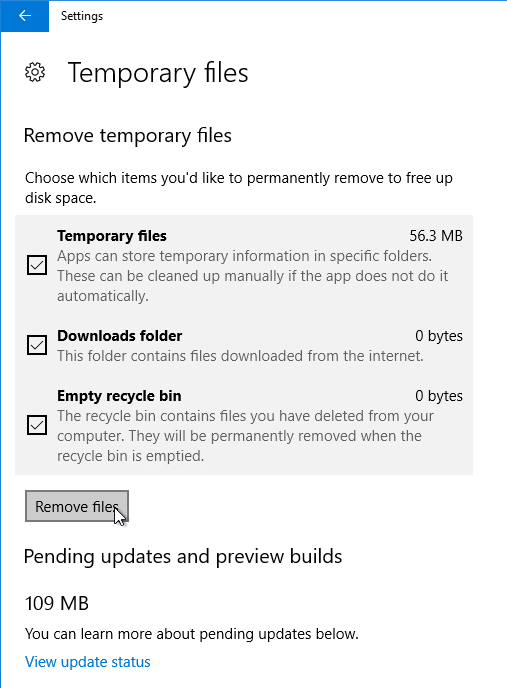
- On the Tools tab, click Optimize to defrag the drive.
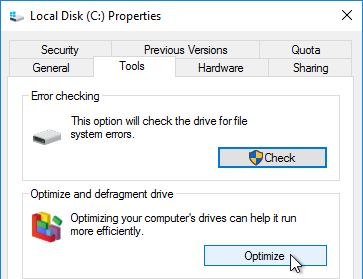 `
` - Run slmgr.vbs /dlv and make sure it is licensed with KMS and has at least one rearm remaining. It is not necessary to manually rearm licensing. XenDesktop will do it automatically.
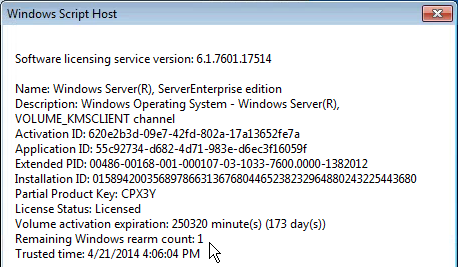
- Run Delprof2 to clean up local profiles. Get it from http://helgeklein.com/download/.

- Machine Creation Services and Provisioning Services require DHCP.

- Session hosts (RDSH) commonly have DHCP reservations.
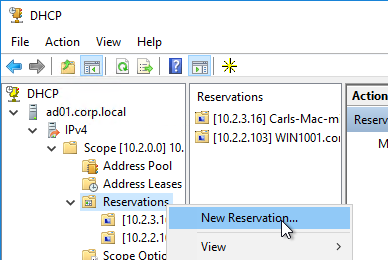
- Base Image Script Framework (BIS-F) automates many sealing tasks. The script is configurable using Group Policy.
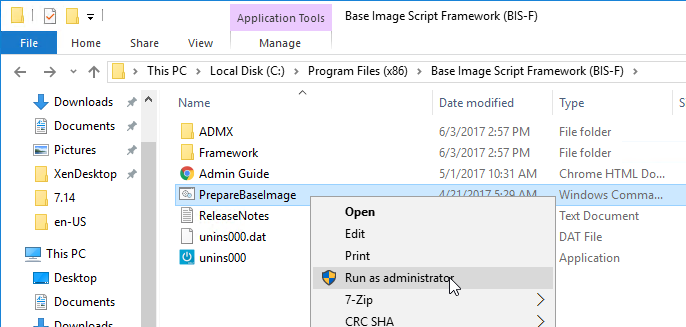
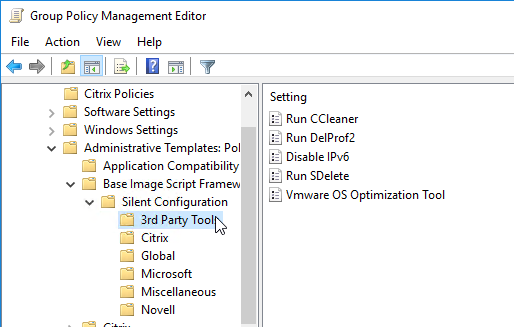
- Shut down the master image. You can now use Studio (Machine Creation Services) or Provisioning Services to create a catalog of linked clones.
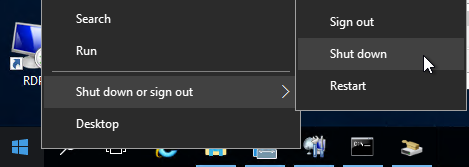
Troubleshooting – Graphics
If Windows 7 on vSphere, don’t install the VMware SVGA driver. For more details, see CTX201804 Intermittent Connection Failures/Black Screen Issues When Connecting from Multi-Monitor Client Machines to Windows 7 VDA with VDA 7.x on vSphere/ESXi.
For Citrix Policies that control graphics codecs, see https://www.carlstalhood.com/citrix-policy-settings/#graphics
Citrix Blog post – Optimising the performance of HDX 3D Pro – Lessons from the field
From Citrix Knowledgebase article CTX218217 Unable to span across multiple monitors after upgrade to 7.11 VDA, Black/Blank screen appears on the monitors while connecting to ICA session:
- For VDA 7.11 and newer, calculate the video memory that is required for monitors using the following formula :
SumOfAllMons (Width * Height) * 4 / 0.3, where width and height are resolution of the monitor. Note: There is no hard and fast rule that will work for all cases.Example: Consider the resolution of monitor 1 is 1920*1200 and monitor 2 is 1366*768. Then SumOfAllMons will be (1920*1200 + 1366*768)
- CTX115637 Citrix Session Graphics Memory Reference describes how multi-monitor resolution is determined.
- Open the registry (regedit) and navigate to:
HKEY_LOCAL_MACHINE\SYSTEM\CurrentControlSet\services\vbdenum - Increase the value of “MaxVideoMemoryBytes” REG_DWORD value to the above calculated memory.
- Reboot the VDA
From Citrix Discussions: To exclude applications from Citrix 3D rendering, create a REG_DWORD registry value “app.exe” with value 0 or a registry value “*” with value 0.
- XD 7.1 and XD 7.5:
- x86: reg add hklm\software\citrix\vd3d\compatibility /v * /t REG_DWORD /f /d 0
- x64: reg add hklm\software\Wow6432Node\citrix\vd3d\compatibility /v * /t REG_DWORD /f /d 0
- XD 7.6/7.7/7.8/7.9/7.11 both x86 and x64:
- reg add hklm\software\citrix\vd3d\compatibility /v * /t REG_DWORD /f /d 0
Wildcards are not supported. The asterisk * here has a special meaning “all apps” but is not a traditional wildcard. To blacklist multiple apps e.g. both appa.exe and appb.exe must be done by creating a registry value for each app individually.
This is most problematic in Remote PC since most physical PCs have GPUs. I recently had to blacklist Internet Explorer to prevent lockup issues when switching back to physical.
Uninstall VDA
Uninstall the VDA from Programs and Features.
Then see CTX209255 VDA Cleanup Utility.
To run the VDA Cleanup Tool silently:
- Execute VDACleanupUtility.exe /silent /noreboot to suppress reboot.
- Once the VDACleanupUtility has finished executing, setup Auto logon for the current user.
- Reboot.
- After reboot, tool will launch automatically to continue Cleanup.
Another option is to delete CitrixVdaCleanup value under HKLM\Software\Microsoft\Windows\CurrentVersion\RunOnce. Then after reboot, run VDACleanupUtility.exe /silent /reboot to indicate that it’s running after the reboot.
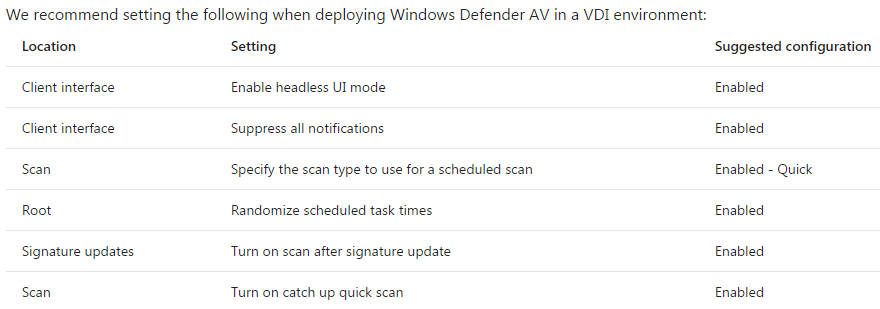
Hi Carl!
The “Citrix Desktop Helper” with default installation will got service error in both win10 1809 and 1903, then make all VDAs are unregistered, let user can’t open VDA because of without available machine.
I suggest totally delete this tool from the page or provide warning.
Hi Carl, after installing VDA 7.15 CU4 on Window Server 2016, we launch apps an are now seeing three mouse pointers. I have a case open with Citrix and after two hours still not resolved. We have uninstalled and reinstalled and still no luck.
Hi Carl, great information as always. Just want to warn you that running the VMWare optimiser breaks sysprep on Windows 10 1803. Not sure which option breaks it, but too many to go through so abandoned using it and stuck with Citrix optimiser instead. If anyone know which setting or group of settings breaks it, let me know!
Hi Carl,
we upgraded our Windows 10 1809 VDA to CU4 and our logon times went from 12-15 sec in CU3 to 35-40 seconds in CU4. Just for testing purposes, I upgraded VDA agent to version 1903 on the same desktop image and logon times went back to 13-15 seconds.
it is only in VDA 7.15 CU4 that we see these long logon times. CU3 and 1903 are both OK.
interestingly, users’ experience seems to be the same, users have not noticed any major change post upgrade to CU4 so i cannot figure out if we are really having issues or is there something different regarding the way our VDA calculates logon time. Our controller is still CU3 so i wonder if that has any impact although that doesn’t seem to affect VDA 1903.
i did most of the customization suggestions from your sites as well as other sites i could find, so I am bit lost here.
Do you have any suggestion? any help would be greatly appreciated.
thank you very much for all the work you put into helping our community.
Hi Carl,
I’ve been struggling to resolve a blue display issue in windows 10 machines (version 1809). Using VDA 7.15 CU3. Whenever a users tries to citrix in from home to their office workstations, it only shows blue display. When they run into this problem, logging in locally using their account also shows blue display. I can RDP to their machine using a different account and can just kick their account but we can’t do that as they will lose all of what they’re doing.
This problem will only be resolved with we restart their machine but this will close all their running applications and lose unsaved documents and we want to avoid that.
We also can’t figure out when this will happen as it happens randomly. It sometimes happens in the middle of the week, day or after disconnecting and connecting back in.
Are you using WEM?
How do I tell if we are using WEM. I don’t have access to the admin console for the citrix director. We use netscaler gateway and all VDAs are physical machines.
For physical, Citrix recently posted this https://support.citrix.com/article/CTX256820 but I’m not sure if it affects your issue.
Are your graphics drivers up to date?
This is for monitors that interchange the location after a citrix session. We have applied this as our client users uses 3 monitors minimum.
As for the graphics, all graphics card are up to date.
In our case right now, user cannot even load his profile when they citrix in from home. They citrix session initiates, but will only see blue display. No loading icon, just mouse pointer. When they get back to office and tries to login, they will run into the same state. CTRL+ALT+DEL works but when chosen to open task manager, it won’t show up.
We’ve applied this because of the interchanging display in monitors.
Graphics driver are up-to date.
The problem now is when the users citrix in from home to their physical VDAs, they can only see blue display and even no loading circle. When this is triggered and get back to office to login, they are stuck in that blue display state. It’s as if the profile is stuck to load. We can RDP to the machine using a different account but using the users account also stuck in blue display.
Hello carl
how do i upgrade my Multiple VDA’s using above CMDLET tool.
Please help me
Thanks
Sukumar.A
Hello Carl,
I have a problem with Windows Server 2012 R2 and VDA 715 CU3.
User desktop session start with no problem, but user complain that when File explorer and try to click to the other app minimized in task bar it lags and have to click 3 to 4 times to maximize again.
Any suggestion?
Hello Carl,
I had a simple question that even Citrix is struggling to answer. You commented in the SSL for VDA that you can use either “Computer template or the Web Server template.” If you use the Computer template does it require that it has the Enhanced Key Usage of both Client Authentication and Server Authentication?
I suspect that only Server Authentication is needed since you’re not doing client certificate authentication. https://social.technet.microsoft.com/Forums/windowsserver/en-US/b802a465-bc01-4de7-ad5a-b6de4ae65ed3/client-authentication-extended-key-usage-field-for-ssl-certificates?forum=winserversecurity
I have received a APP Crash error – FAS Virtual Smart Card Agent has stopped working after i upgraded the VDA agent from 7.15 Cu2 to CU3. Can you please help. I can see the CRASH pompt on every logon. but the macine connects to the ICA session.
Does this definitely work on 7.15 LTSR CU3? I can’t get this to work at all. Here’s what I know:
– Citrix HDX Browser Redirection Service running
– Citrix HDX HTML5 Video Redirection Service running
– VDA was on 7.15 LTSR CU1. Upgraded to CU3 via the command prompt parameters.
– Citrix Browser Content Redirection addon installed on the VDA.
– Endpoint device running the latest Citrix Workspace.
– ADMX loaded into Central Store, GPO created:
a) Browser Content Redirection = enabled
b) Browser Content Redirection ACL Configuration enabled and set to * (also tried setting to https://youtube.com/*)
– Also tried adding the following reg keys:
a) (REG_DWORD) – WebBrowserRedirection = 1
b) (REG_MULTI_SZ) – WebBrowserRedirectionACL = *
Restarted VDA and still can’t get the redirection to work. What am I missing?
Hello Ricky,
I had to fight round for round with the BCR-Feature and the Citrix support.
Our environment:
Farm: XA LTSR 7.15 CU3 + BCR 1515 (don’t know if it’s public or not) and Windows Server 2012 R2
Client: Windows 7 – Workspace App 1903
I get the BCR-Feature to work, but only on a published Desktop. A published Browser (IE or Chrome) just shows a white page.
We’ve traced a lot with the CDF-Tools, but still are waitig fot the Citrix Devs.
What i can recommend to you: Check the settings in this Citrix Article: https://support.citrix.com/article/CTX230052
If you have any news, please reply.
Thank you in advance.
Kind regards
Uwe
I will help you with this Uwe. Can you send me a private message via Twitter (@CitrixFerK)
HI Ricky,
I am the PM for BCR at HDX. I will try to help you out here.
First thing the RegKey is case sensitive, so you need to follow what is described in detail at edocs.
WebBrowserRedirectionAcl
(small c and small l).
I prefer to create the regkey manually instead of using the ADMX template.
At least for troubleshooting.
Second, the value cannot be *
You need to explicitly list the website you want to redirect.
Example,
https://www.youtube.com/*
https://www.cnn.com/*
etc etc.
Now try again, close the browser and relaunch. Open IE11 and navigate to https://www.youtube.com
Is that page redirected?
If not, please follow section 4.4 at CTX230052 and paste the output of the console here.
Hello Carl,
i have updated a W7 VDI to W10 1803 32 bit (with reverse imaging).
Reinstall VDA and Xenserver tool.
The VDI are deployed with citrix provisioning.
Master Image shows I/O optimized and Management agent installed.
The vdi deployed show I/O not optimized and management agent not installed.
Performance are unacceptable.
I Open a ticket to citrix and i’m waiting for response.
Do you have any idea?
Great article!! Thanks a lot
for SSL for VDA….I configured my vda and broker and all works fine but internally.
It’s possible to do the same externally throug ns gateway? I read :
“External users don’t have this problem since they are SSL-proxied through NetScaler Gateway”
how I can configure this in my netscaler?
thanks
No config needed. Just point your browser to a Gateway vServer. Login. When prompted for Receiver detection, choose the “Light” option. When you launch an app, it should open in a new browser tab and be proxied through the Gateway.
Yes but not work…my browser says says “refer to article CTX134123”
I’m using netscaler gateway
What version of NetScaler?
NS12.0.56.20.nc
I have update windows 7 vdi to windows 10
Reverse imaging, update to w10, reinstall citrix provisioning target device, rejoin to domain, imaging and deploy via citrix provisioning.
The VDI start correctly, but when i try to start the dektop from storefront the connection were closed and in the event viewer of the vdi i found event id 1030 connection failure. no error was showed to end user.
any suggestion?
Already try to apply this
https://support.citrix.com/article/CTX135009
but it not works
You did an in-place upgrade of Windows?
Did you also uninstall VDA and reinstall it?
As always you’re right. Uninstalling and reinstalling the VDA is the solution.
But it’s painfully slow… windows 10 enterprise 1809…already doing citrix optimizer, any other suggestion to speed up?
4 vcpu and 4 GB of RAM cache in device ram with overflow on disk
Hi Carl,
I install windows 2016 operating system with vda 1912 CU3, I get the random failed to start the published desktop issue, I uninstall vda 1912 cu3 and install vda 1912 cu6, but still get this issue, when it happens, the log in window shows for a few seconds, then disappear automatically, there is 1030 connectionfailure in the event log, nothing else, do you know how to fix this issue?
Do you see anything interesting in the event log on the VDA machine?
Hi Carl,
i have an issue in windows2012 R2 with Office 2013 installed. When user try to resize an image attached to a word document it not respond immediately and it is not smooth.
Any suggestion?
Hello Carl,
I have a customer that work in healthcare. It uses win10 vdi. Usually work with smart card for sign in document. Is it possible to use different smart card (not reader) in the same ica connection?
Regards
Alessandro
Are you saying that swapping the card doesn’t work? I wonder if you can enable generic USB redirection of the smart card reader, which probably means needing a different reader for logon vs in-session. https://support.citrix.com/article/CTX137939
https://docs.citrix.com/en-us/citrix-virtual-apps-desktops/secure/smart-cards.html#user-experience has some info. Generic USB redirection of smart card reader is not supported. The article suggest that multiple smart cards should and readers should work.
Updating 3rd part software install alternative driver and now it works.
Thank you for your time
I have a VDI with smartcard reader(no authentication). It workslike a charm, but i would like to know if it is possible to change smartcard during ICA session. The smart card is using for web site not authentication.
I have the problem that only first certificate is saved and i have to delete it before it can see second certificate.
Hi Carl, should there be issues upgrading from 7.15 LTSR to 7.15 LTSR CU3 in a 2008 R2 setup before upgrading the OS later?
Secondly, if all roles are on the same server delivery controller, storefront, licensing etc are on a couple different servers. Is there a procedure of doing this as its a lot easier when roles are separated to different servers.
Hope to hear from you soon
Regards
RJS
Hi. The server vda install does not have the “Additional Components” option. 7.15 CU1. I am attempting to install the app-v components. Any idea why this option does not appear? I proceeded anyway, and was unable to launch app-v packages. I ran Enable-AppV and all the other stuff you need to do. I noticed that the C:\Program Files\Citrix\Virtual Desktop Agent\CtxAppV* files were missing. Any ideas? Thanks.
Finally resolved. This machine was physical. It seems like the Additional Components does not appear when installing on a physical server. You need to use the cli with the /virtualmachine switch. In addition, if you want to install the AppV components, be sure to run Enable-AppV before installing the VDA.
Can you please let me know if it is a 2012 or 2016 server.
It was a physical 2016 server. needed to install from the cli and use the /virtualmachine switch.
Hi!
And why not use third-party specialized software to connect and control the com port at a distance via the Internet? It’s easy to do with the https://www.eltima.com/products/serial-over-ethernet/ program. This is much easier or not?
562/5000
Hello Carl,
I’m having issues related after I upgraded VDA to version 7.15.300. I use a USB device that redirects to a COM port. It should be used on COM1 port. After I upgraded from VDA, the nine registry key HKEY_LOCAL_MACHINE \ HARDWARE \ DEVICEMAP \ SERIALCOMM came up for a Citrix feature related to some Citrix feature.
How can I do to disable it? The CCMPORT1 record always conflicts with my device because both of them use COM1.
I have not found a document that deals with this problem or similar.
We summarized all there is on COM here: CTX232422
Please take a look and see if there is something you can apply.
Thanks FK!
The big problem is that the device only works on COM1. Usually it appears in COM10. When I try to redirect to COM1, it does not work. Already tried to do the command:
net use COM1: \\ client \ COM10:
I get the error 87.
I tried doing this by changing the CCMport1 registry port to another COM port and directing the device to COM1. This method works. The problem is that upon restarting the client then CCMport1 returns to COM1 causing conflict with the device.
Is there any way to disable CCMports? How can I redirect this device to COM1?
Thank you for your help!
Carl
I have around 129 VDI machines. We recently upgraded the core servers to 7.,15.3cu. These machines do not inherit from a master. I need to upgrade the VDA from 7.9. Is there a way to push the upgrade to these machines? Not really looking forward to logging into each machine to do the upgrade.
Thanks enjoy your site
How do you push application updates to those machines? SCCM?
The only thing that gets pushed to the machines is windows update using a wsus server. If there is a new release for an application we have to log into each machine. This site was setup before I took over and it started out as a 7.9 site and the machines are called engineering machines, with a nvidia gpu assigned to them through vcenter. Since they are statically assigned is why I am assuming no provisioning process was used.
Full persistent machines allow each user to have different applications installed on their machines. But you usually use SCCM or similar to push application updates to those machines.
With the ability to create restart schedules for delivery groups for different days using tags with the New-BrokerRebootScheduleV2 command, I have seen other forums saying that the builtin restart mechanism will only reboot machines if there are no users logged on. Is it possible to force a restart or to forcefully log off sessions and restart a machine if there are sessions logged on using the built in restart mechanism (similiar to the way it worked in XenApp 6.5)? Or does it require using a 3rd part PowerShell script such as what is available at https://www.citrix.com/blogs/2016/09/20/xenapp-and-xendesktop-7-x-server-os-vda-staggered-reboot-framework-v2/ ?
CTP George Spiers says that they reboot if users are logged in.
Memory handling difference between VDA 7.6 LTSR and 7.15 LTSR ?
Hi Carl,
Great blog as always!
I am currently looking into the many optimisation scripts\applications\templates on offer for Server 2016 (XenApp Hosted Desktop with PVS) which are out there and wondered if you had any preference or recommendations? I am currently investigating vmware optimization tool + 2016 VDI like a Pro template.
regards
Greg
Some of those tools can be quite aggressive and might make it worse. For example, I troubleshooted one logon time issue caused by VMware Optimizer. I like Citrix Optimizer because it is safe.
I Carl, UPM not working after VDA upgrade to 7.15 CU2 and CU3?
What do you see in the UPM logs?
File log is not create, lf im returning in version witout cumulative update it’s working.
You can go to to the ISO\x64\ProfileMgmt to reinstall it.
How to remove profil management to return to 7.15 version? Ia cant see any option
Hi Carl, I am in a desperate need. After installing the VDA on windows server 2016, RDP to the server doesn’t work and login gets stuck on the Welcome screen forever. Login via Console works though.
Also, I have noticed, when I reboot the server then first user can RDP to the server and second or more users get stuck on Welcome screen. This issue is making me crazy and started only after installing VDA
I am using VDA 7.15 LTSR CU2
I am also seeing this. If I rebuild the server its ok for somewhere between 30 and 60 days.
I’ve only seen it on Server 2016. Server 2012 R2 is ok
Logon screen shows:
Other user
Welcome (spinning circle)
After 2 mins I then get:
myuser, name
Welcome
and the user gets logged on shorlty after.
Normal logons to a working server are Less than 10 sec
In the VDA section indicating “Or set the registry value HKEY_LOCAL_MACHINE\SOFTWARE\Citrix\PorticaAutoLogon (DWORD) = 0x10.”, this setting is only applicable to a Desktop VDA. This setting does not impact the server VDA operation where the RDS “prompt for password” settings are used.
Thanks. I found a couple problems with that section and hopefully fixed them.
Is there any way to configure the size of the logon screen in Windows 2016 when Interactive logon message text and title are used (to display legal notice)? DisableLogonUISuppression works to suppress the black screen when the interactive logon feature is not used – but when it is used the logon screen is blue not black and is full screen for the duration of the logon. LogonUIHeight & Width settings also do not seem to have an effect on window size and appears to be just for the caption portion size of the logon message.
Please disregard – I upgraded from 7.15 CU1 to CU2 and the legal disclaimer screen is no full screen.
I’m having the same issue with full screen logonUI for Server 2016. It was working but something must have changed recently to cause it to go full screen. Can’t figure it out. Any ideas?
Hey Carl,
we are designing a fresh environment based on XenDesktop 7.15 LTSR and Windows Server 2016. So we got some issues with Lotus Notes and the Citrix Profilemanagement that writes many Eventlog entrys with the ID 140 NTFS delayed write back. Do u have any idea for that problem?
On the old XenApp 6.5 environment all works well. So i dont think that it was an Filecluster Issue.
Thanks
Hello Carl, what do you think about ESC (IE11)? You think we have to disable for administrators and users? And disable under tools/internet options/security?
And what’s about ENABLELUA=0? Dangerous? Critical?
Thanks
Hi Carl,
If we uninstall and reinstall VDA on XenApp server, do we need to republish the applications via studio ? The existing published applications for that particular VDA will not work ?
Uninstalling the VDA has no effect on Studio other than no longer being registered.
Thank you Carl
7.15 LTSR – Print Dialog very slow to appear
Hi Everyone
As stated before, we are implementing a new 7.15 LTSR farm.
On our previous farm, printer mapping would consume too much time at logon, which is why we decided to implement a different way of mapping printers, based on users and/or machines, w/o automatic mapping of default printers. This allows us to control and restrain the amount of printers and printer drivers that actually get installed on the VDAs. After various obstacles (missing Clientname variable, missing print operator rights, etc.), this is actually working quite nicely.
We have though found another problem, which is the time required to open the print dialog in published applications. This can take between 5 to 10 seconds. Opening the same print dialog for the same user in a RDP session (thanks for the hint about Direct Access User Group, Carl!) happens instantly, as expected.
Has anyone experienced this?
Hi everyone
We are currently implementing XenApp 7.15 LTSR on Windows Server 2016 as replacement for a 6.5 farm, w/o provisioning.
The new farm not being in production currently, we have been easy on Windows Updates – until now…
Trying to apply the latest June updates sent all six VDAs into Nirvana. BSODs, machine domain pw lost, settings not being saved, you name it. After some searching, it appears that the latest updates probably mess up with the Citrix filter driver, which gets installed even if you choose not to provision.
This problem was supposed to be resolved as of 7.14 but we could reproduce it, even on a fresh 7.15 LTSR VDA.
Setting the registry as in CTX222825 / CTX223789 seems to solve the problem. You should do this _before_ applying the June Windows Updates, though, or this setting might get reverted, as data does not get written to disk anymore (in case your VDA is affected).
Citrix has been informed but does not seem to care because we do not have active support on XenApp anymore.
Hello Carl,
Trying to upgrade from 7.8 VDA to 7.15 CU2 on Windows 7,
When we logoff the desktop on the 7.8 version it closes down appropriately,
Moving to 7.15.CU2 it hangs with a blank blue screen for 4 minutes and then on the local machine receiver gives you a message that you have been disconnected and do you want to reconnect.
Help please,
BTW love your site, your information is the best!!!
Are you seeing “connection interrupted”? https://support.citrix.com/article/CTX221206
In 7.8 VDA you click log off and the machine closes appropriately
In 7.15 CU2, you click log off
The screen starts off as a light blue screen, which is normal,
It then goes to a dark blue screen, which it never did this in 7.8 VDA and stays there for 2-3 minutes.
It finally closes and receiver opens a dialog,
Reconnecting…
Citrix Receiver will try to reconnect for 1:54 minutes.
Click Disconnect if you want to stop
If you click disconnect, it closes. and logs you out.
Hello Carl,
For our ERP I set the setting “legacy printer names”. I assigned the setting via Citrix Studio to an OU. Assistant says that the settints applied. But it does no work. Do you have a tip?
Hello Carl,
I have a XenDesktop 7.15 LTSR CU2 installation with the Citrix workaround applied for UPM for the known case of black screen, i.e. I have uninstalled the CU2 UPM and installed the CU1 UPM. The XenDesktop 7.15 LTSR CU2 VDA servers are running on Windows Server 2016 Standard (build number 10.0.14393). I have applied all optimizations to the VDA by using the Citrix optimizer and the Citrix recommended template for Windows Server 2016. I also have WEM agent installed on the VDA machines. I have attached the version of each installed product.
1) What I have noticed is that when any Citrix users logs on to a Citrix desktop, they see a blinking screen/desktop and they cannot interact with it. I noticed that if I grant a user with domain admin permissions, this issue goes away, so it seems to be permissions related. Have you seen this issue before in this XenApp/XenDesktop configuration? Anything I am missing here? This exact issue also occurs with XenDesktop 7.18 CR.
2) The start menu of the Citrix desktop is occasionally not clickable, i.e. the users cannot interact with it, regardless of permissions or other configuration.
Have you seen this? https://tech.xenit.se/flickering-desktop-icons-re-directed-folder/
Hello Carl,
Thanks for pointing this out. However this is different than the issue I have. In my case I cannot even access the desktop as it is constantly flickering.
After further testing it appears that the root cause of this issue is the Citrix UPM mandatory profile. After disabling the mandatory profile option in the Citrix UPM GPO policy, the issue seems to be resolved. Will need to check again all configuration settings for the mandatory profile but would like also any feedback from the community in case you have come across this behaviour related to the mandatory profile configuration.
I have updated the relevant Citrix Discussions article: https://discussions.citrix.com/topic/395708-xendesktop-715-ltsr-cu2-blinking-screen-and-start-menu-not-clickable/.
Any feedback would be welcome.
Hey Carl,
Would you have any idea why when an application is opened and you are clicking around in the application it refreshes oddly. It appears like the whole application flicks black for a millisecond and then displays the data. It’s causing eye distress for the users. We are running Receiver 4.10 on these windows 7 laptops. We had a previous issue where we had to disable ACTIVE ACCESSIBILITY HOOK for the applications class on the workers (as we were not able to select some drop downs). It was not present on Receiver 4.4.1. This flicker does not occur if we break seamless mode (Ctrl+f2) or launch a full desktop. I tried turning off scaling on the machine and that made no difference.
Regards
Peter
Thanks Carl! How is CQI measuring bandwidth available? I am local to the site (1gig connection) and the VMS are on Hyper-V (the host has 4 1gig NICS on the hyper-V Switch) but it usually says I have like 10-15 mbps bandwidth available
Did you happen to get any response? I too have a same question and need to know why CQI mentions that my local bandwidth is so low.
Have you tried the most recent versions of CQI? Newer versions have been trying to improve this.
Yes,I am running a latest version of CQI that i downloaded a week back from Citrix Site. I am guessing netscaler is restricting my bandwidth flow towards Citrix VDA’s.
Yes,I am running a latest version of CQI that i downloaded a week back from Citrix Site. I am guessing netscaler is restricting my bandwidth flow towards Citrix VDA’s.
does any can confirm if VDA agent for Desktop os 7.15.x version with a 7.1 delivery controller? I checked Citrix docs but couldn’t find any compatibility matrix.
Any help is appreciated.
7.1 is not supported, so I doubt you’ll see any support statement.
But it most likely will work. It should be simple to install 7.15 VDA and connect it to 7.1 Controller.
Hi Carl
Trying to update the VDA on a win 10 image to 7.15 LTSR CU2. The update fails very quickly and only creates the base xendesktop installation log file (none of the sub folders and separate msi log files). Looking in the log file we get i can see the lines:
XenDesktopSetup:Windows Media Feature not installed
XenDesktopSetup:Cancelling due to missing Windows media feature
The machine i am trying to update has previously been optimized by using both the Citrix optimizer tool and also a custom optimization from the VMWare optimizer tool. I am guessing something has been disabled during that process but cant work out what 🙁
Regards
Dave
Ok, maybe i was a little quick to post this 🙂 i have now got past the problem by installing windows media player on the VDI. Interesting that we did not have to install media player for the original 7.15 LTSR VDA.
Hello Carl,
Question on choice of VDA version. In my corporate, we deliver Windows 2012R2/2016 desktop to developers/consultants (static allocation, single user per VM). In that case, do you prefer installing VDA as Server VDI (Desktop OS VDA) or RDSH (Server OS VDA)? If you can share us some recommendation, that would be great. Thank you.
Server VDI allows reboot when user logs off. Needed for non-persistence.
Server VDI also enables user mapping to persistent machines.
Carl,
Thank you for replying. For #2, if I install Server OS VDA on Windows 2012R2/2016, for example, I have XD01 and XD02, then I couldn’t allocate user A to use XD01 and user B to use XD02? Thanks.
You could put them in different Delivery Groups and assign that way. Or use Tags. But it’s probably easier with Server VDI and Static Allocation.
Make sense. Thank you, Carl. Your guide is amazing.
Thanks Carl, very insightful.
The guide helped me a lot but resolution is an issue.
The display on my VDi are not great even with up to 32MB vMware video allocations.
Any idea what is required on the XD configuration side to give some users a good resolution?
Are you using GPU? If not, you should be able to change the Receiver Desktop Viewer to any resolution.
Dots per inch is based on what’s configured on the client machine.
I had commented previously about black screen after installing 7.15.1000 VDA on Win10 1709. I have found along with a few other people who have posted in the Citrix forums that you have to uninstall Microsoft Jan/Feb cumulative updates, then install KB4051963 from Nov, and then the VDA seems to install and function correctly. This is a big pain having to uninstall Microsoft updates to get this patch installed – I thought patches were cumulative?
Hello,
since the upgrade from XenDesktop 7.15 LTSR to 7.15 LTSR CU1, the users have problems to logon. In the logfile of the profile manager I see the following entry on all updated servers for every user:
ERROR;;, 3, 4816;DispatchLogonLogoff: Updating Perfmon Logon/Logoff Counters failed
I searched a lot for this error/behavior but did not found a solution yet. In the meantime unfortunately I had roll back to 7.15 LTSR. Is there any issue with the profile manager 7.15CU1 ?
best regards,
hi, i get the same error on vda 1808_02, also on 7.15 LTSR CU3, problem is also that the upm profile is created on the fileserver, but after login back, the profile type is set to other and then no changes wer recognised. any ideas?? we are running server 2016, had no problems with 7.14
Attempting to install VDA 7.15.1000 on Win10 1709 with latest Microsoft updates. The install goes fine but when I reboot it never comes back from the spinning startup graphic. Tried it twice now. This is a VMWare VM on ESXi 6.0 running VMWare tools version 10.277. Anyone seen this behavior or have any ideas?
hi Carl, for HDX Flash redirection to work are there any requirements on the end point ? (Other than the identical version of flash) :
Are there any security requirements e.g does a user need permissions to launch flash\IE browsers ?
Is there a dependancy on a IE browser being present ?
thanks in advance
https://support.citrix.com/article/CTX136588 Has some info.
Thanks carl
Hello,
after updating XenDesktop 7.15 LTSR VDA to 7.15 LTSR CU1 (Windows 2012 R2), the startmenu of the users disappeared (blank, no icons). Any ideas what can cause this issue?
best regards,
same problem other user with Windows 2016 …
https://discussions.citrix.com/topic/391754-windows-2016-start-menu-blank-icons-with-715-cu1/?csrfKey=bf65bcb000120d79c154bcdd7b8338de
GPO > Show all APPS
Have you tested 7.15 VDA with VMWare tools 10.x on server 2016 delivering seamless/published apps?
I have really strange mouse behaviors. Some apps displaying multiple mousepointers (like this, https://discussions.citrix.com/topic/385363-second-mouse-pointer-in-the-middle-of-the-screen/ but changing policy should not be a solution since disabled is default if policy is untouched)
Builtin apps, such as paint only shows one pointer but it behaves very strange in non input areas (like in menus and under the “paper” sheet). Moving the mouse to the right it dissapears behind published app edges (server rendered) when policy set to disabled, and is very choppy if policy is untouched.)
I can set the legacy graphics policy to rid the double mouse pointers but its very ambigous that that even should e a solution, since default is disabled. That policy should not be necessary to set.
Tried vanilla setup of 2016 and problem is there. Testing with xenserver its problem free, behaves as expected.
Tried server 2012R2 with same VMware hypervisor/tools and it works as expected.
Suspecting bug in VDA integration with VMWare tools, I have a Citrix tech support case but I’m not progressing with them ATM since they are resilent to do reproduction tests with VMWare.
/Miguel
“Windows 10 1709 Targeted will only be partially supported by VDA 7.16, and full support for Windows 10 1709 Broad probably with VDA 7.17. I would not expect VDA 7.15 to ever support Windows 10 1709 or newer.”
I am the Product Manager in Citrix for the VDA MetaInstaller.
I want to convey that WE WILL support 1709 with 7.15.
The Microsoft patches required for this will come out in 2 dates:
-Nov 14th (Patch Tuesday KB4051314) will allow you to upgrade from 1703 and older with a VDA already installed, to 1709.
-’11D’ patch (last week of November via Microsoft Update Catalogue) will allow you to do a fresh new VDA install on top of 1709.
We have a live article about all this: CTX229052
Thanks. I updated the text. BTW, my comment was more about Targeted vs Broad.
Hi all,
has anyone an idea how to install the Drivers for Mac / Linux Client Printring silent with SCCM or Matrix?
PS driver = HP Color LaserJet 2800 Series PS
PCL4 driver = HP LaserJet Series II
PCL5c driver = HP Color LaserJet 4500 PCL 5
Best Reagards
This helps me:
Quote
To manage printers, Microsoft has developed several VBS scripts that allow to manage printers and print queues, install and uninstall printer drivers, etc.
These scripts are present in all Windows versions (starting from Vista and Windows Server 2008) and are stored in the directory C:\Windows\System32\Printing_Admin_Scripts\en-US
http://woshub.com/manage-printers-and-drivers-from-the-command-line-in-windows-8/
Okay done via cmd script:
cscript “C:\Windows\System32\Printing_Admin_Scripts\de-DE\prndrvr.vbs” -a -m “HP Color LaserJet 2800 Series PS” -i “C:\temp\treiber\prnhp001.inf”
cscript “C:\Windows\System32\Printing_Admin_Scripts\de-DE\prndrvr.vbs” -a -m “HP LaserJet Series II” -i “C:\temp\treiber\prnhp001.inf”
cscript “C:\Windows\System32\Printing_Admin_Scripts\de-DE\prndrvr.vbs” -a -m “HP Color LaserJet 4500 PCL 5” -i “C:\temp\treiber\prnhp001.inf”
Memory handling difference between VDA 7.6 LTSR and 7.15 LTSR ?
Hi Carl, thanks again for your huge participation to make CitrixLand a better place to live in 😉
I’m using XD 7.6 LTSR on ESXi 5.5 with PVS 7.6. For the moment, 90% of the infra are Windows 7 pooled machines (vmxnet3 vnics, 1 vlan for prod, 1 vlan for PVS)
With VDA 7.6, I noticed that immediately after the logon occured, the memory (3 GB in total, 1 GB reserved at hypervisor level) shows almost 0 of free memory. Using RAMMAP shows 1.5 GB in the standby column for Mapped File. Launching local applications takes more time, and some may even look unresponsive. Once started at least one time, the application (or at least a big part of it) stays in the cached zone. Nothing weird here, my physical machine seems to be configured this way.
With VDA 7.15, things are different. After logon, 800 megs are free. Launching local applications is quicker. Once the application is closed, it does not stay in the cached zone, the 800 megs of free memory are quickly available again. Don’t get me wrong, I’m not complaining, it’s perfect for me but I’ve always liked to understand the “magic tricks”
I did this comparison with 2 identically configured VMs. Vmware tools is up to date on both machines.
Except the VDA, the only difference is
– VDI1 : vdisk is base 0 (vhd) + 7 versions (avhd)
– VDI2 : vdisk is a merge base of 0 to 7
I know it’s best practice not to have more than 5 avhd and overall startup duration of the machine should be better with the single vhd but I don’t see any relationship with the way Windows handles the memory.
If the new VDA makes such wonders, Citrix should spread the news 😉
Your lights are welcome.
Kind regards
Yvan
Out of interest, what OS is the VDA? Is the memory usage before a session logon or after? If after do you know what graphics mode you are using? There are various different things here that could be attributed to the difference and but want to ensure we’re comparing apples to apples first.
Hi Martin,
As described in my comment, OS is Windows 7, memory usage is just after logon (measures given by Task manager, Performance tab).
No change in the default Citrix policies, section Graphics (ie Legacy mode is disabled, should it be enabled ?).
In the VM settings, video memory is 8 megs (according to what the users have, 2 monitors in 1920×1200 resolution, 32 bits color depth, it should be 35 megs but I’ve never really understood the real gain)
Anyway, all the above apply to the 2 VMs, the only difference is the VDA version